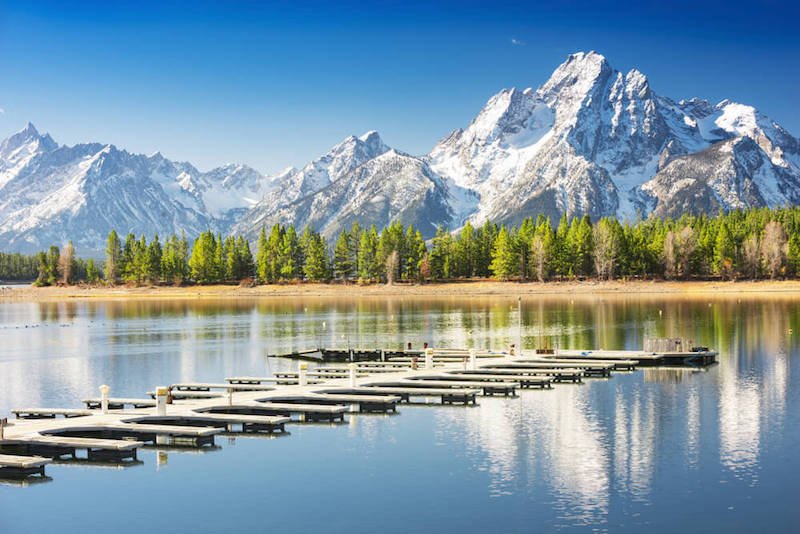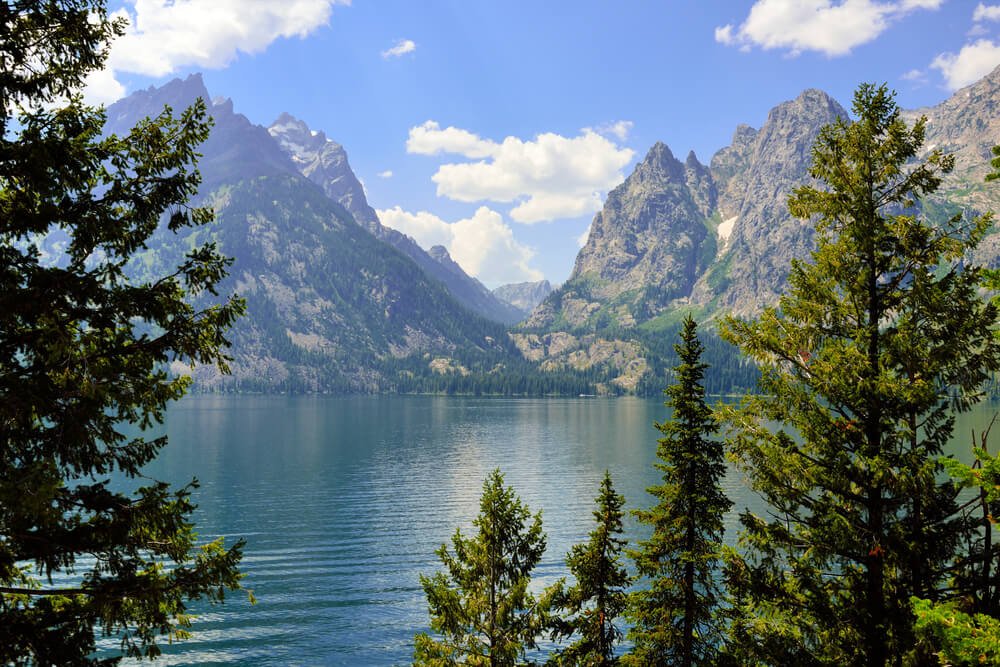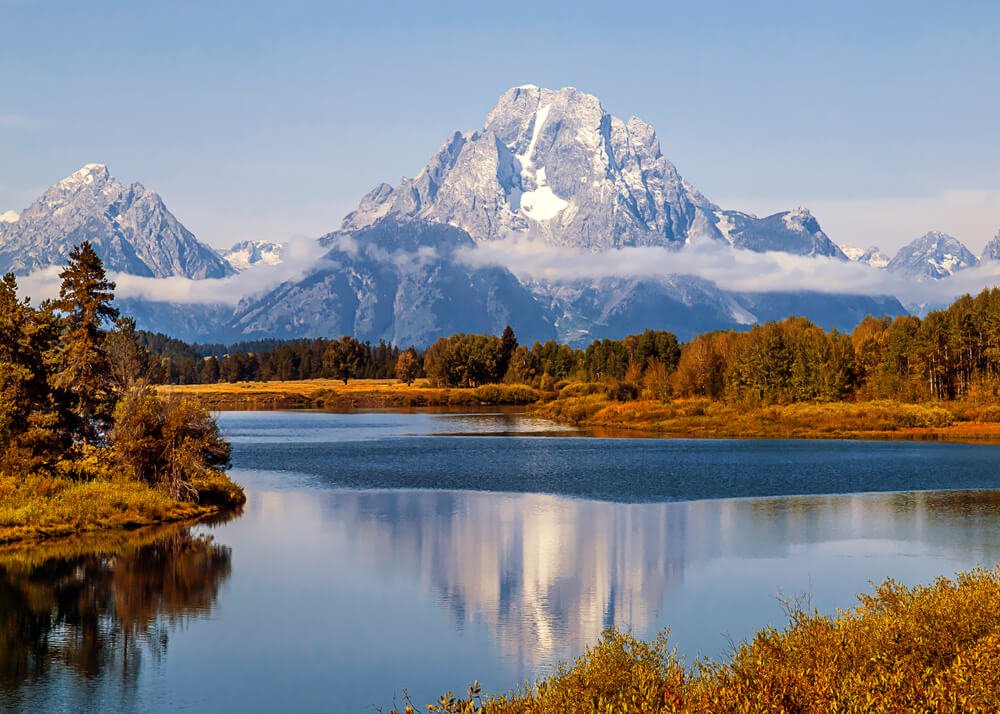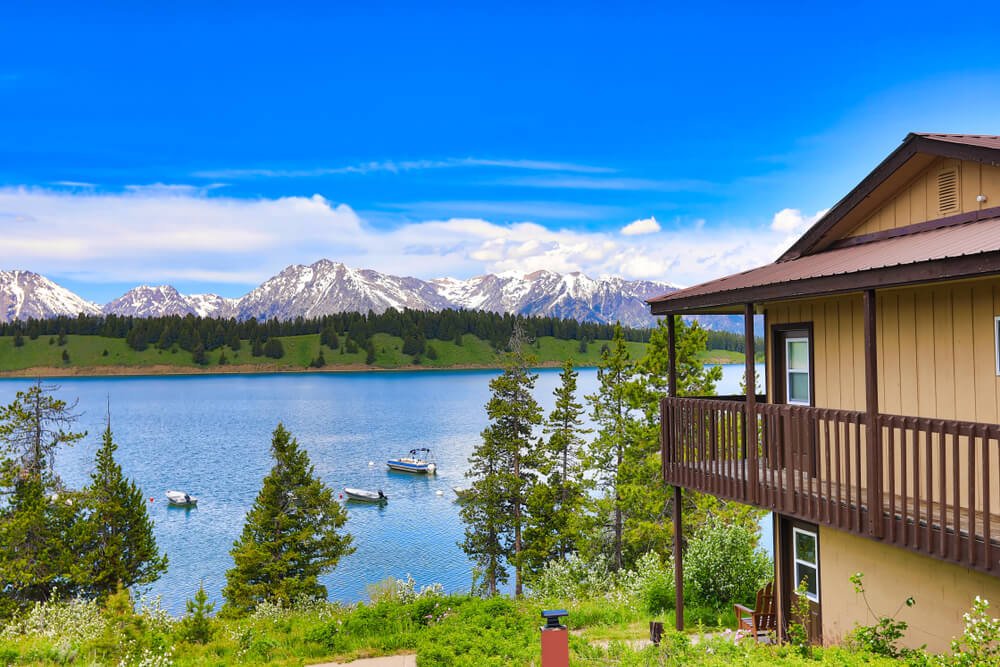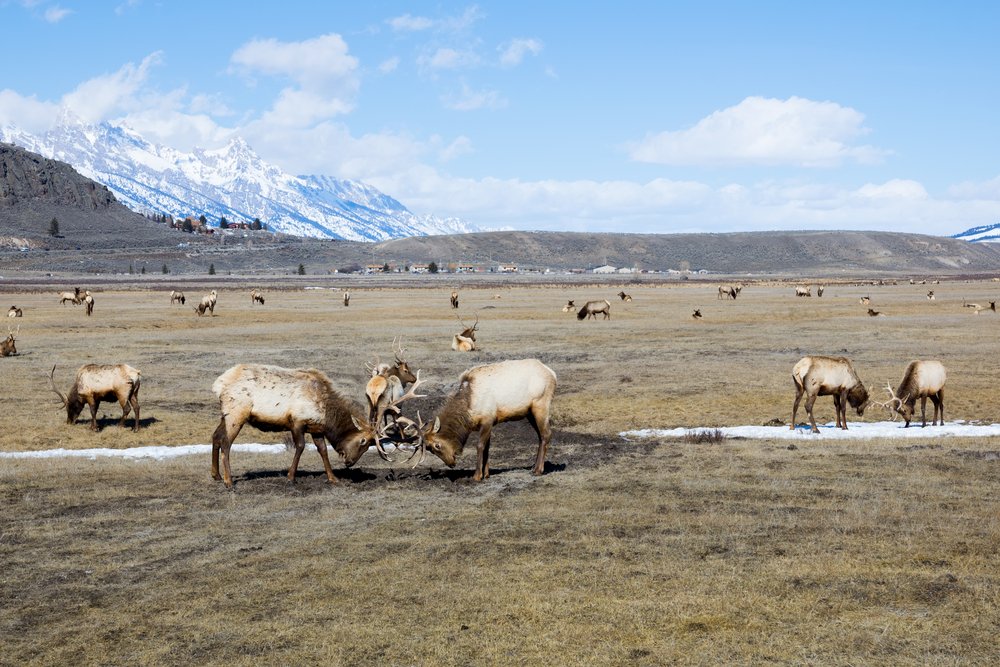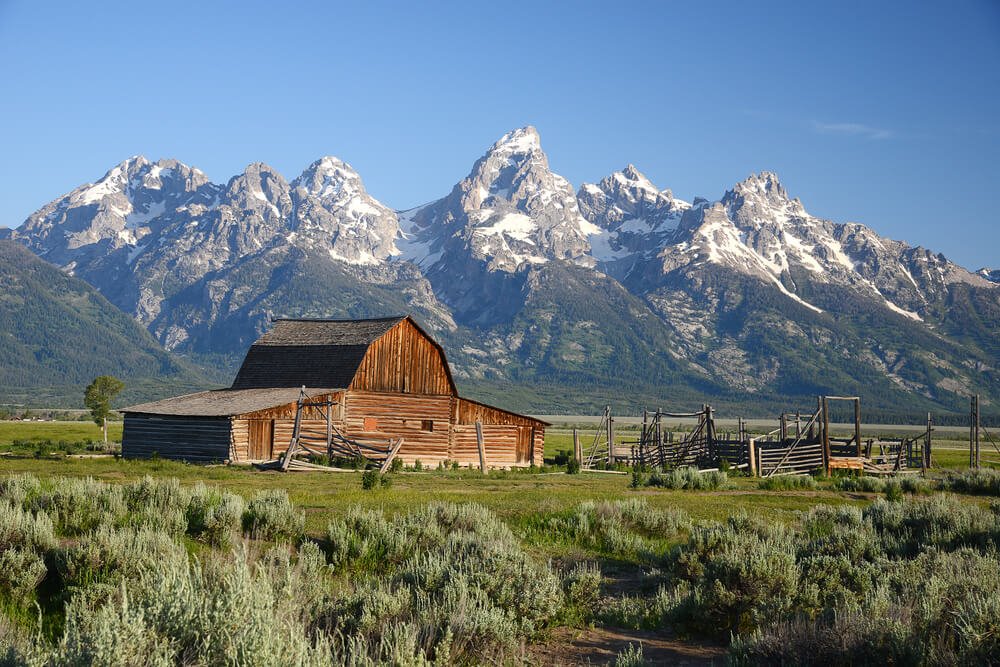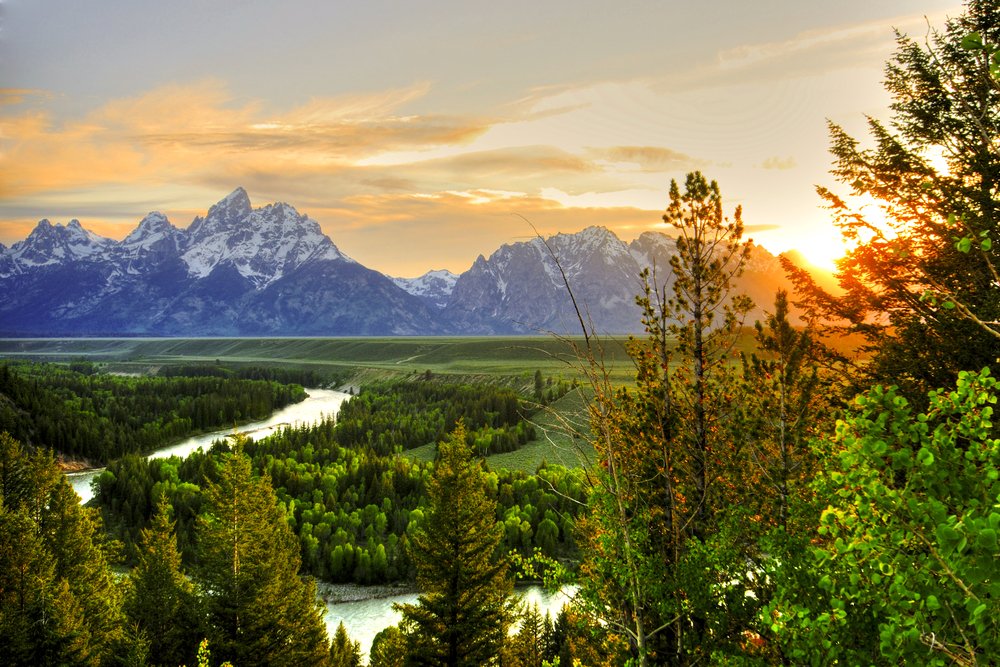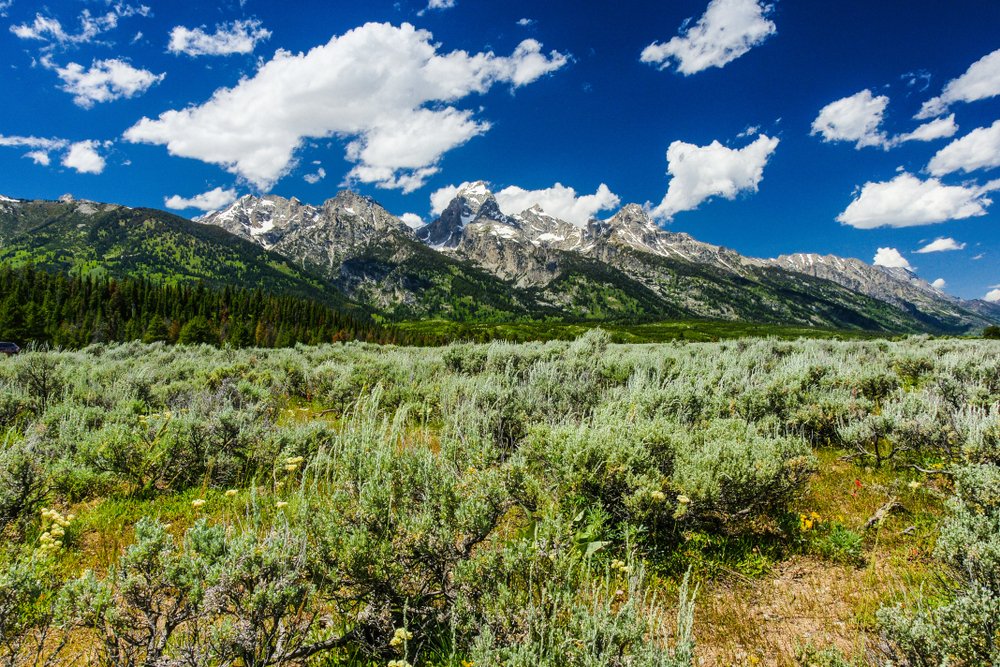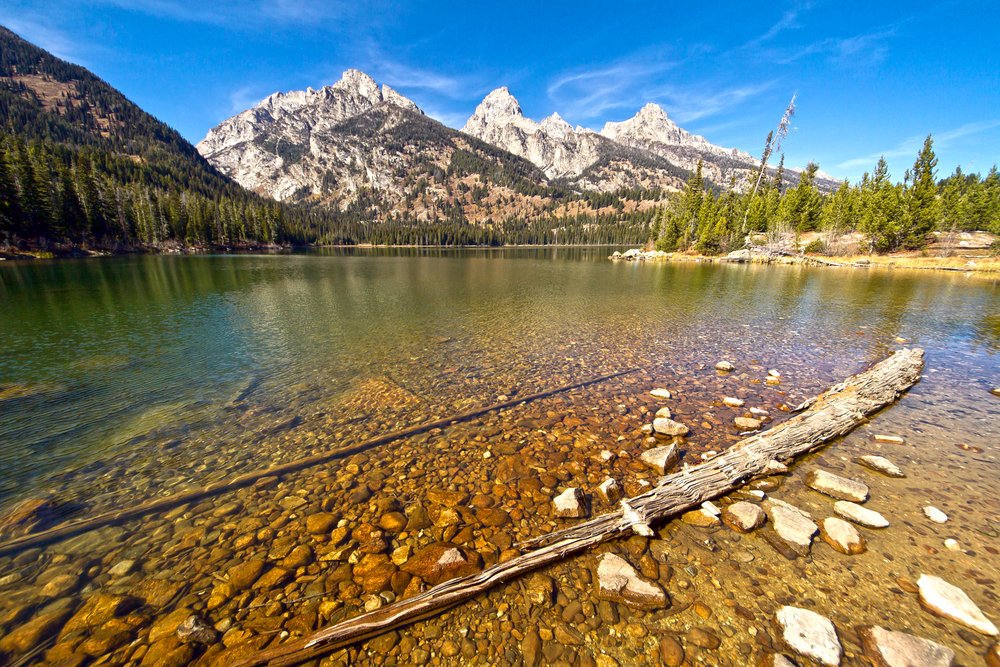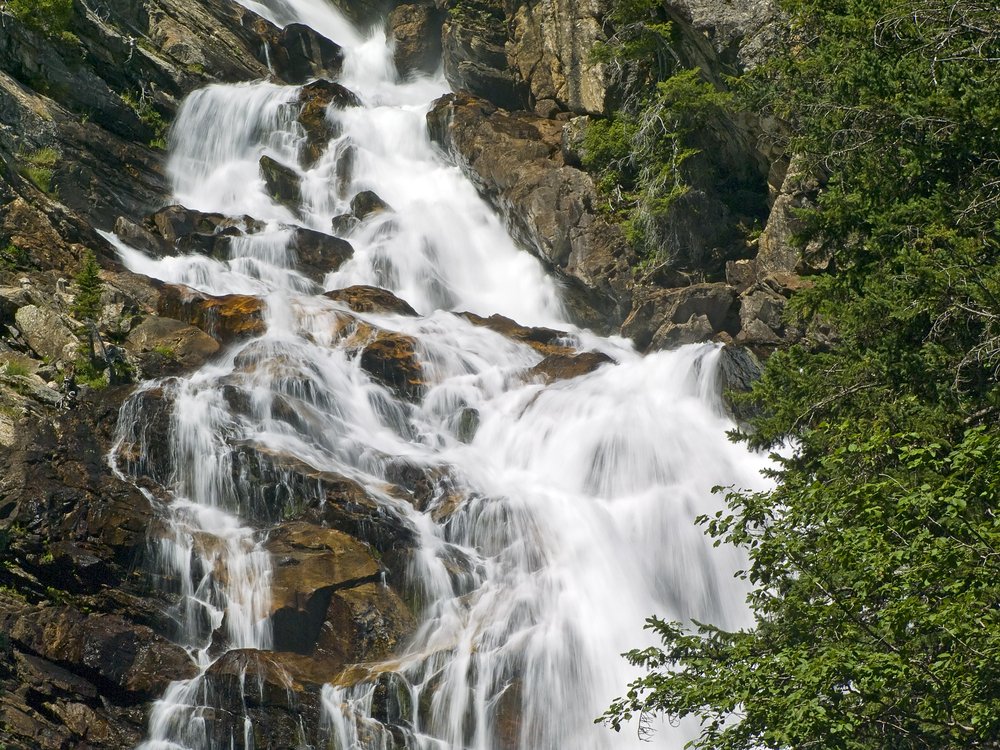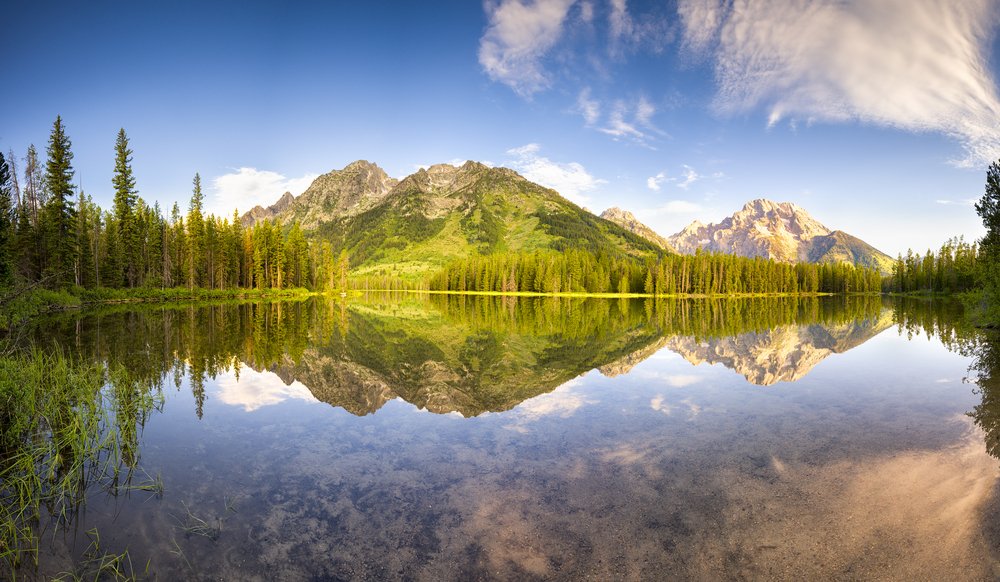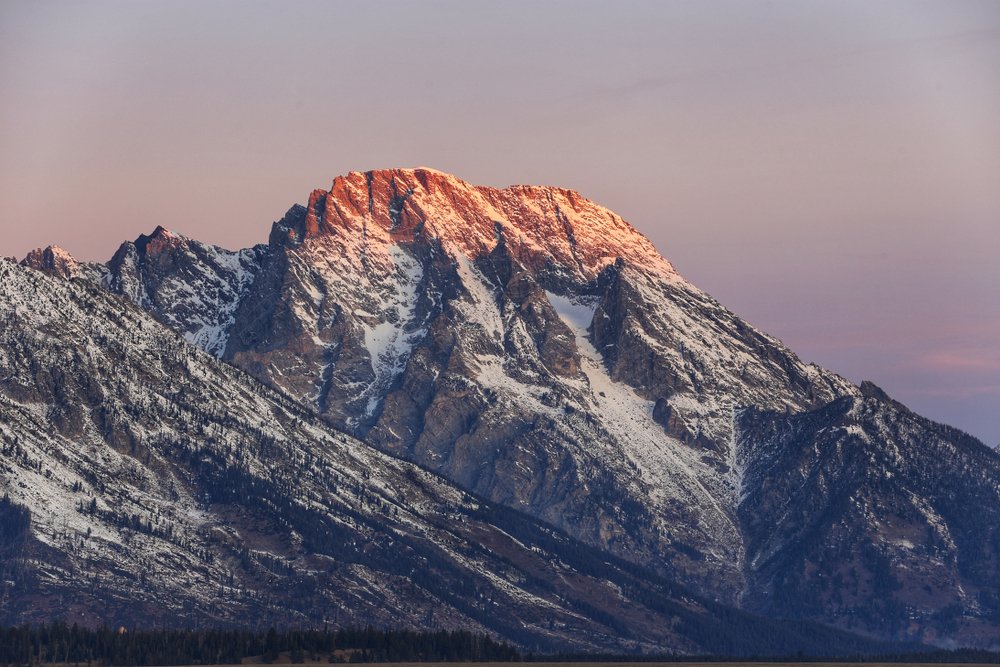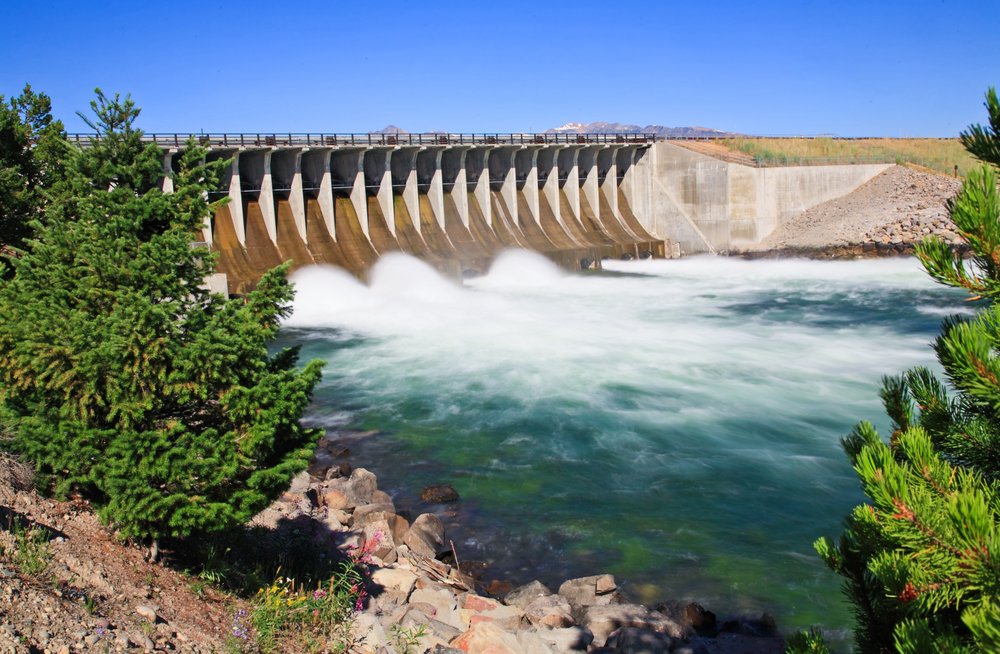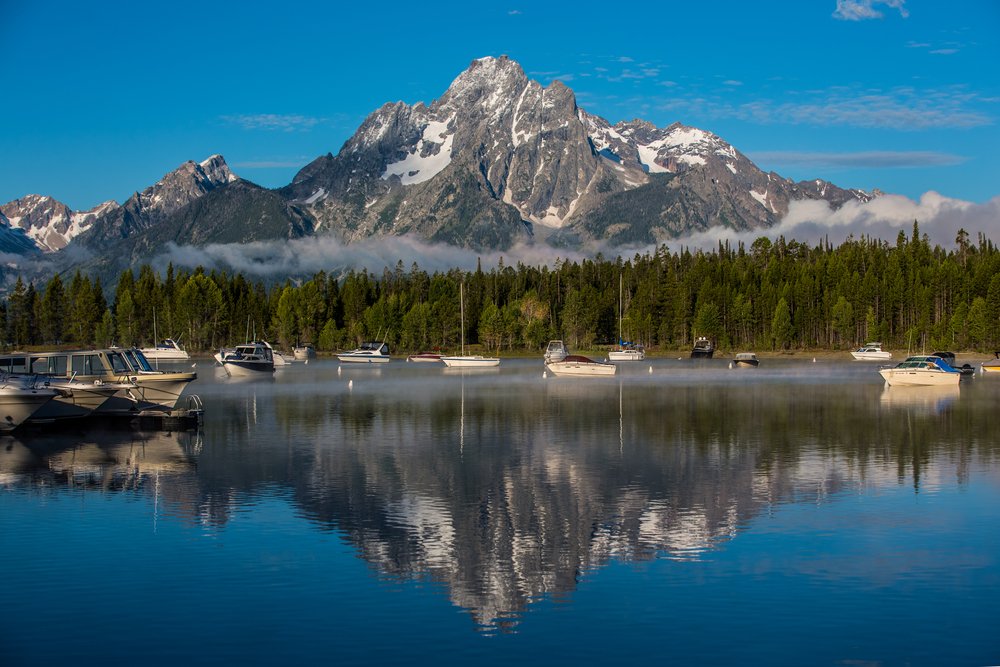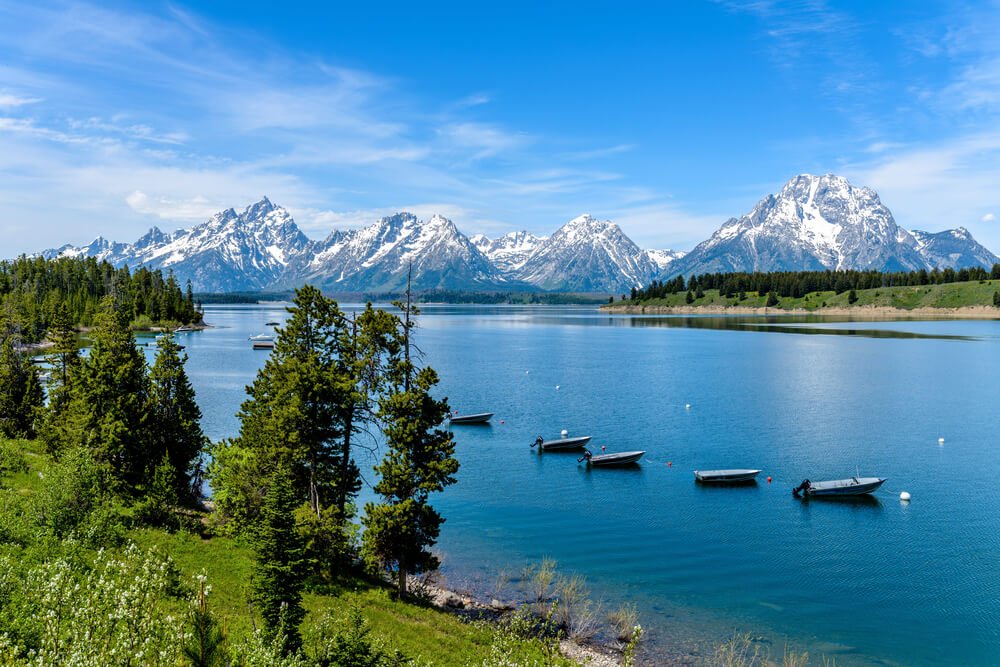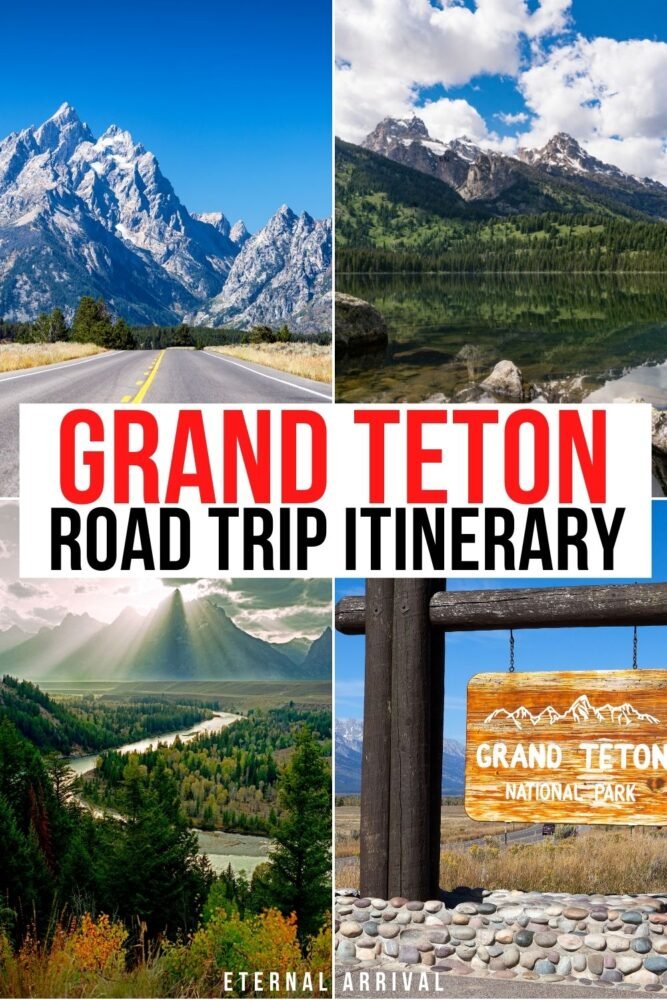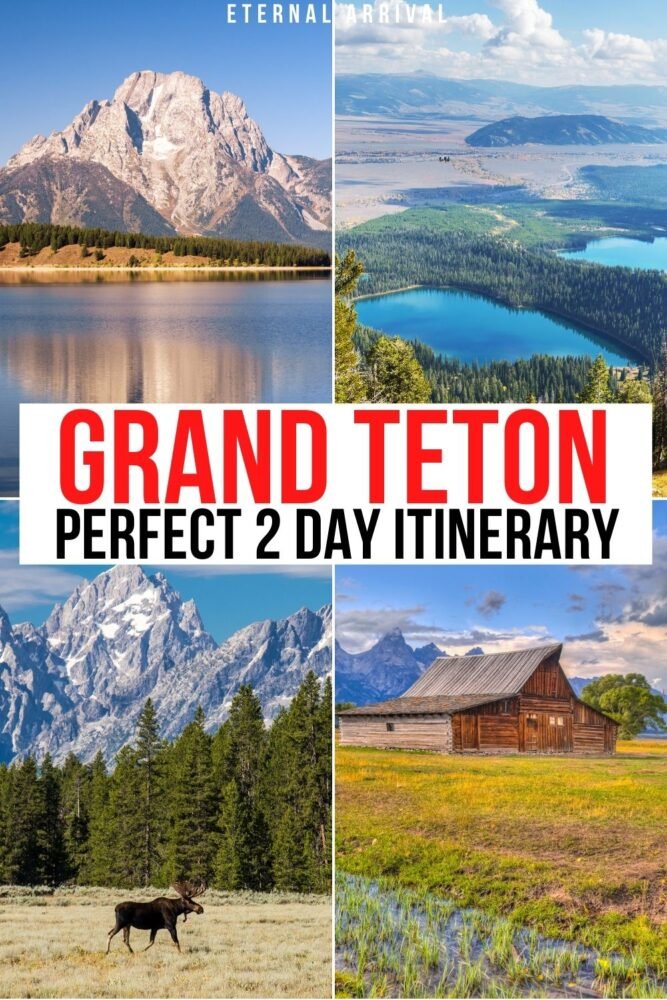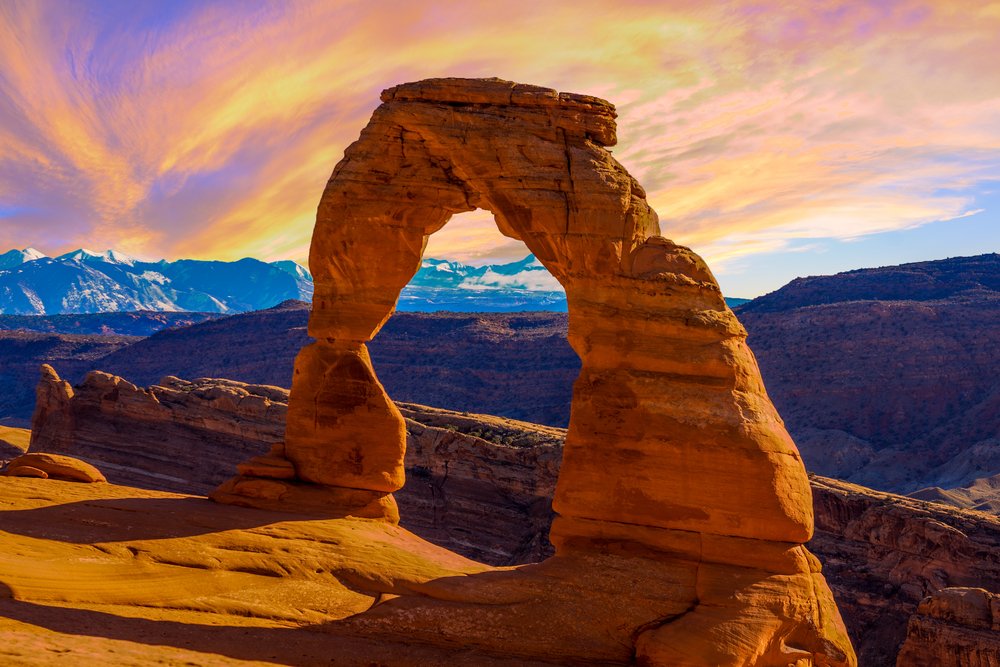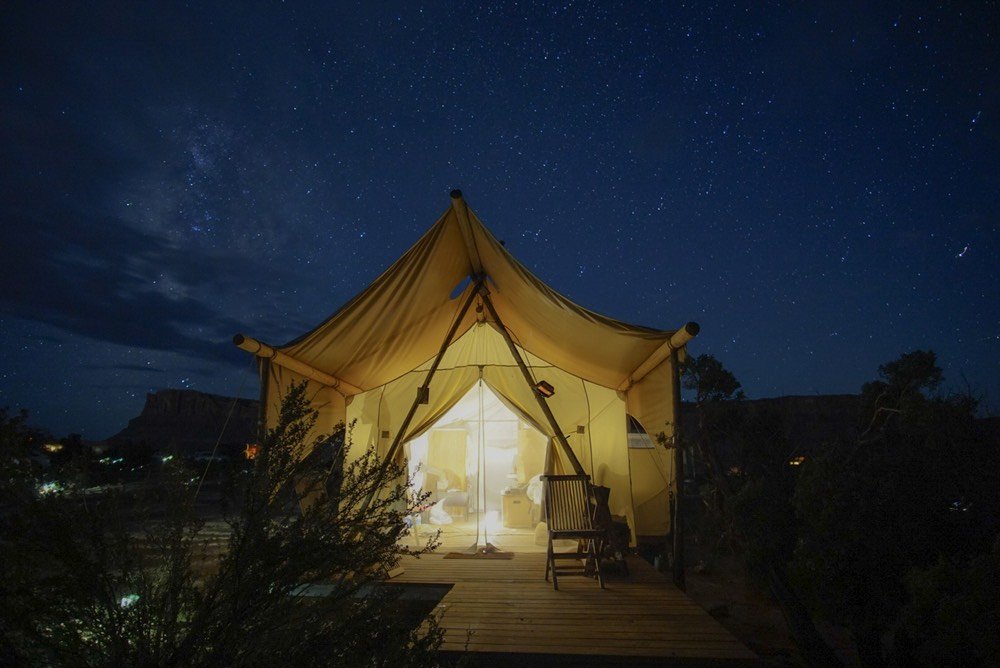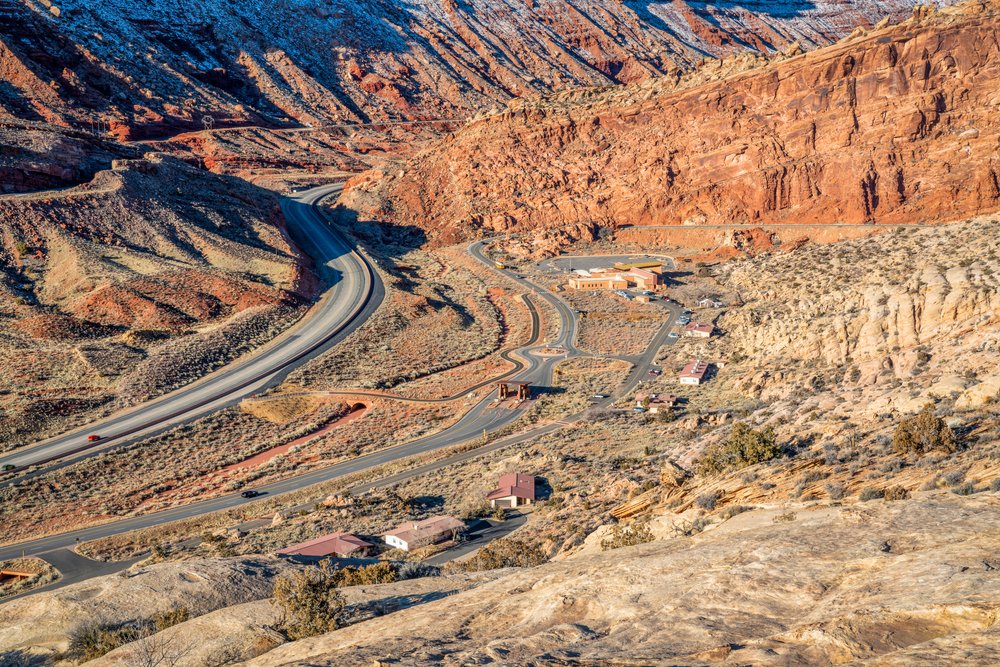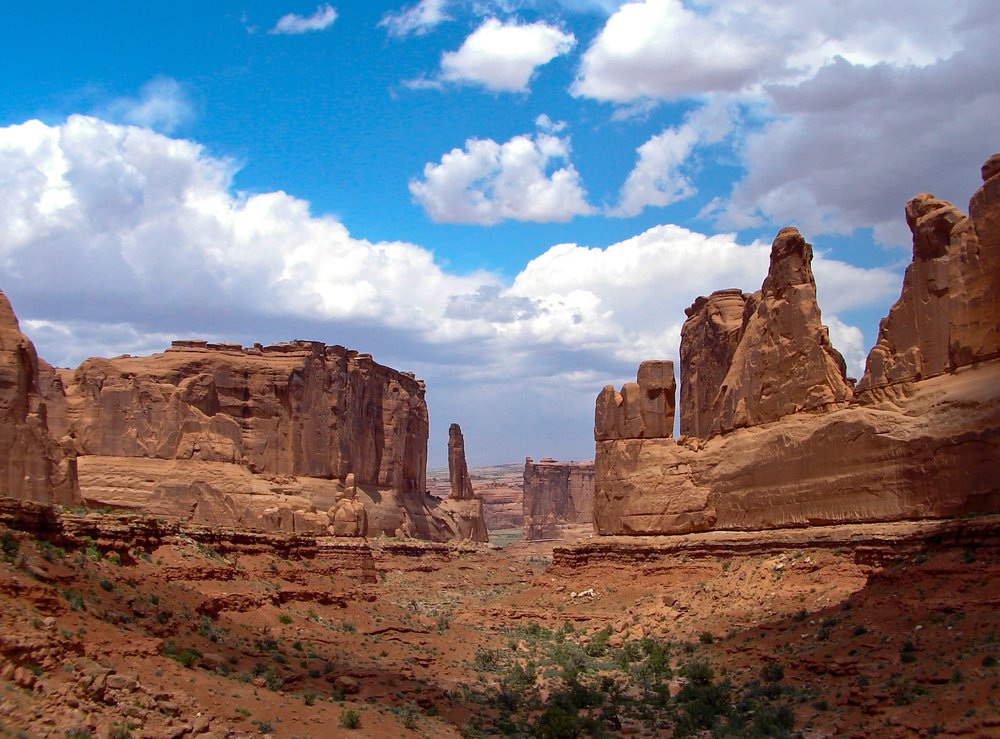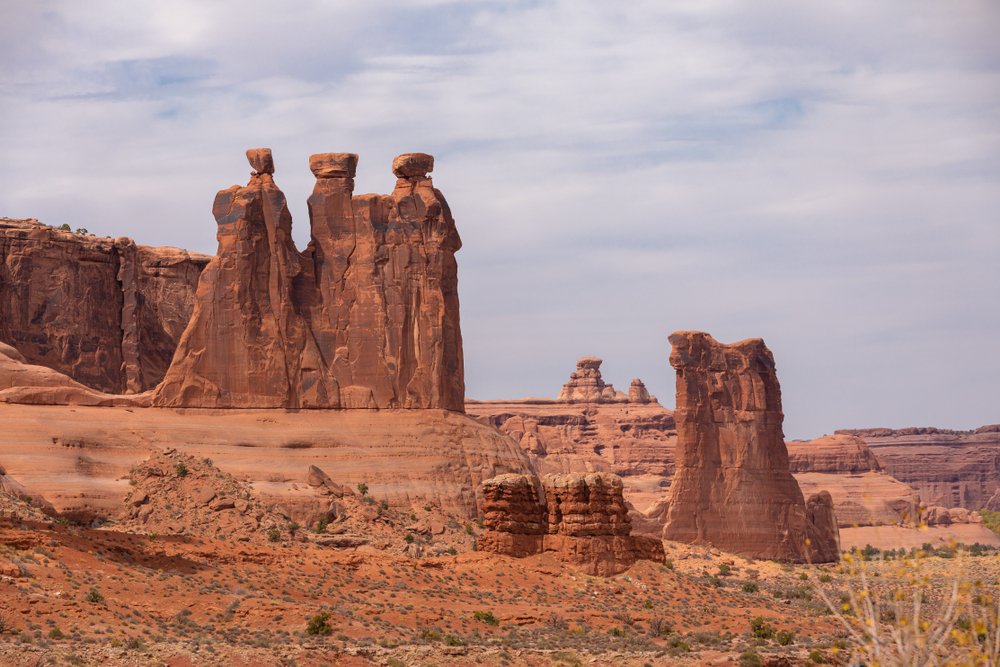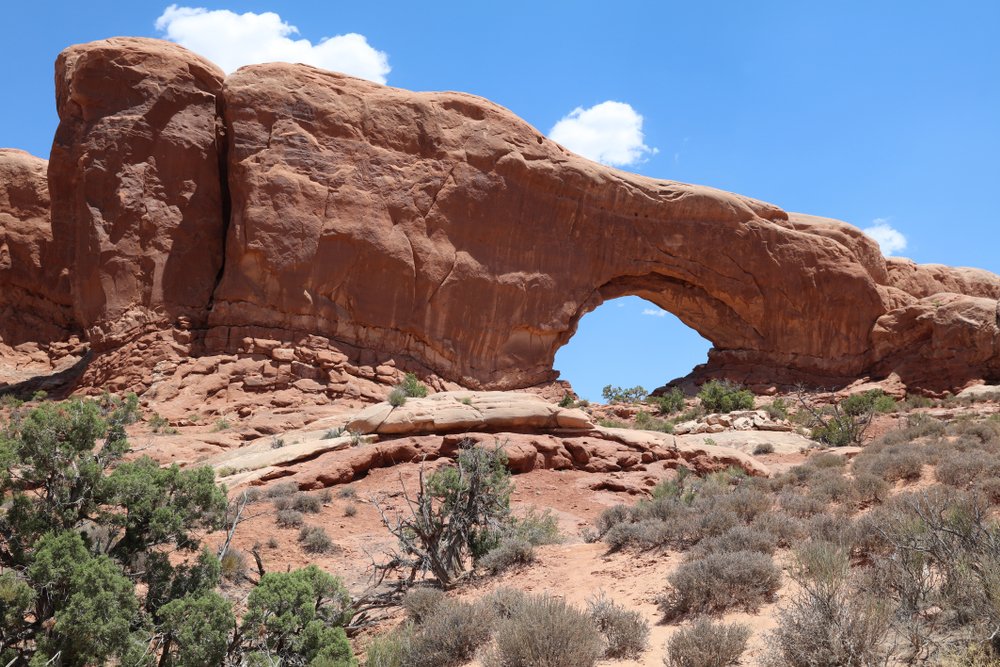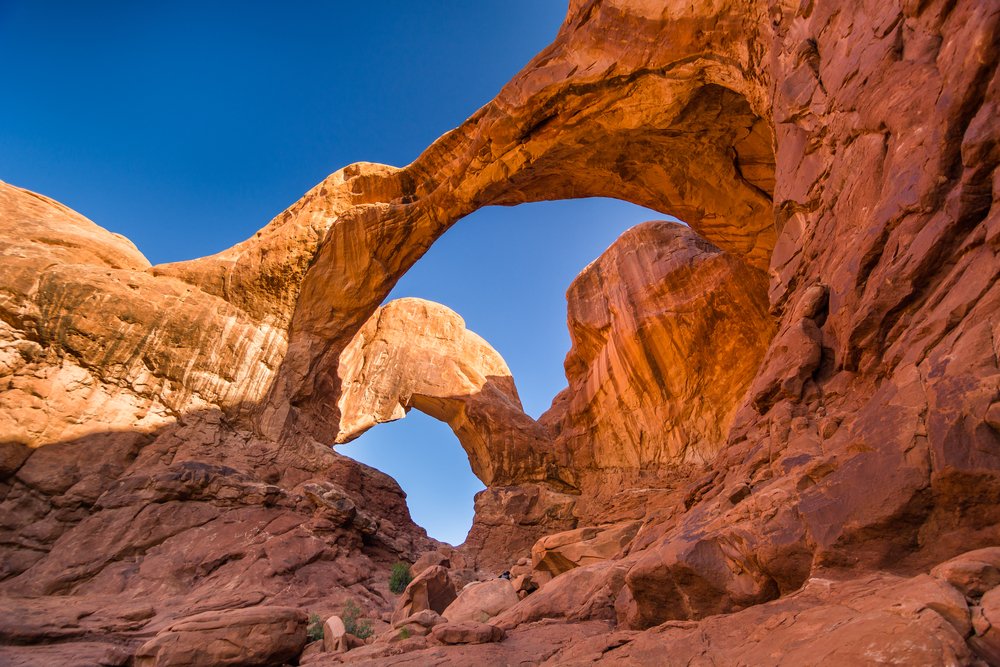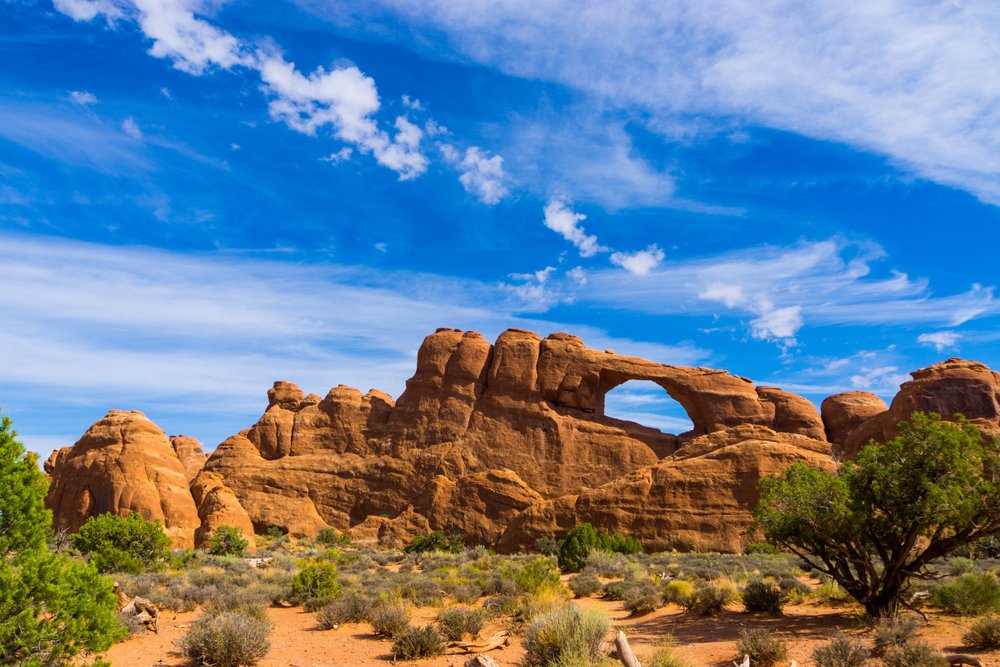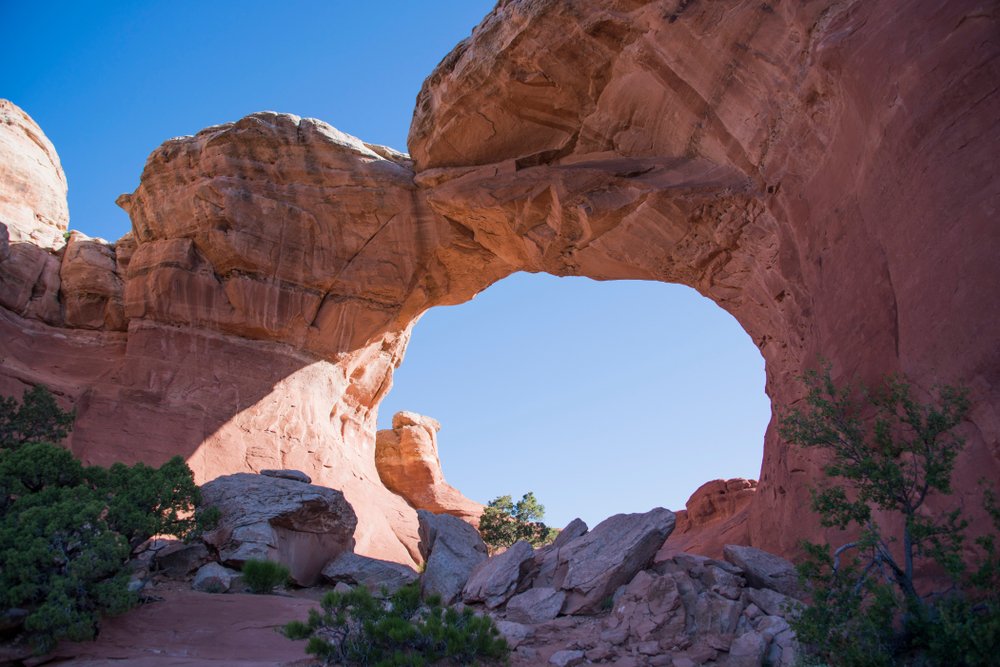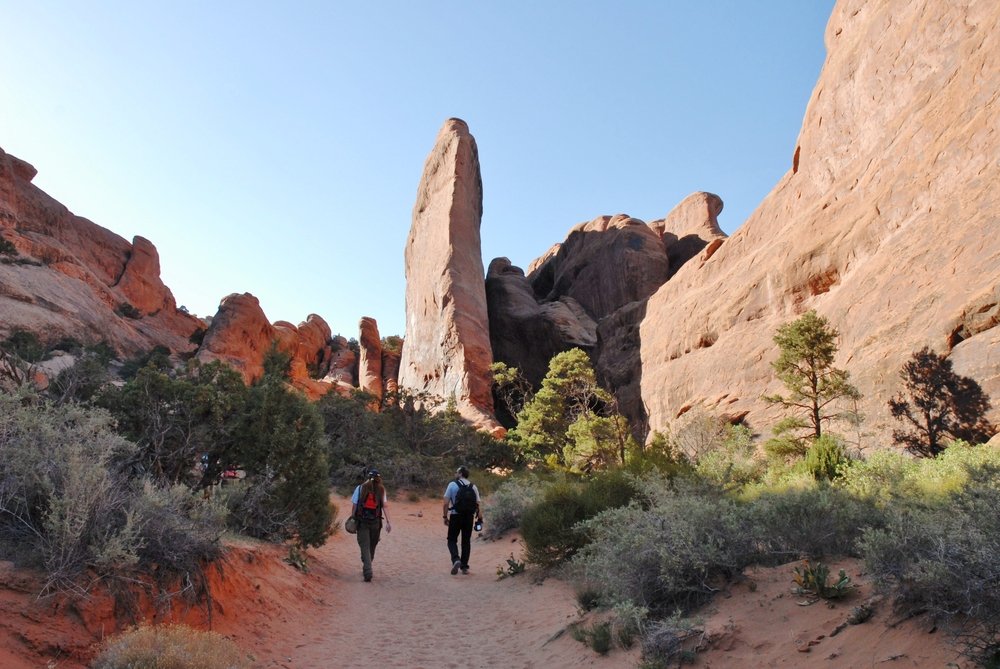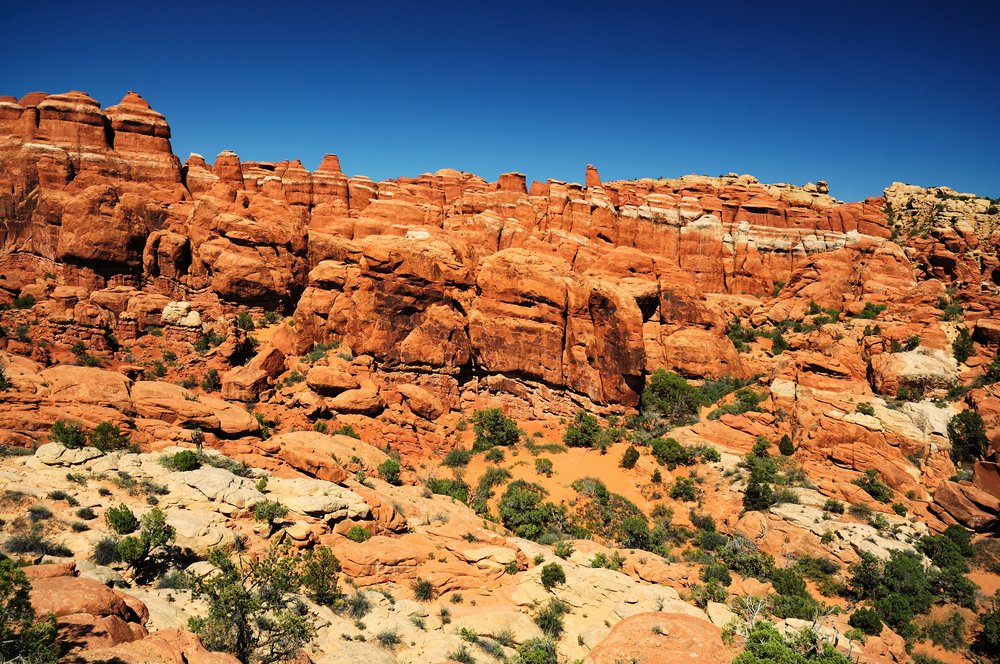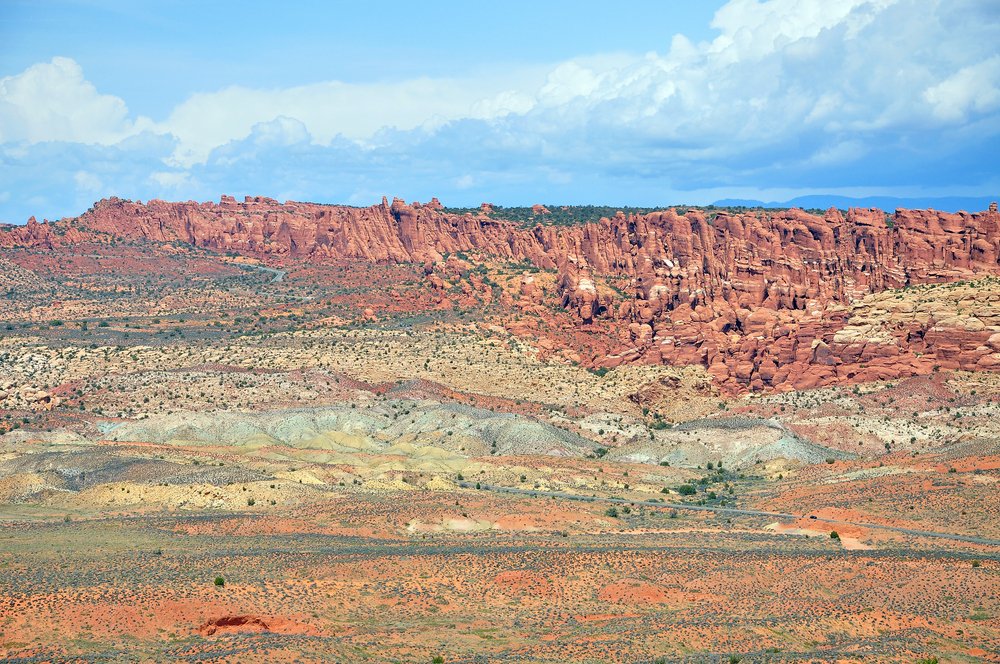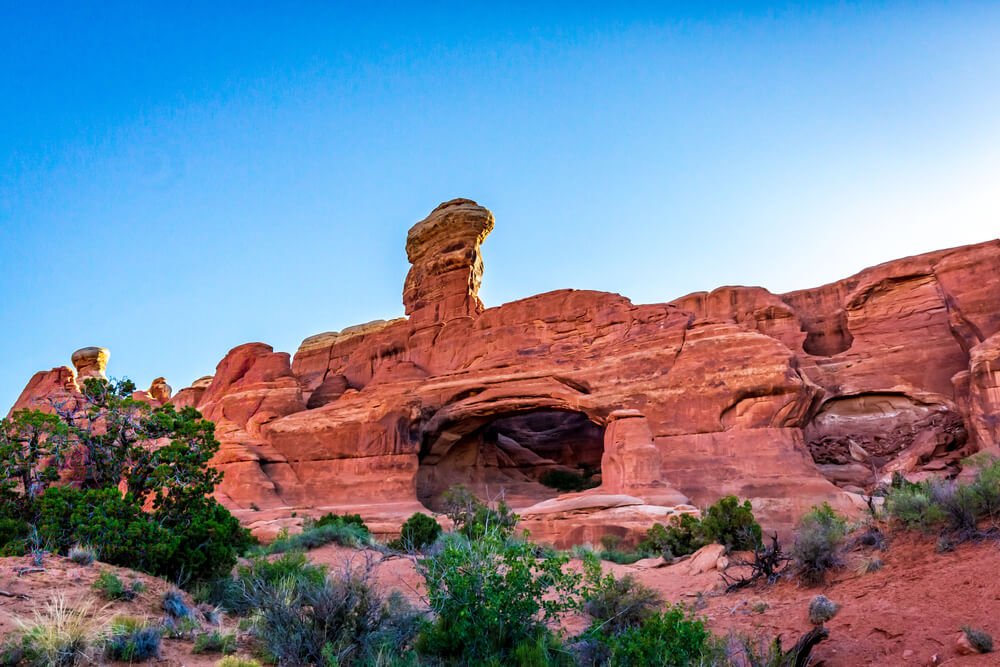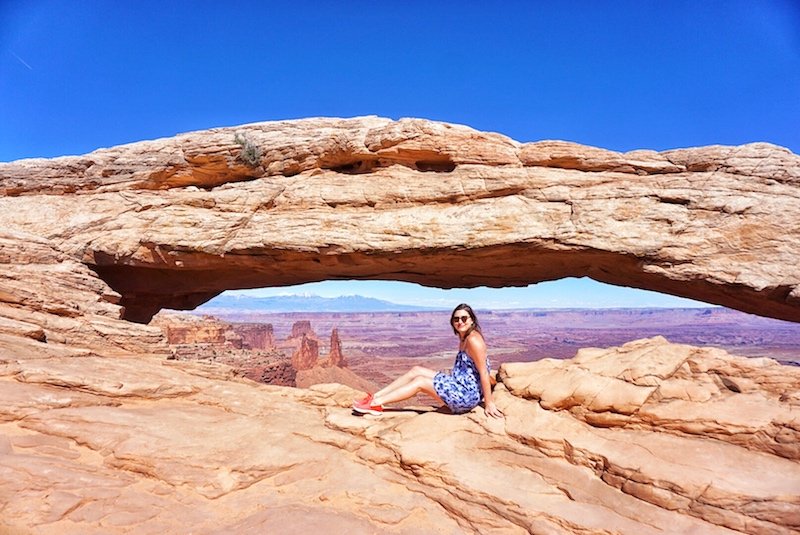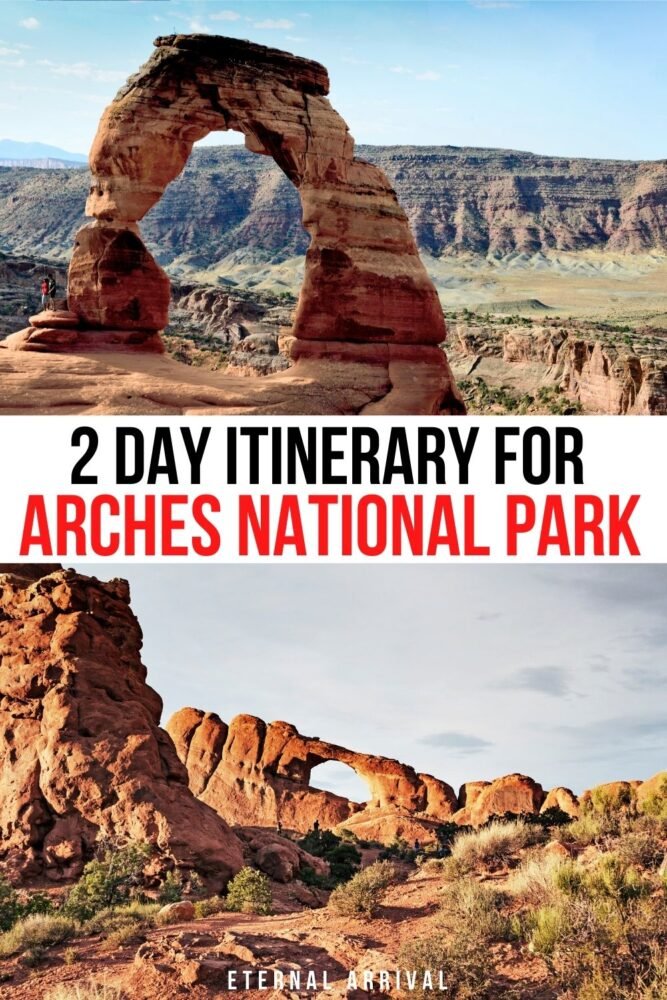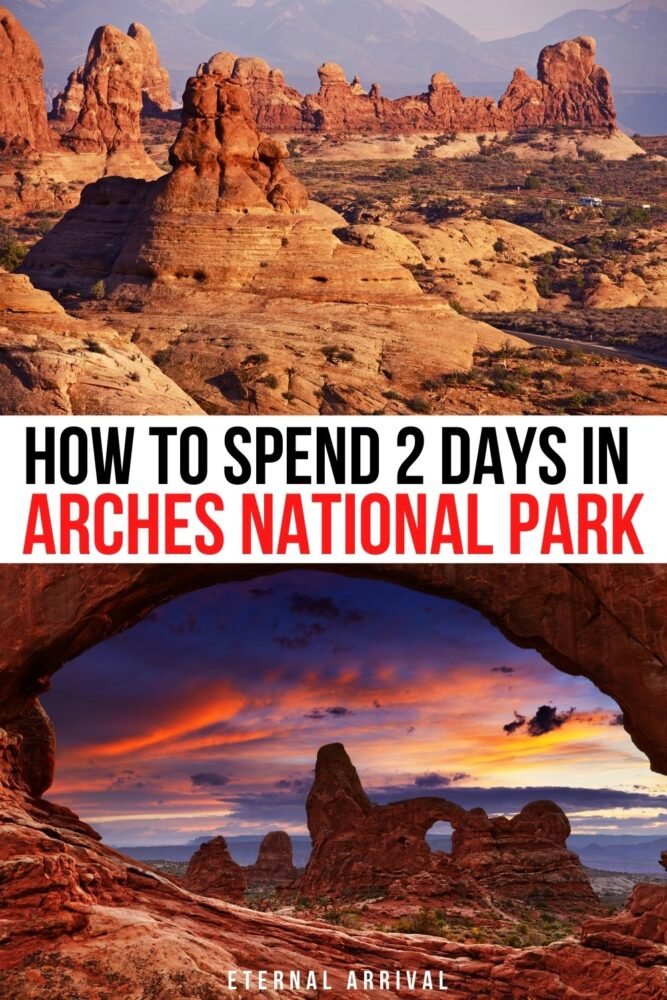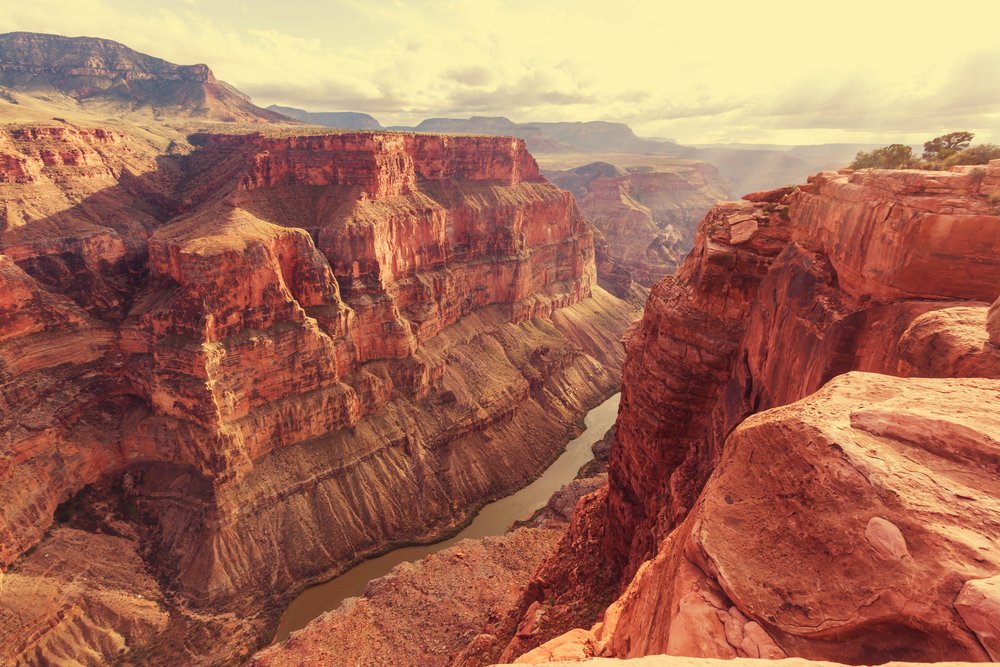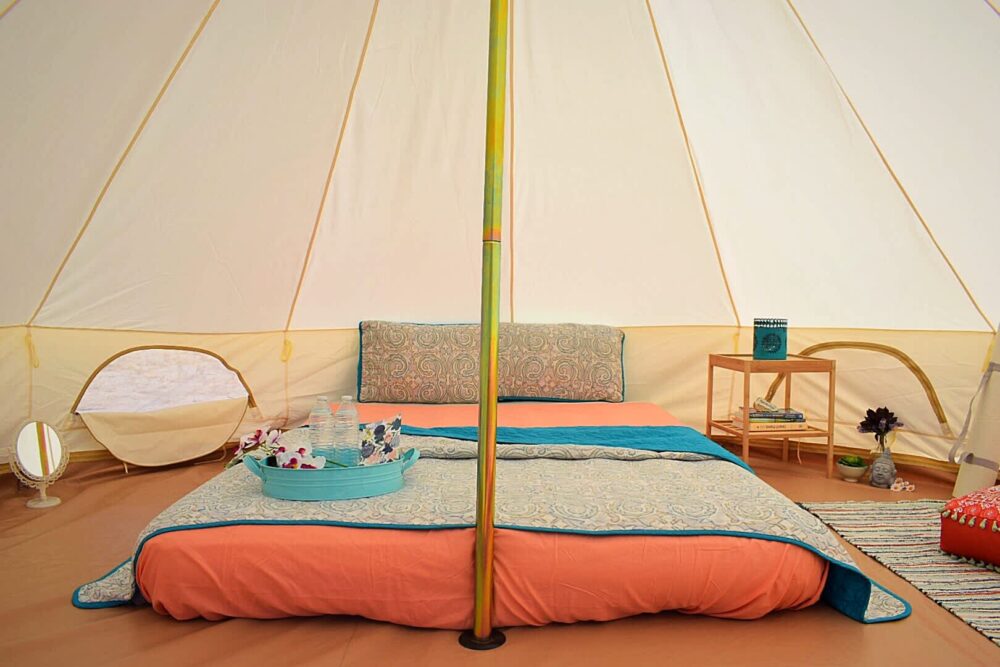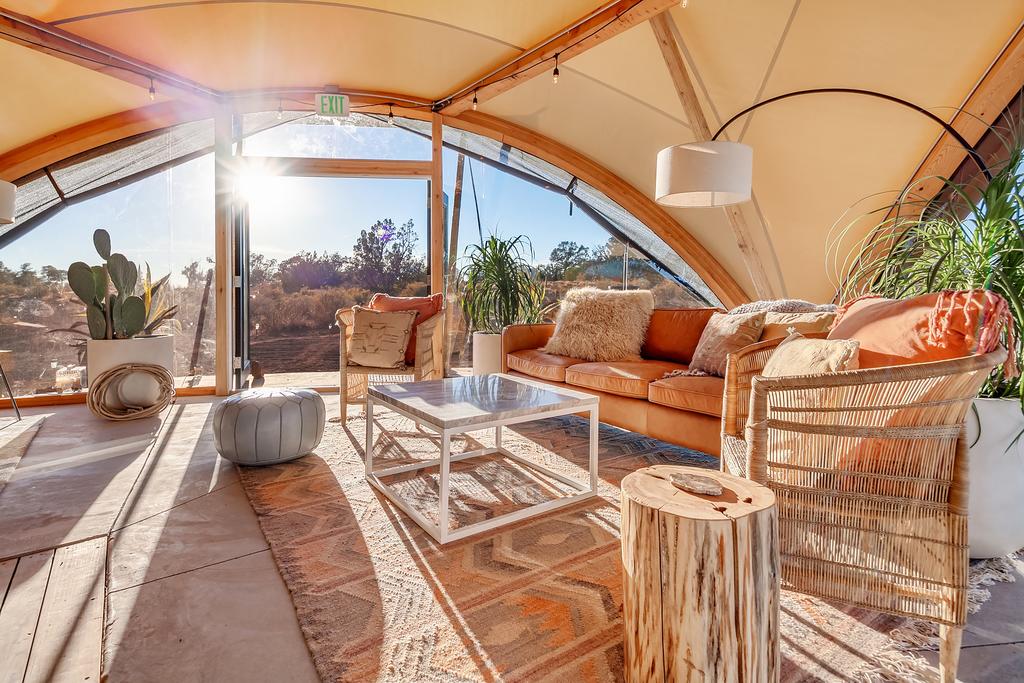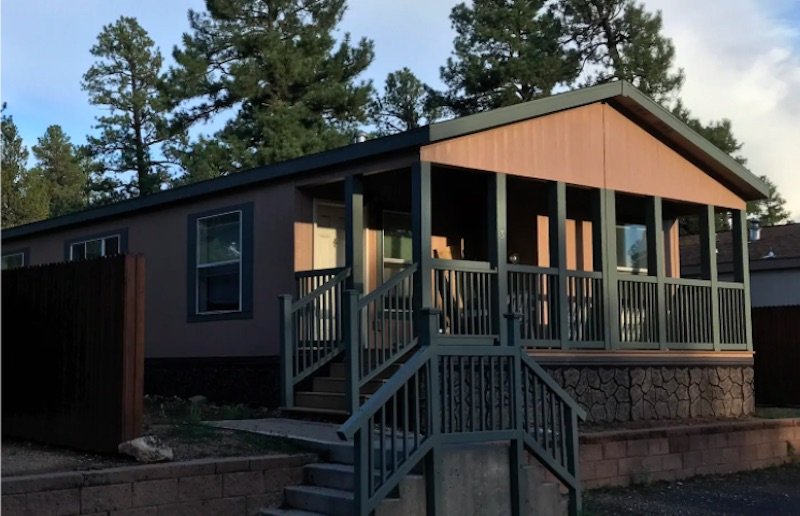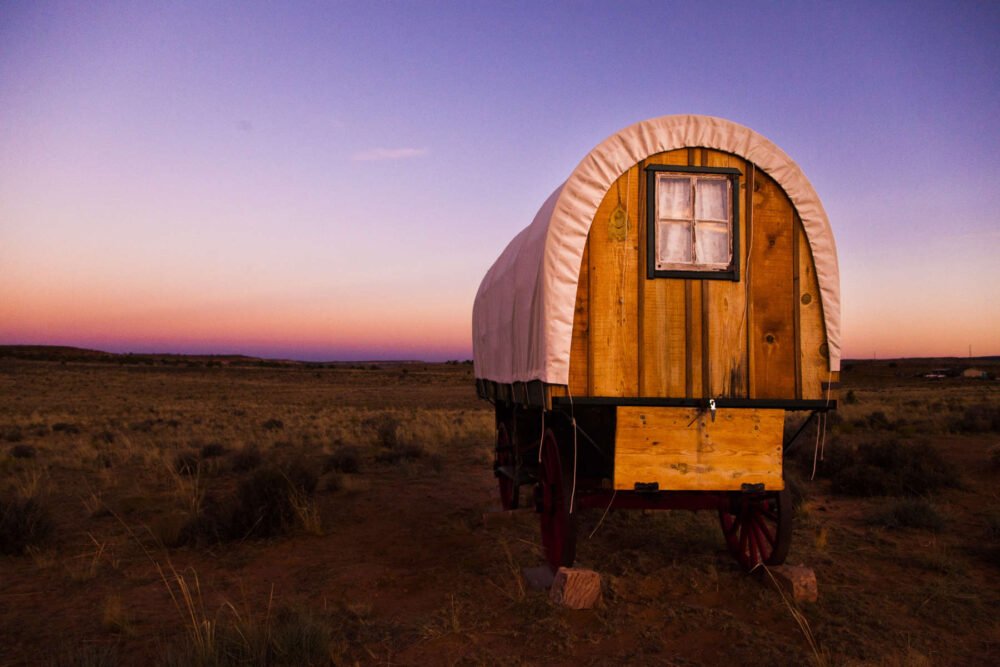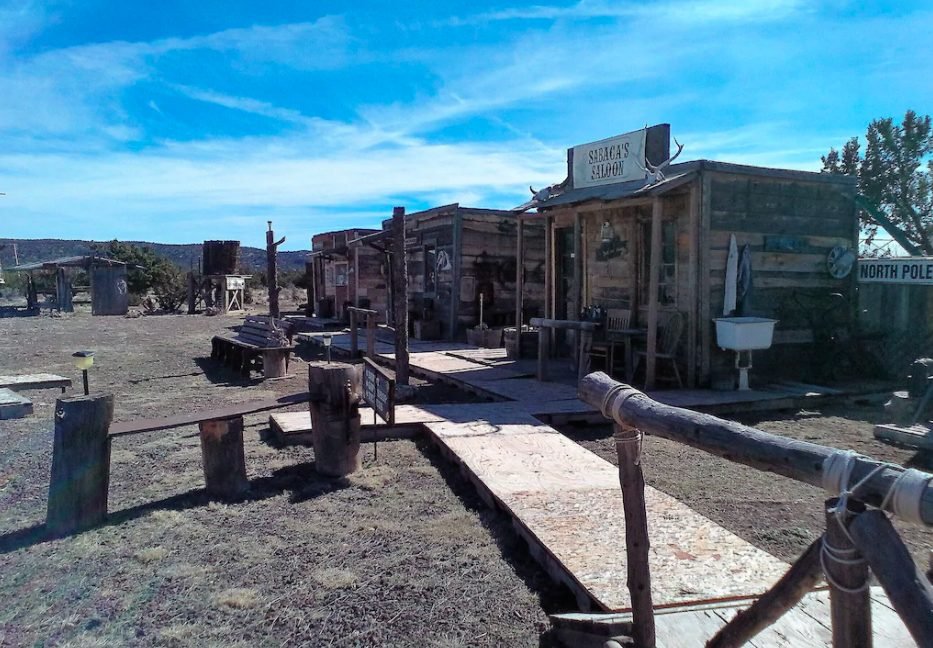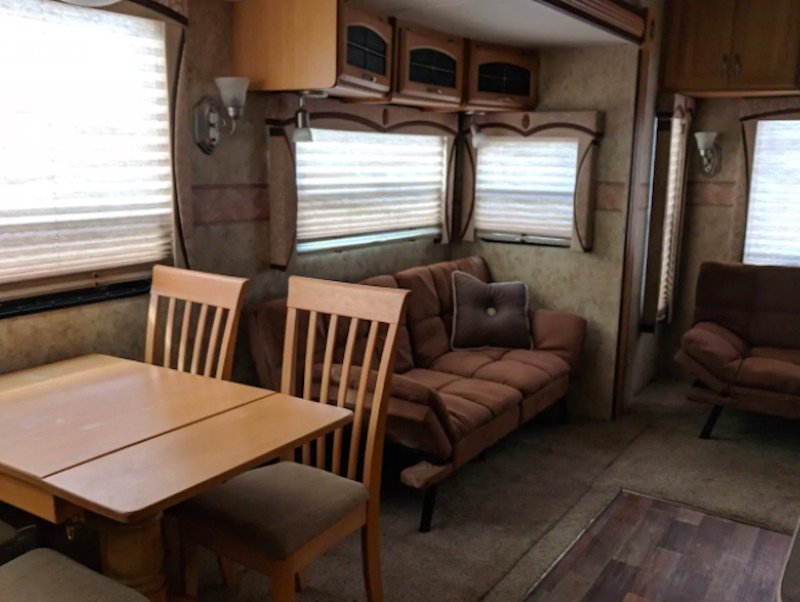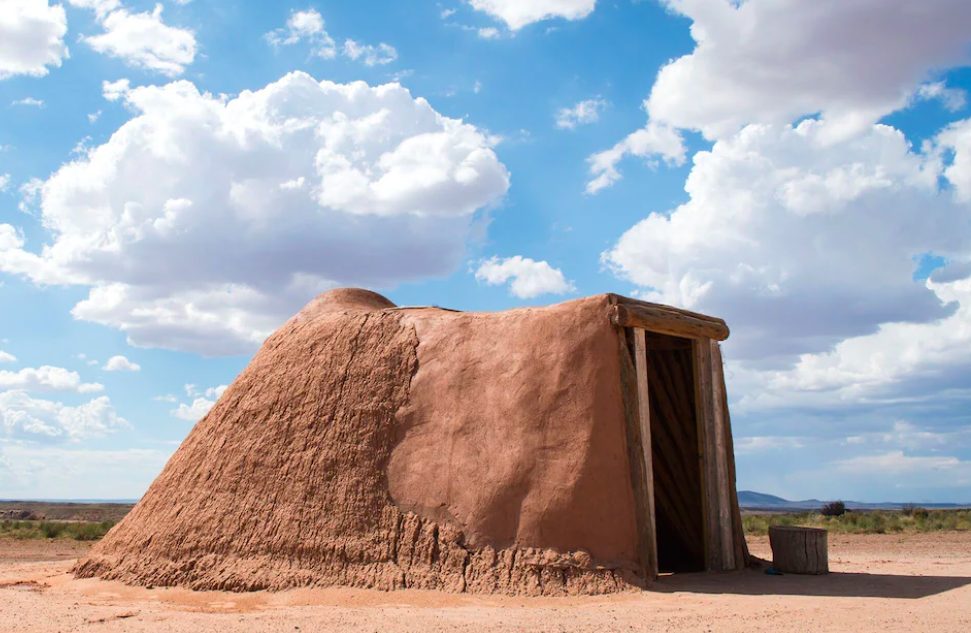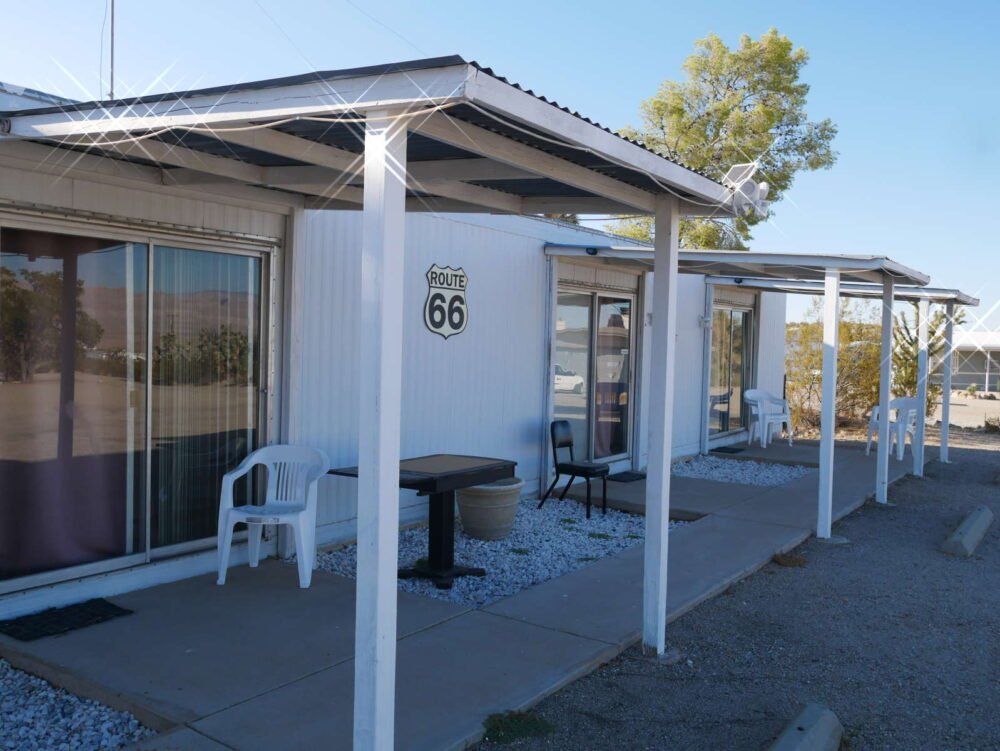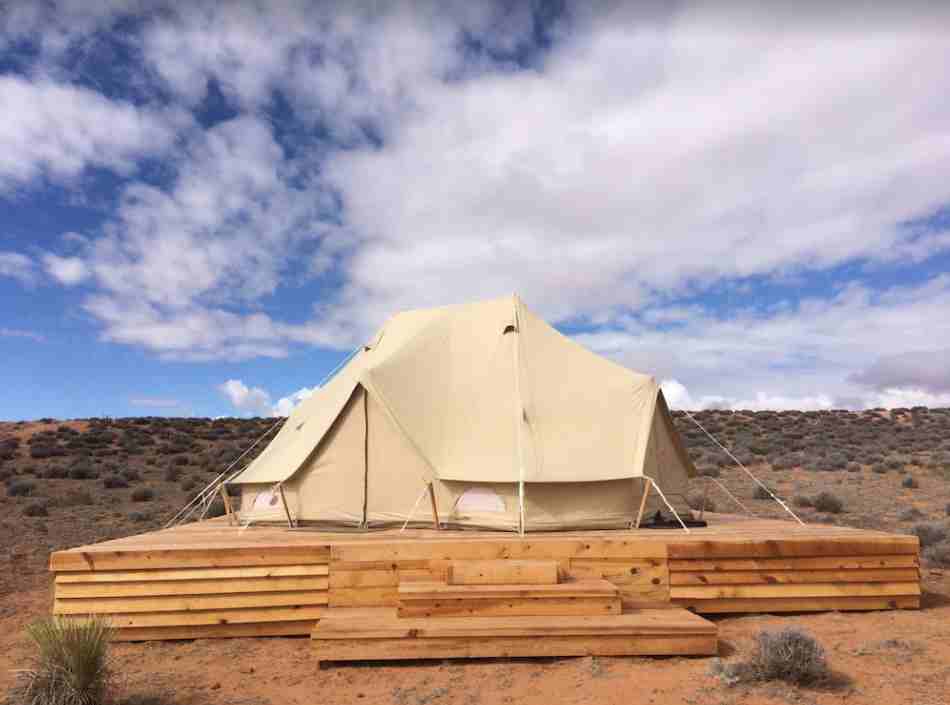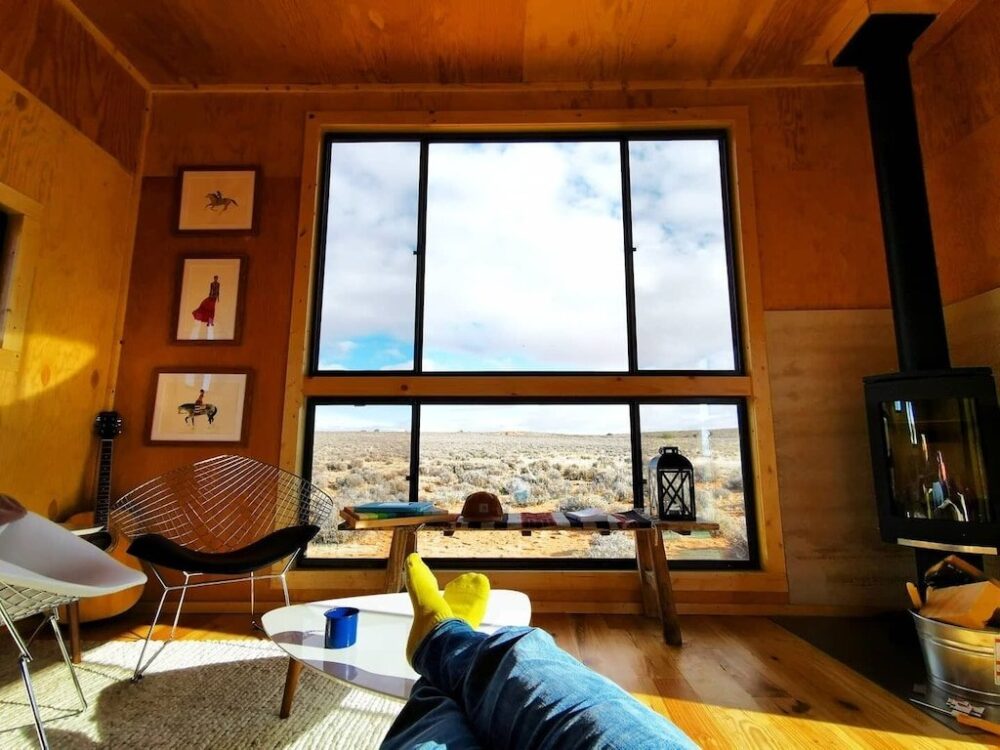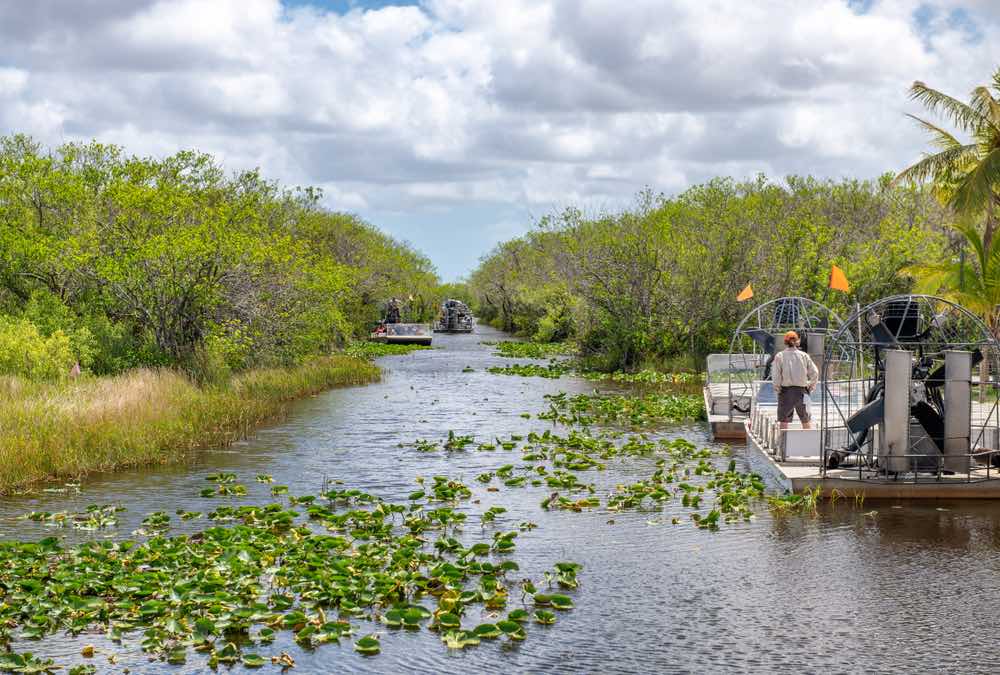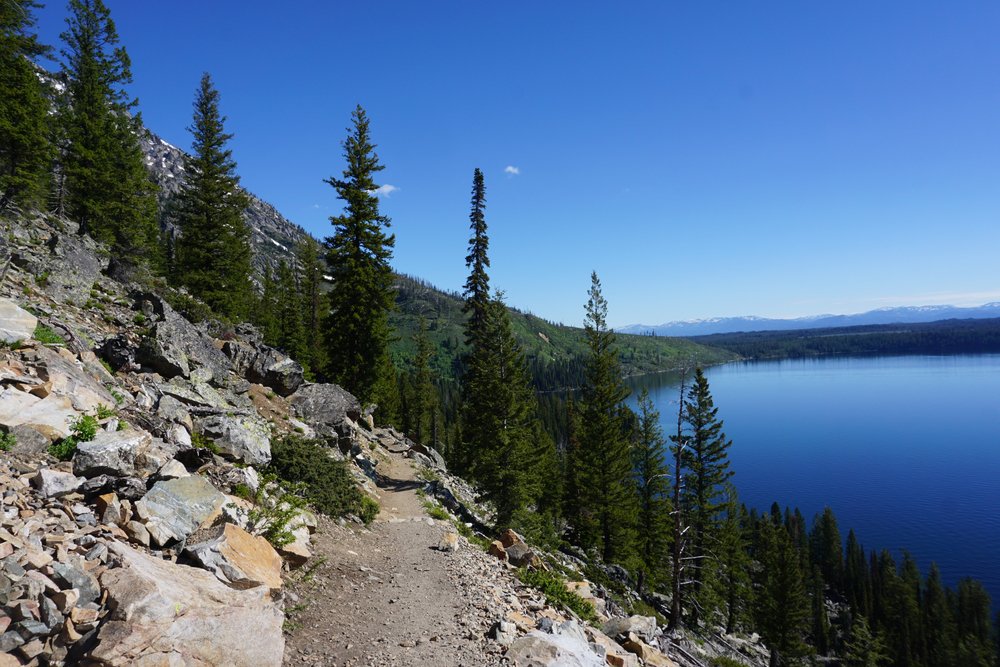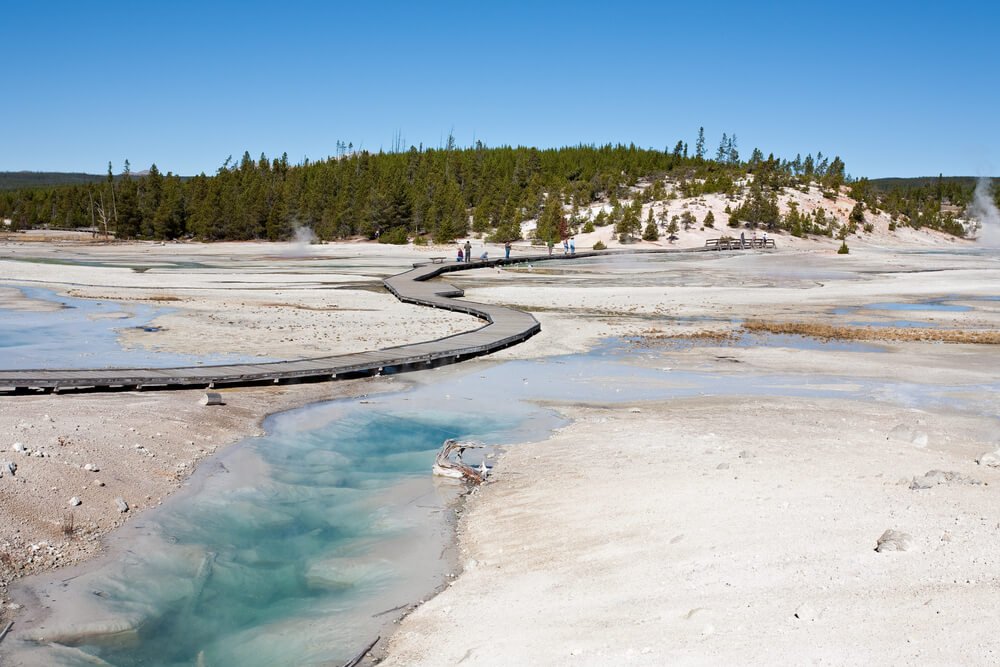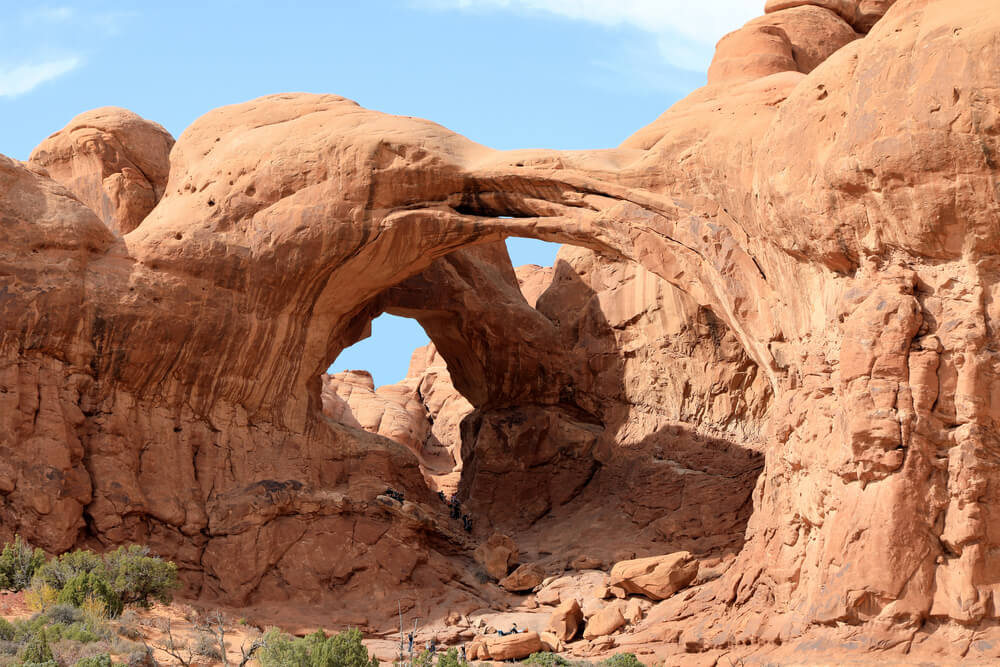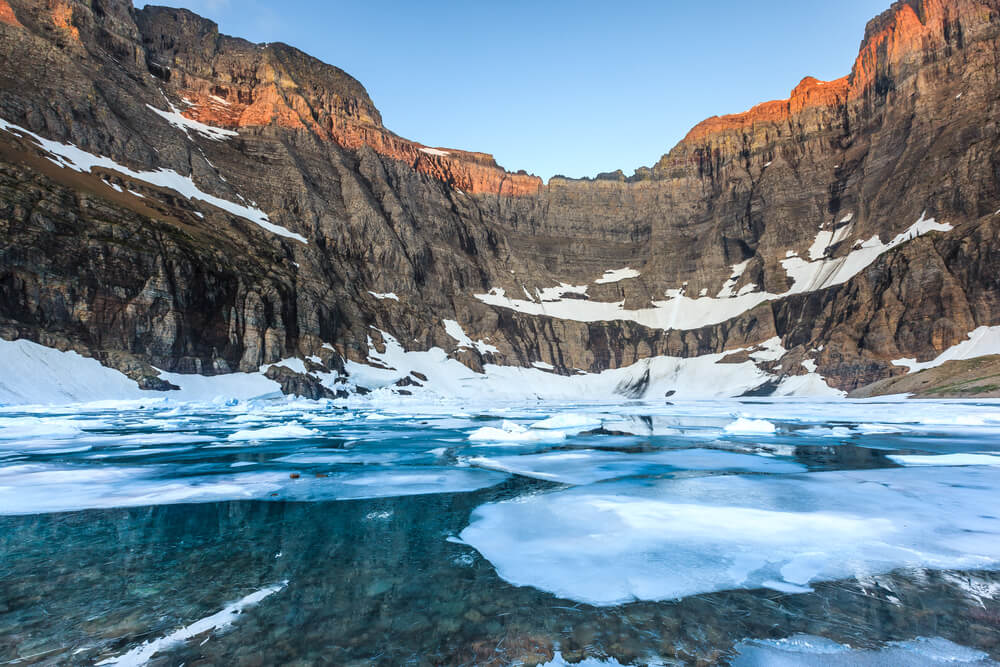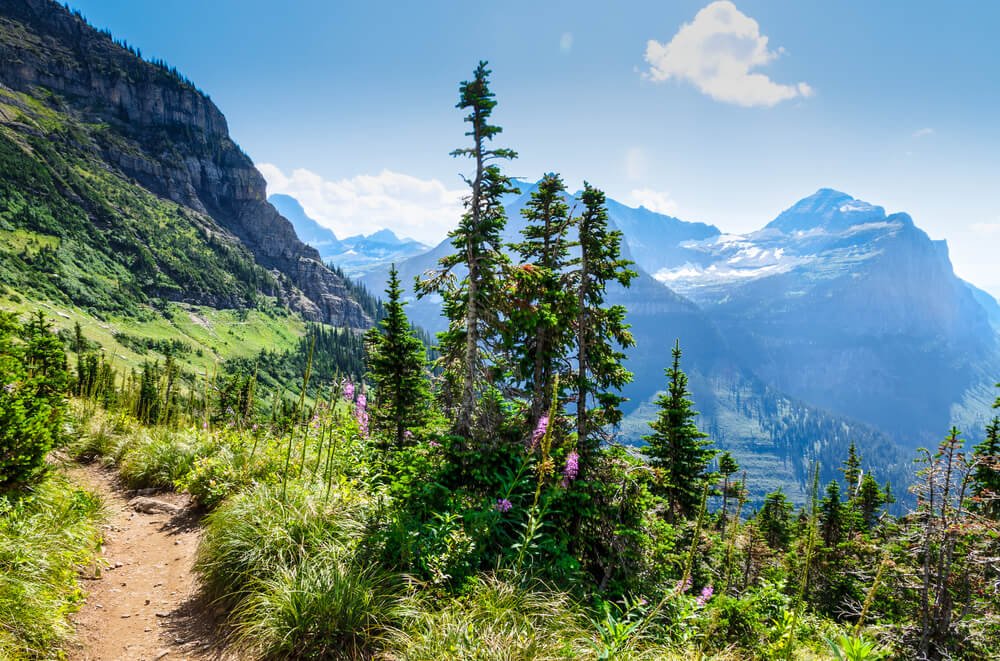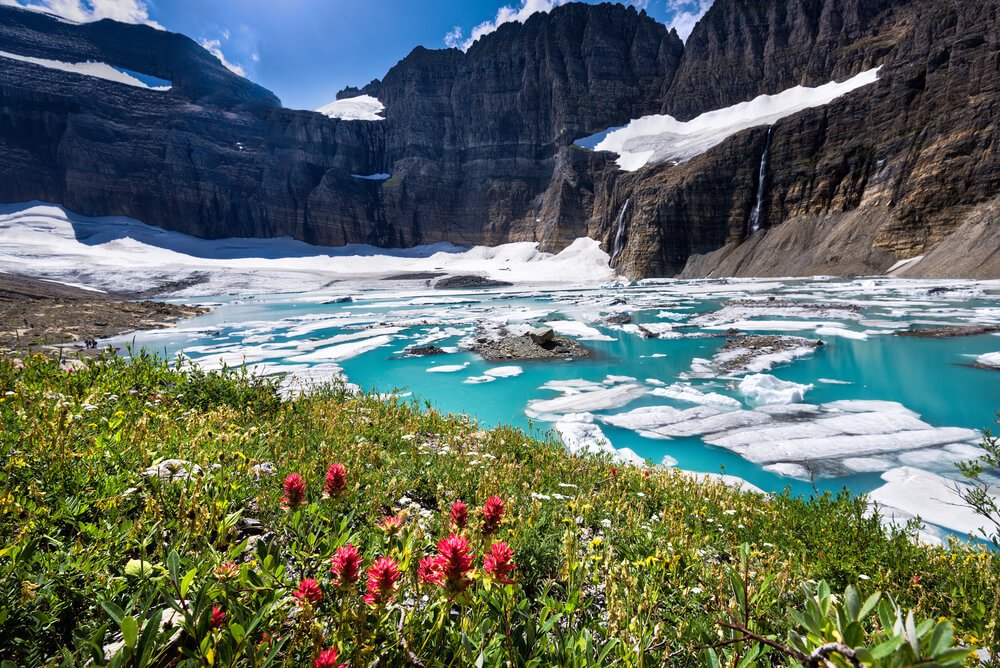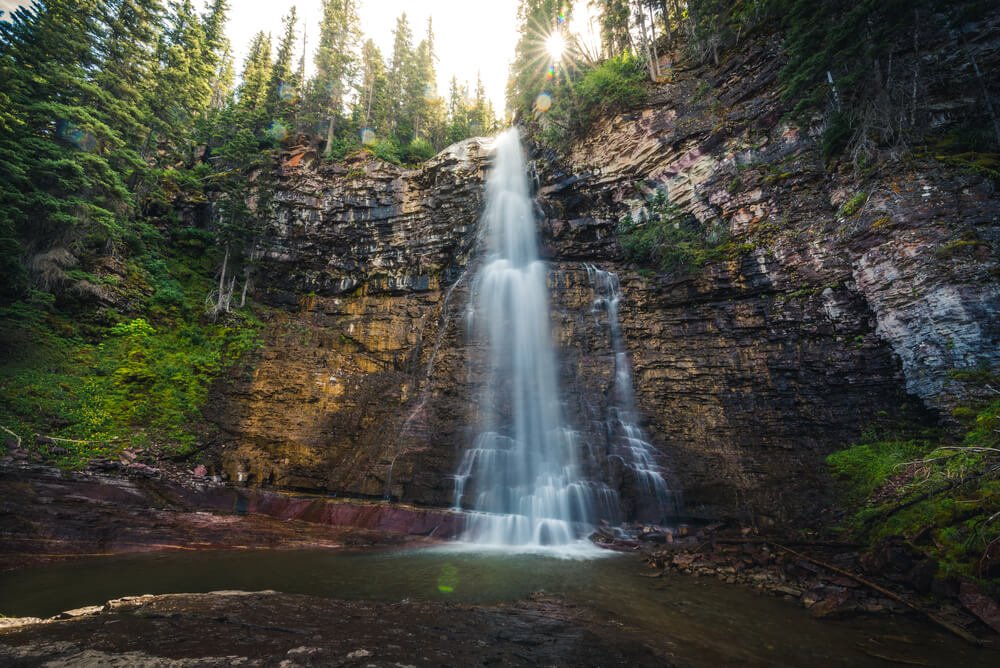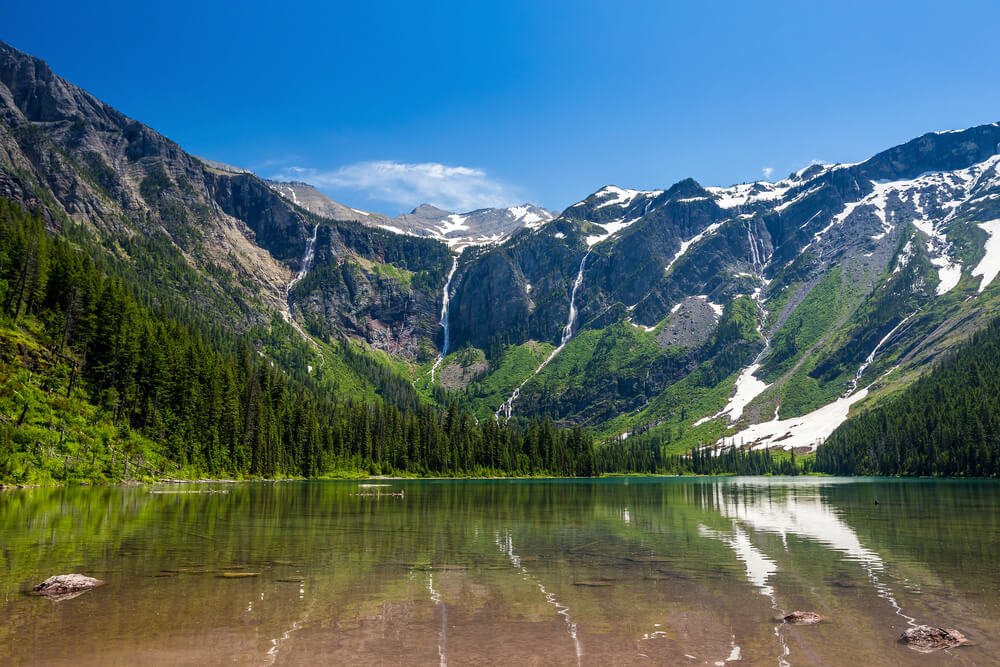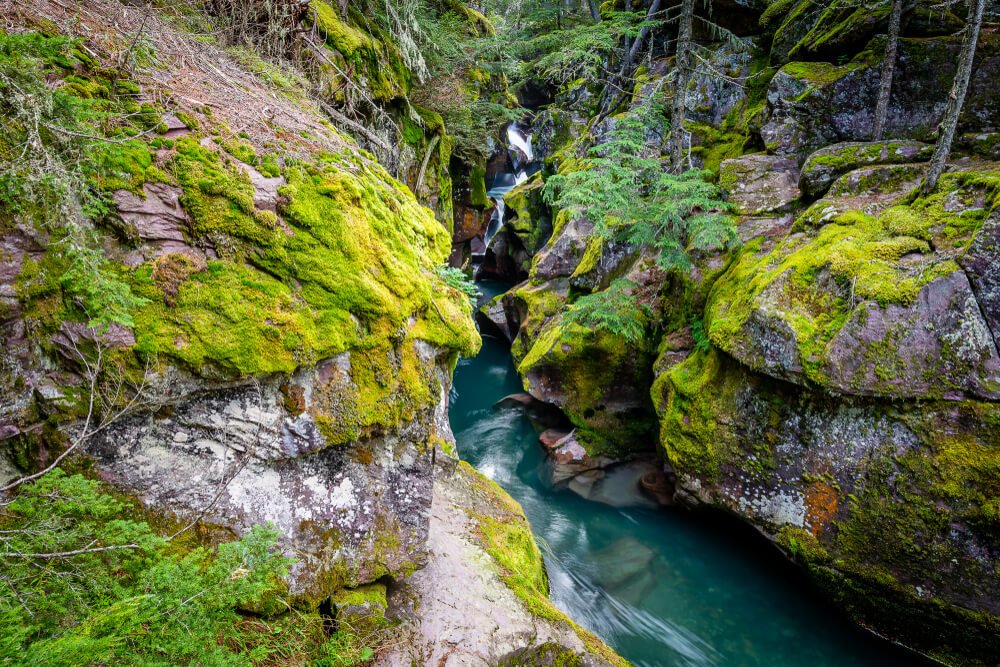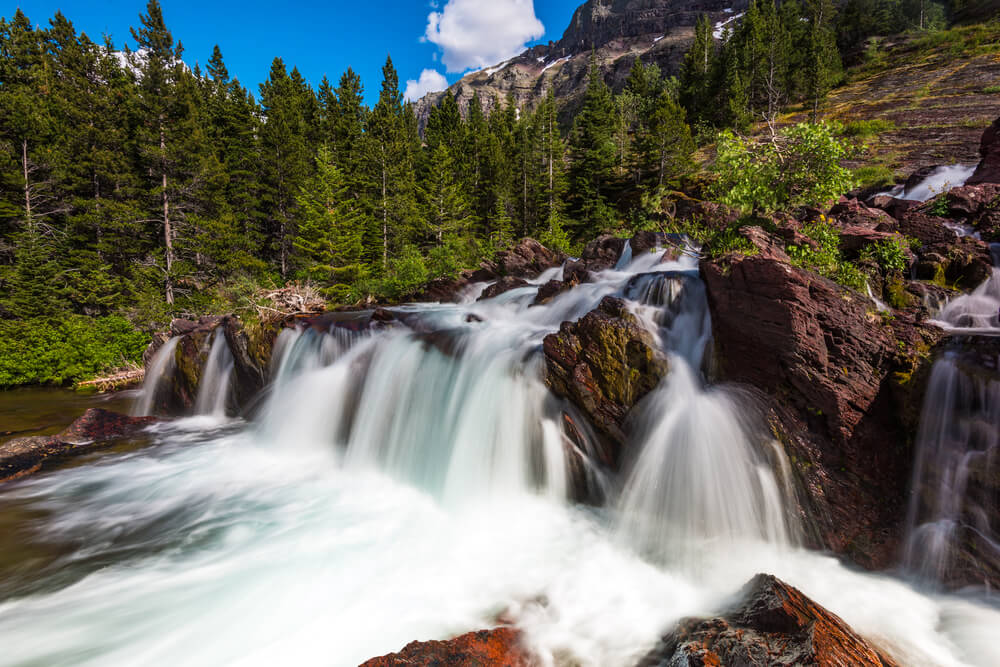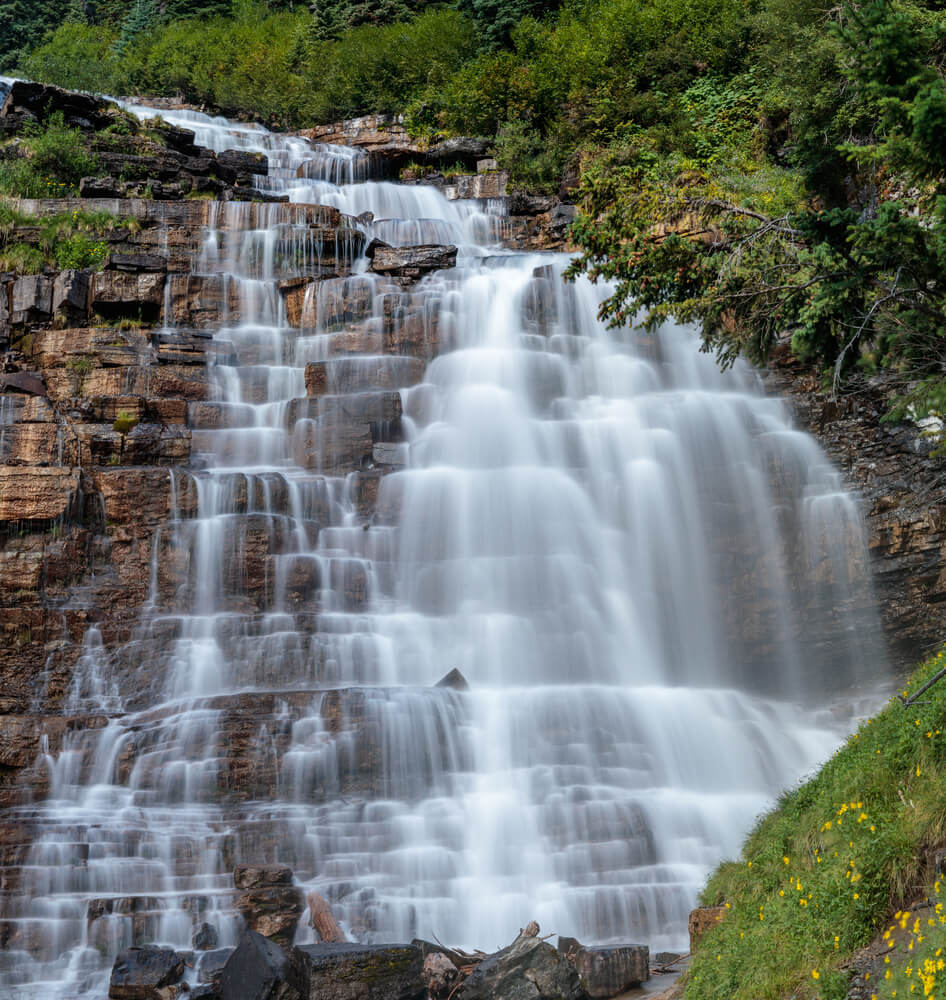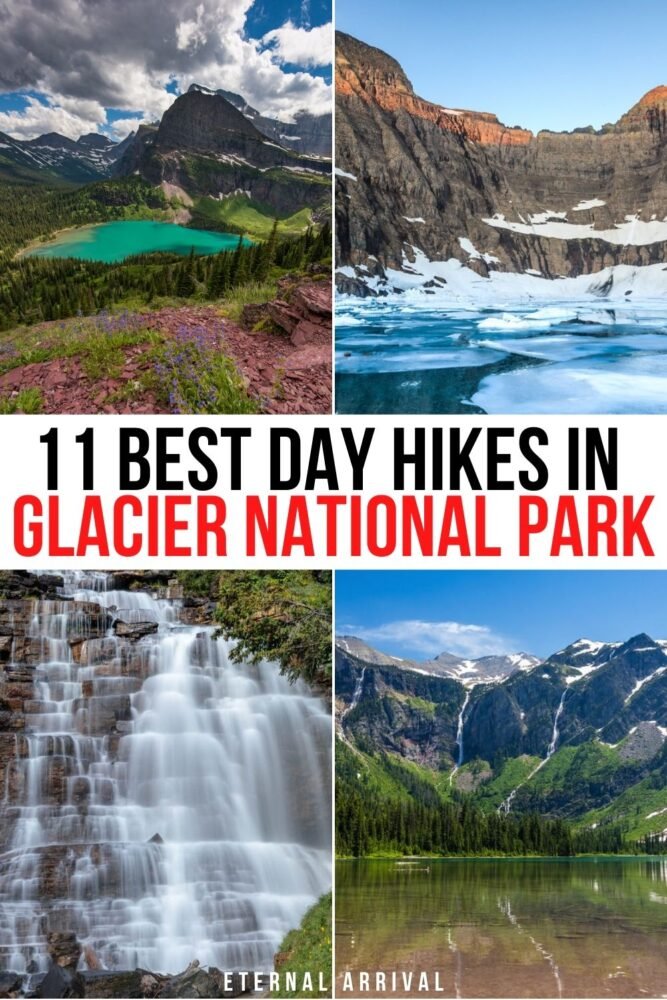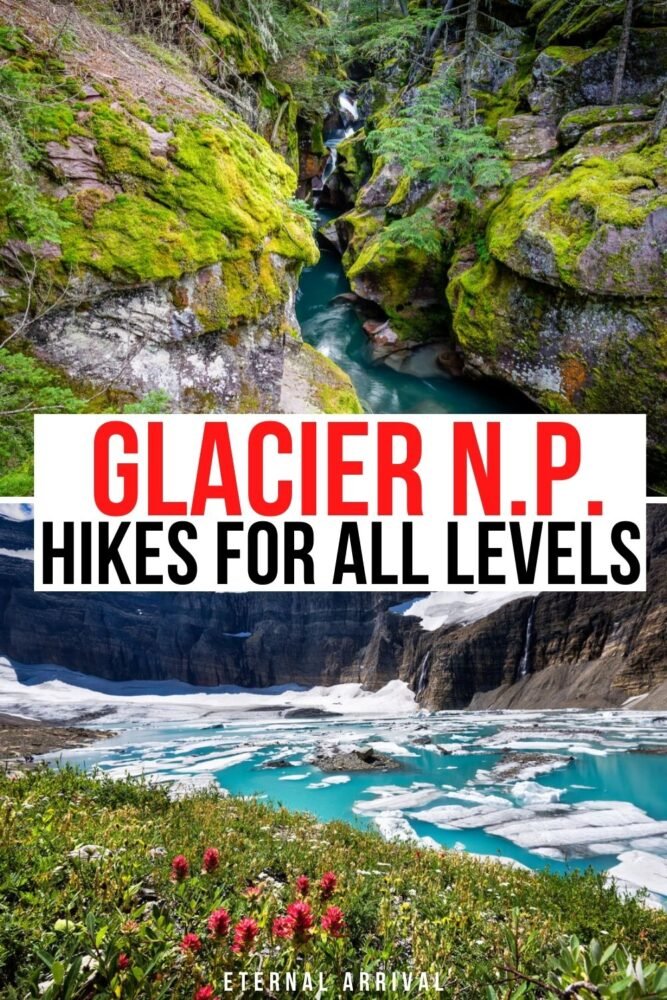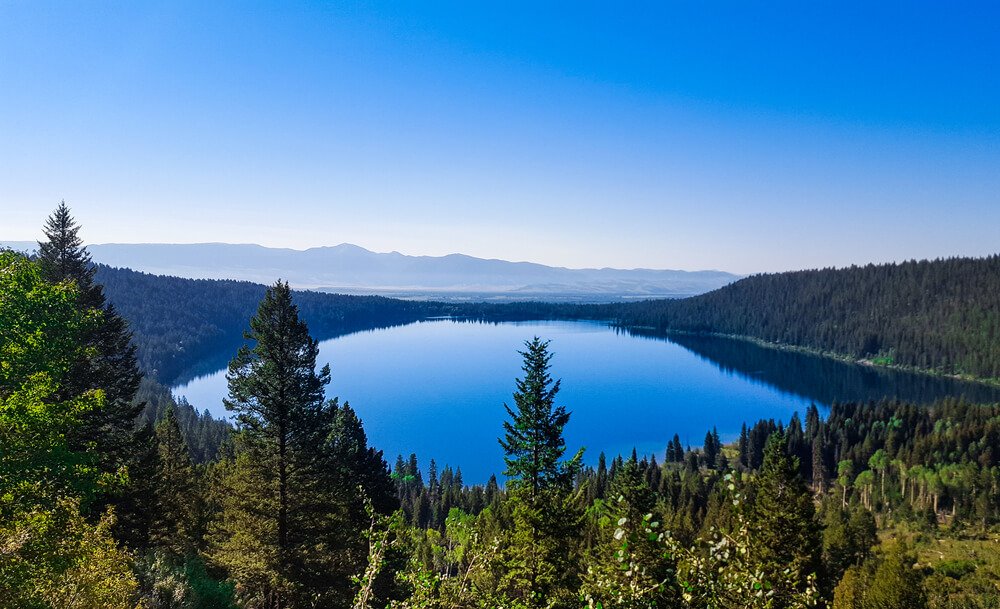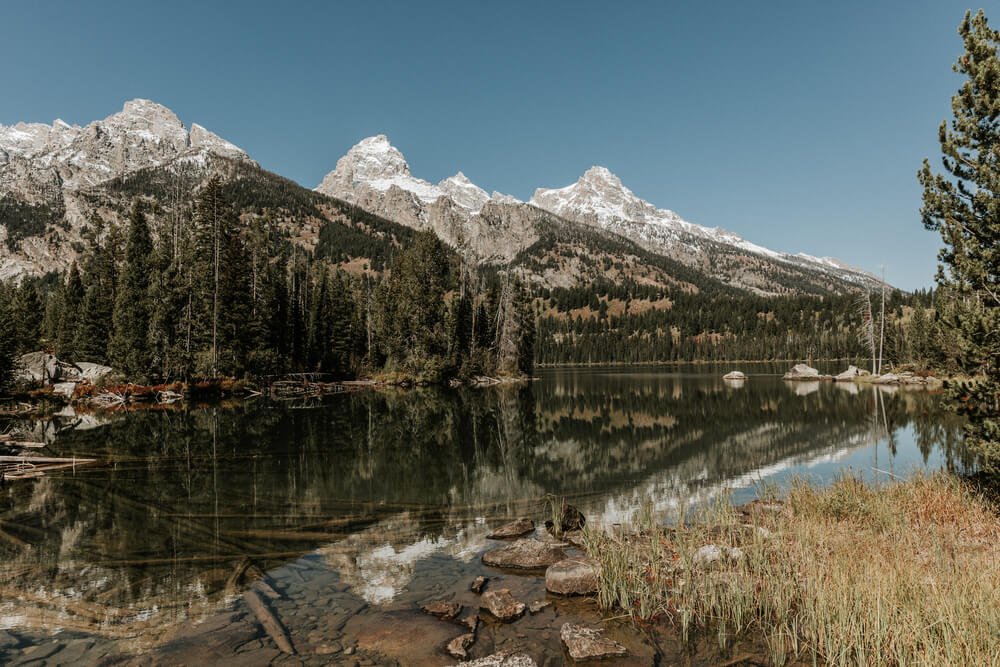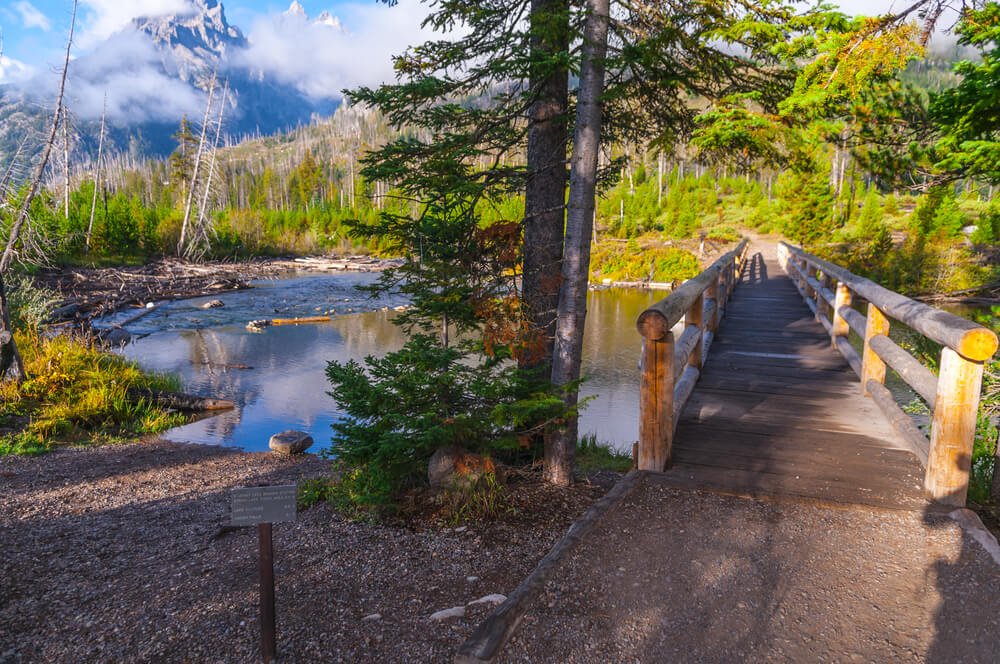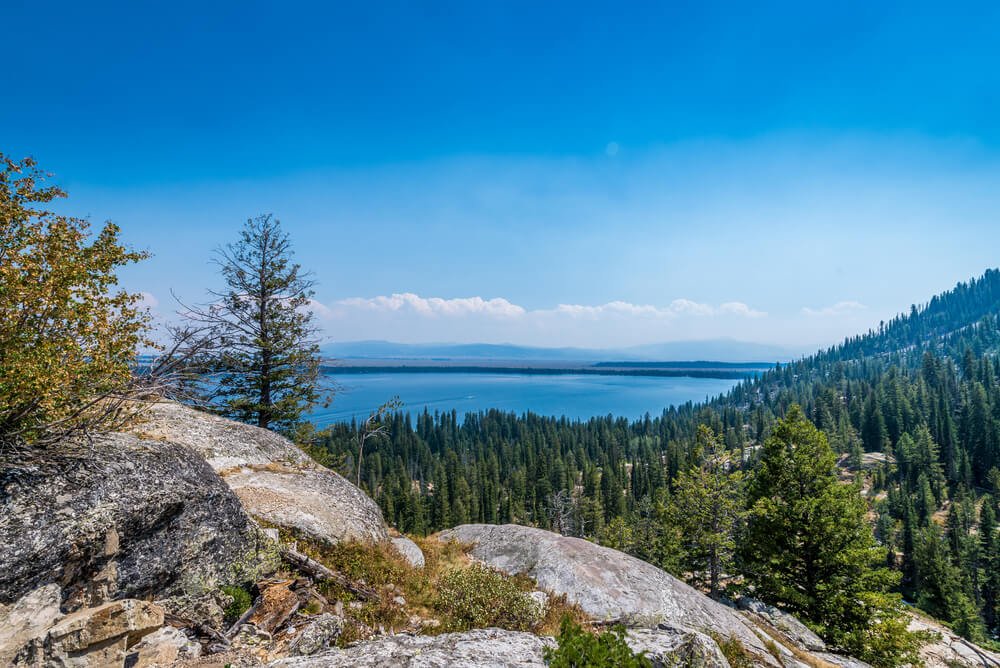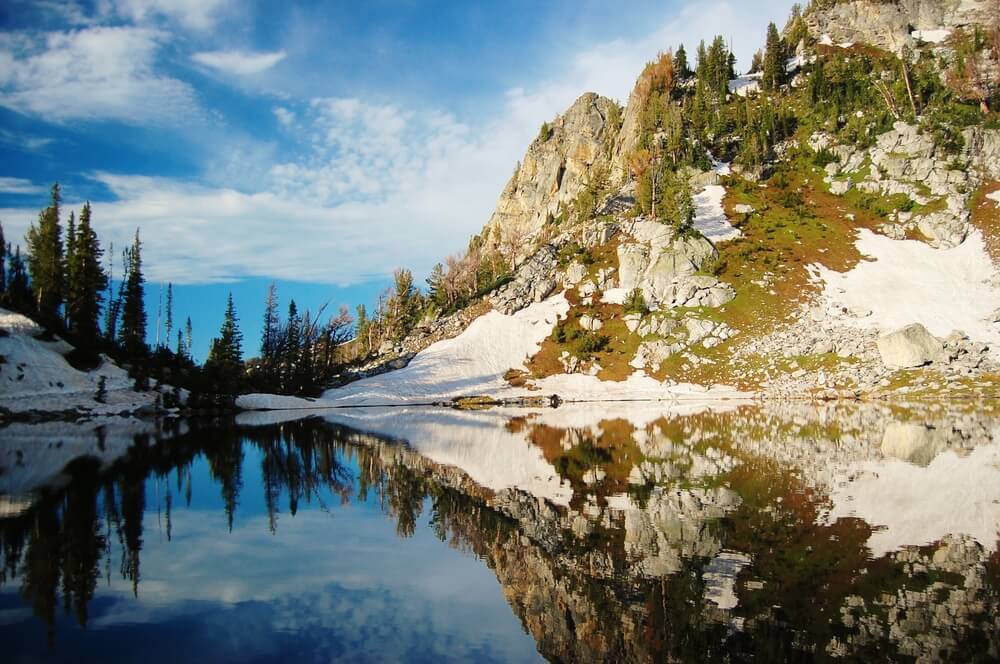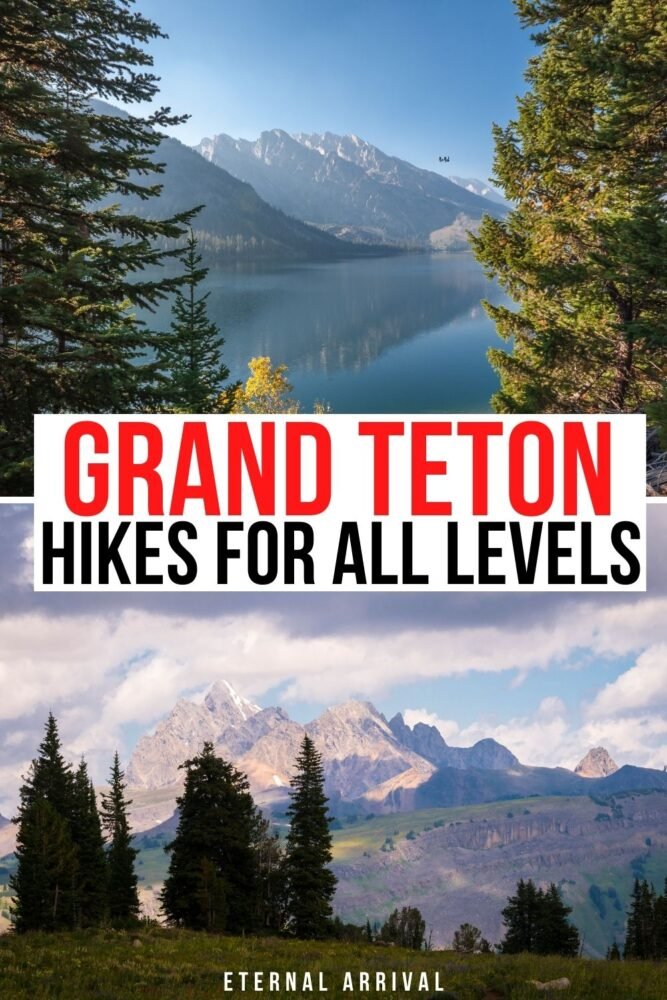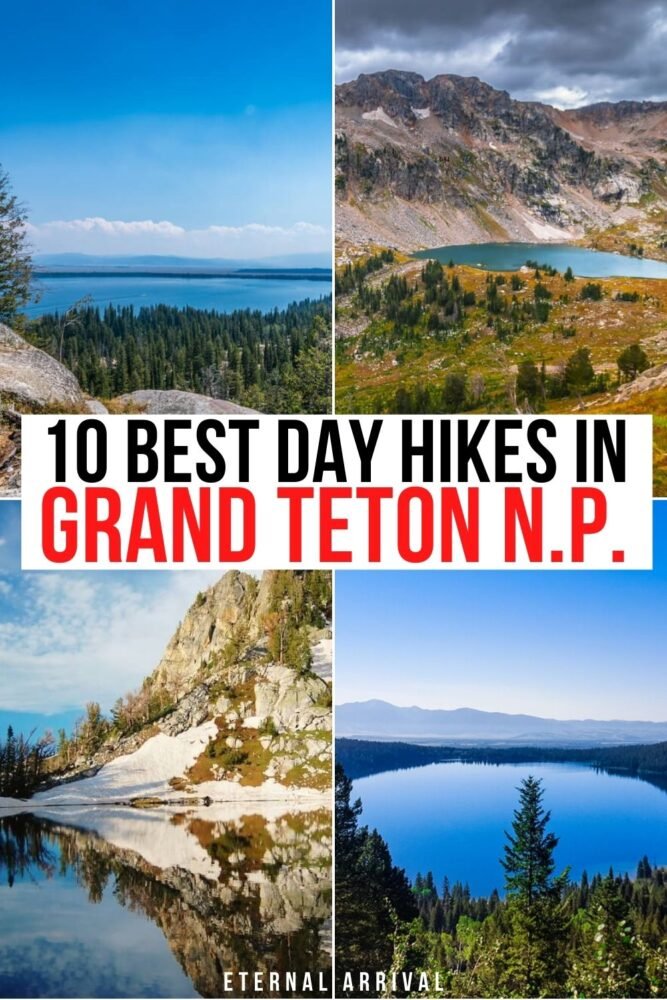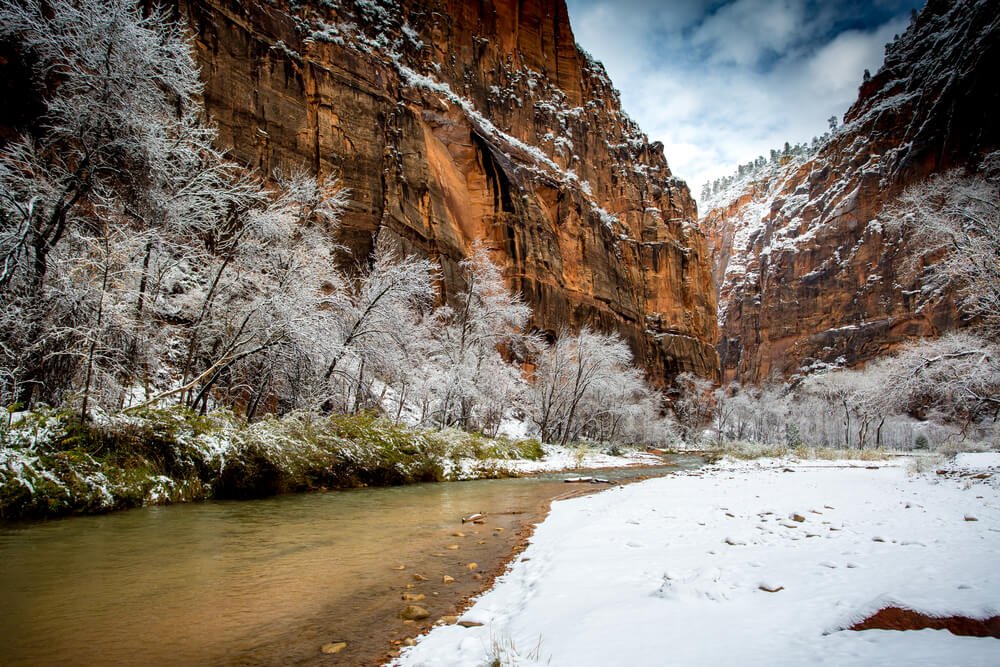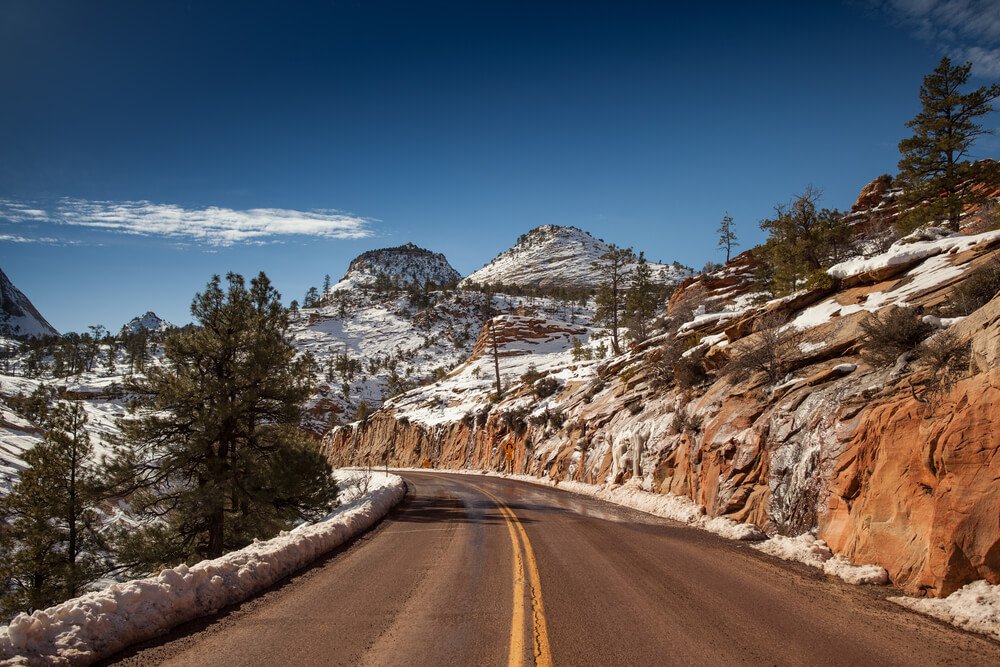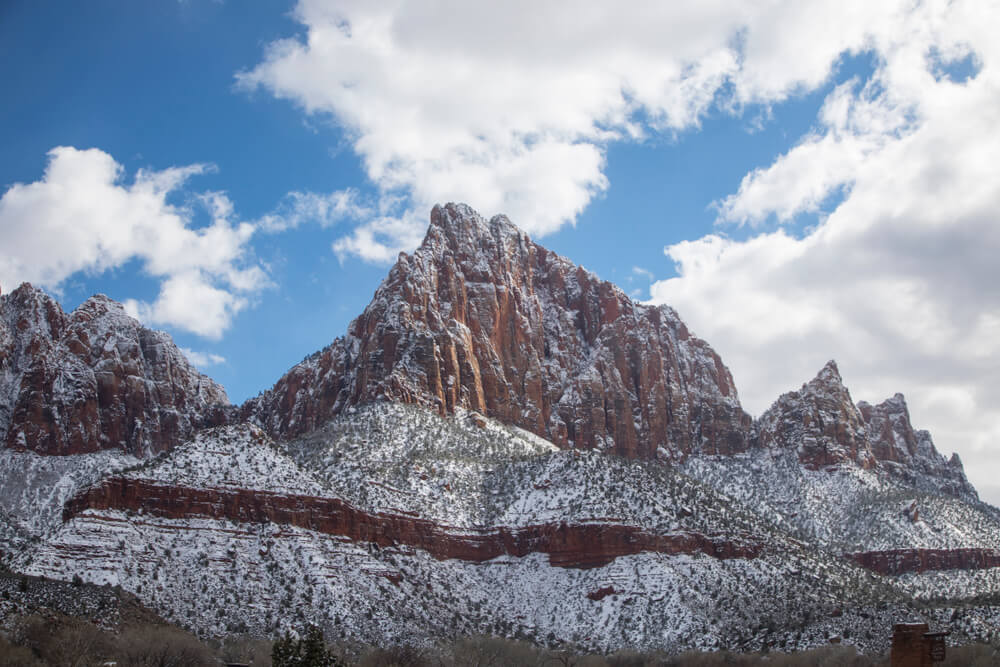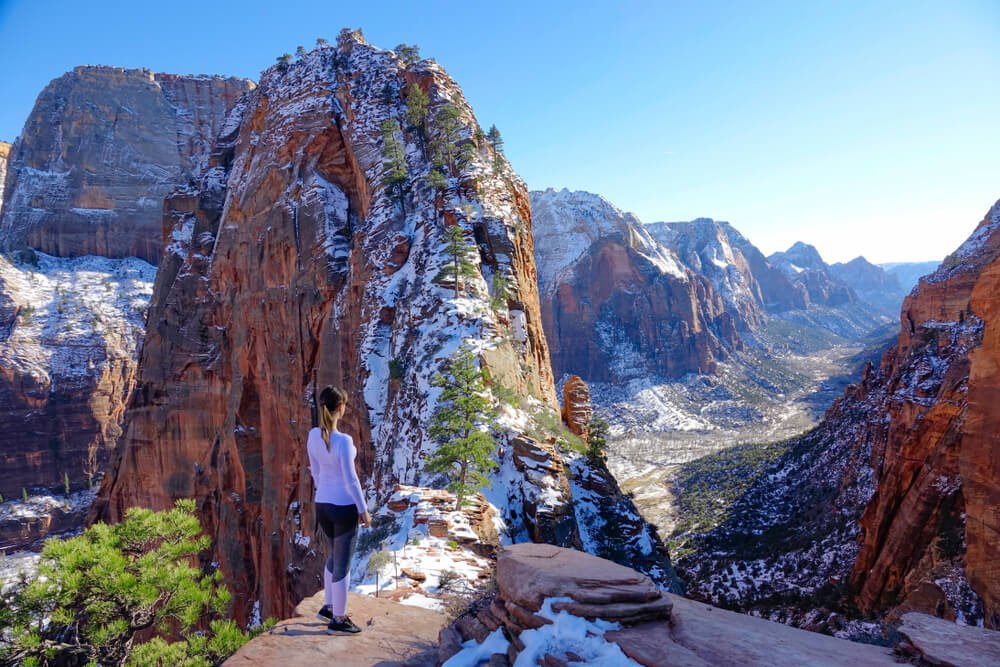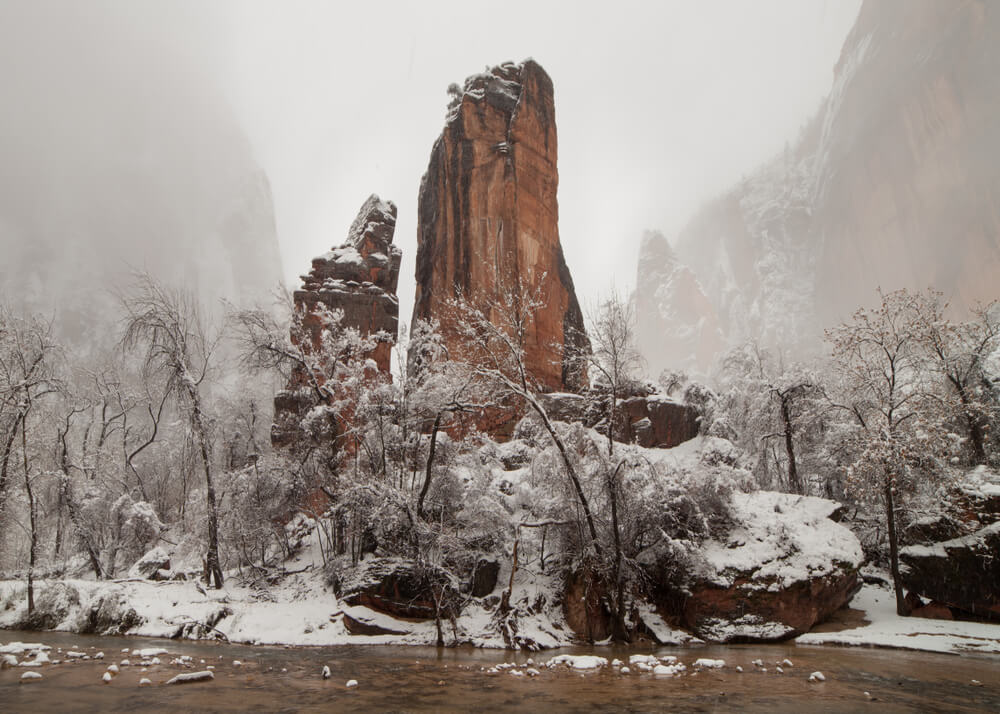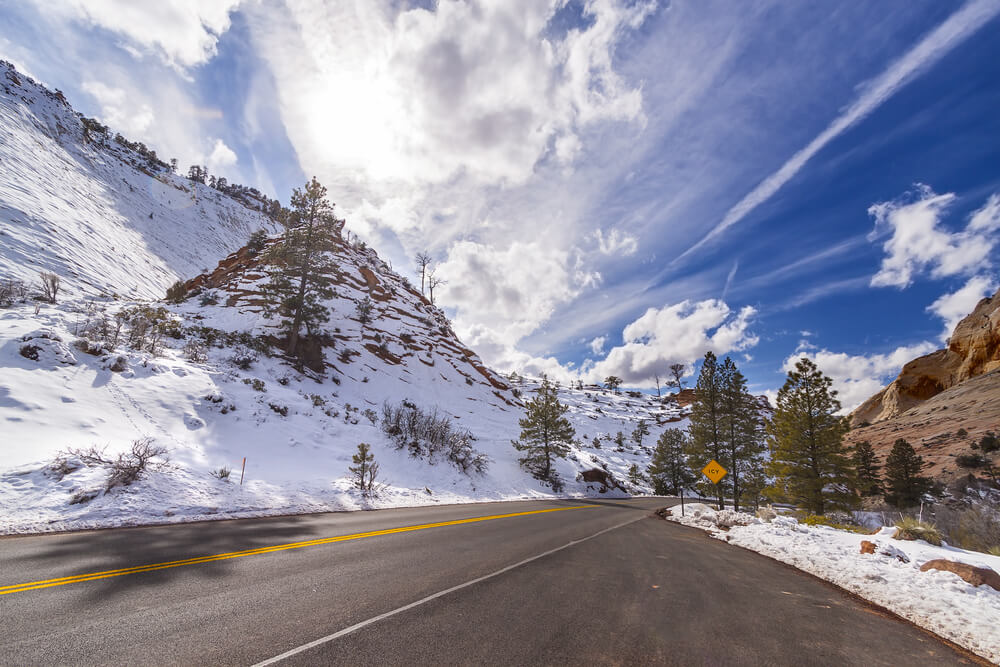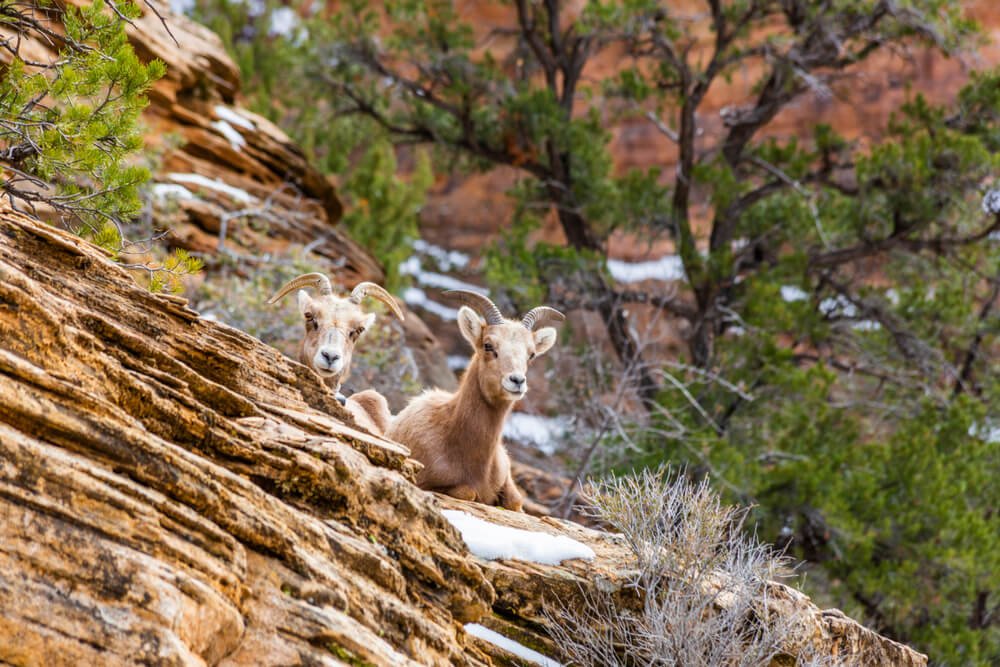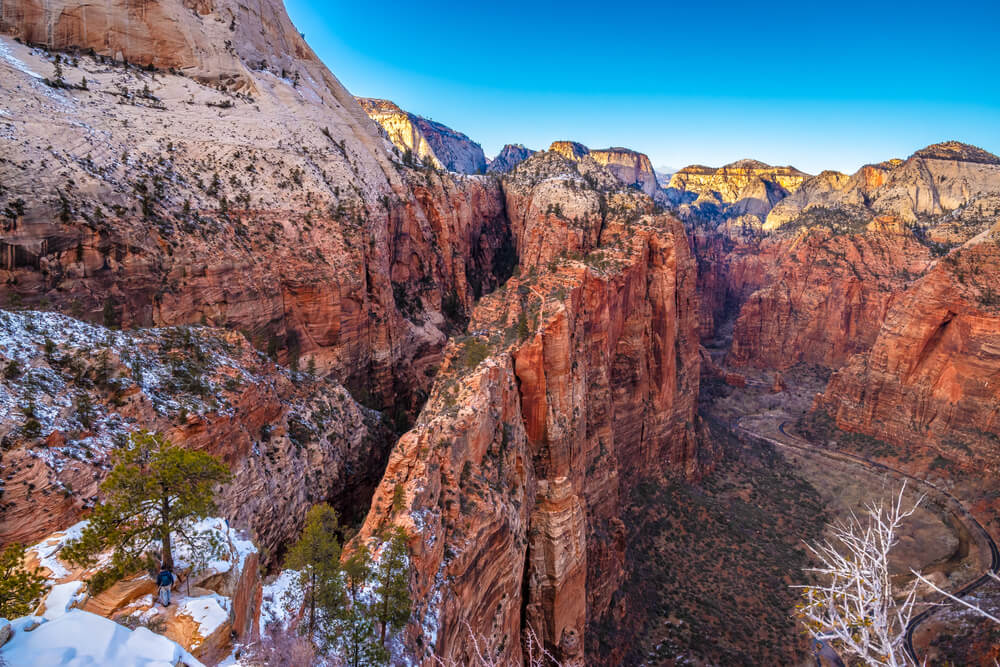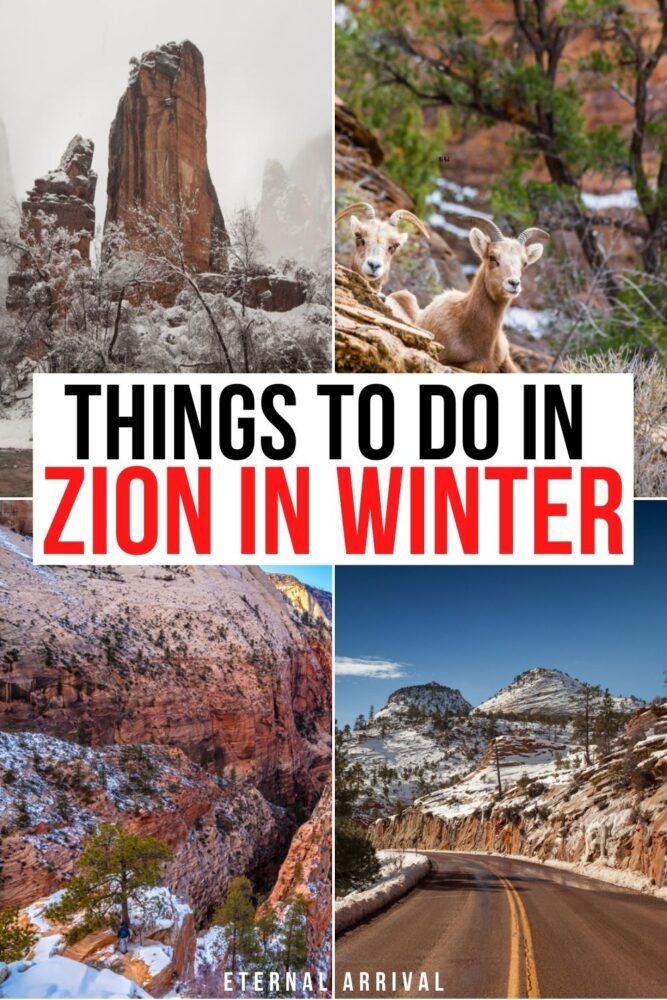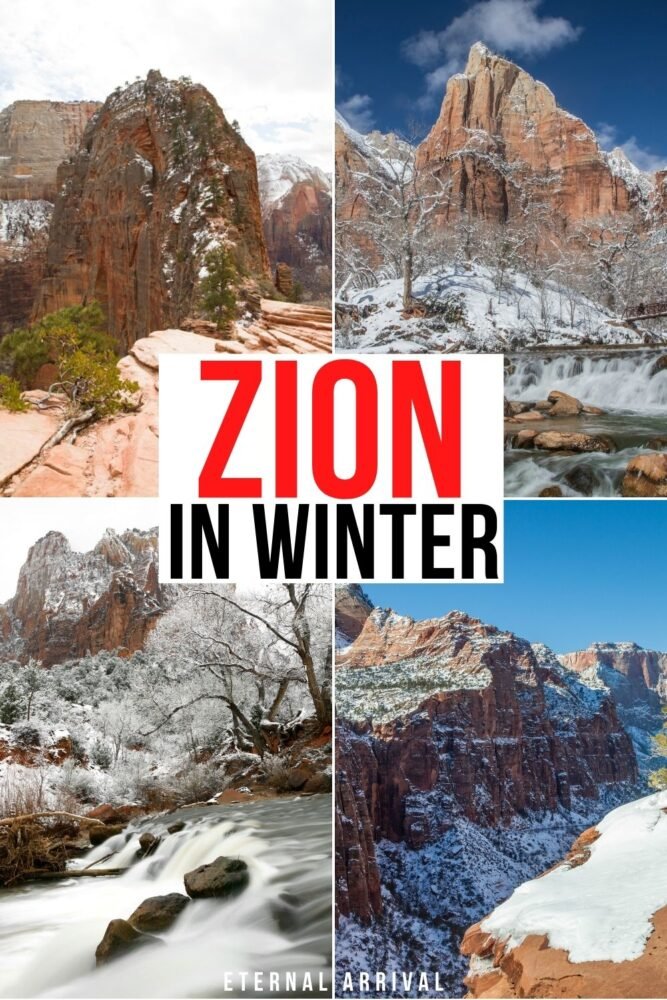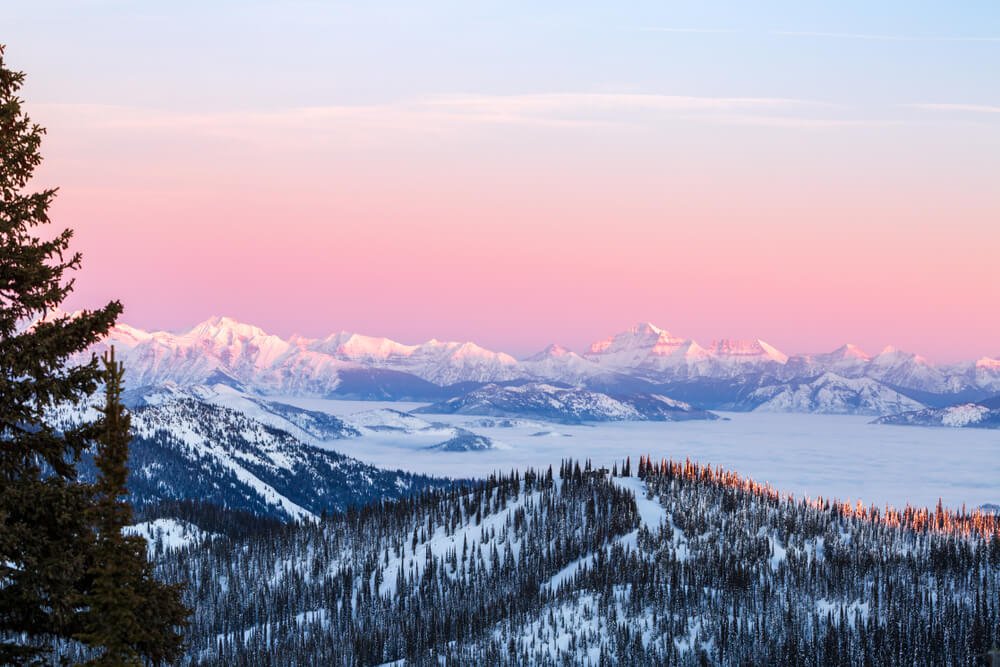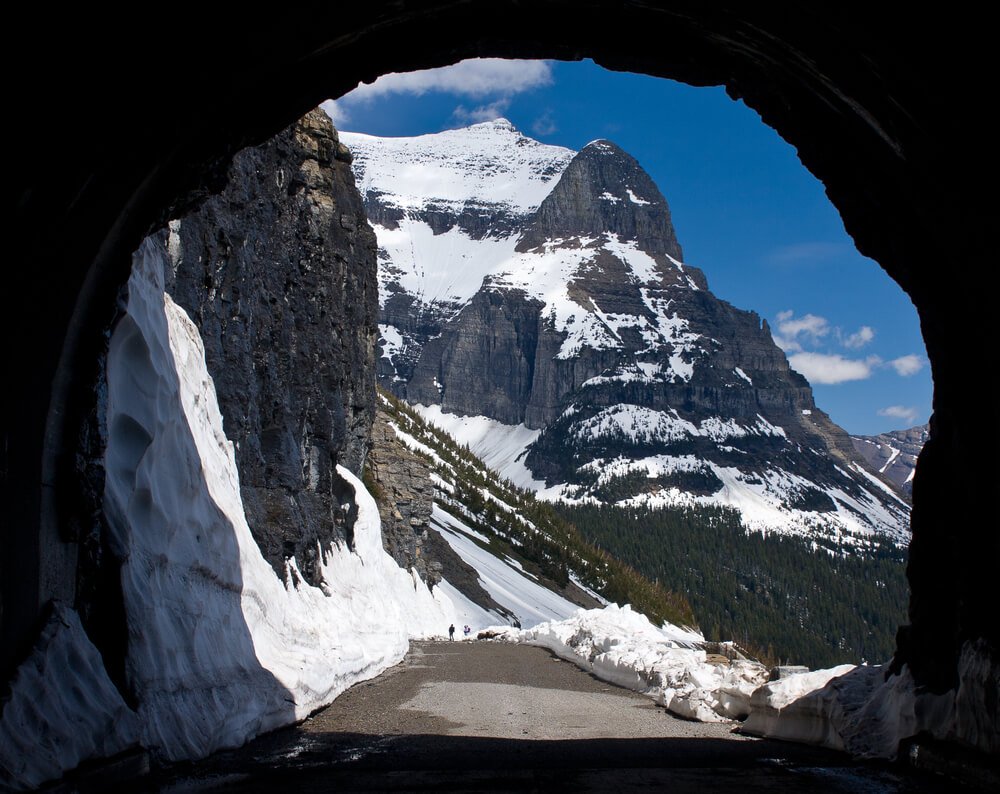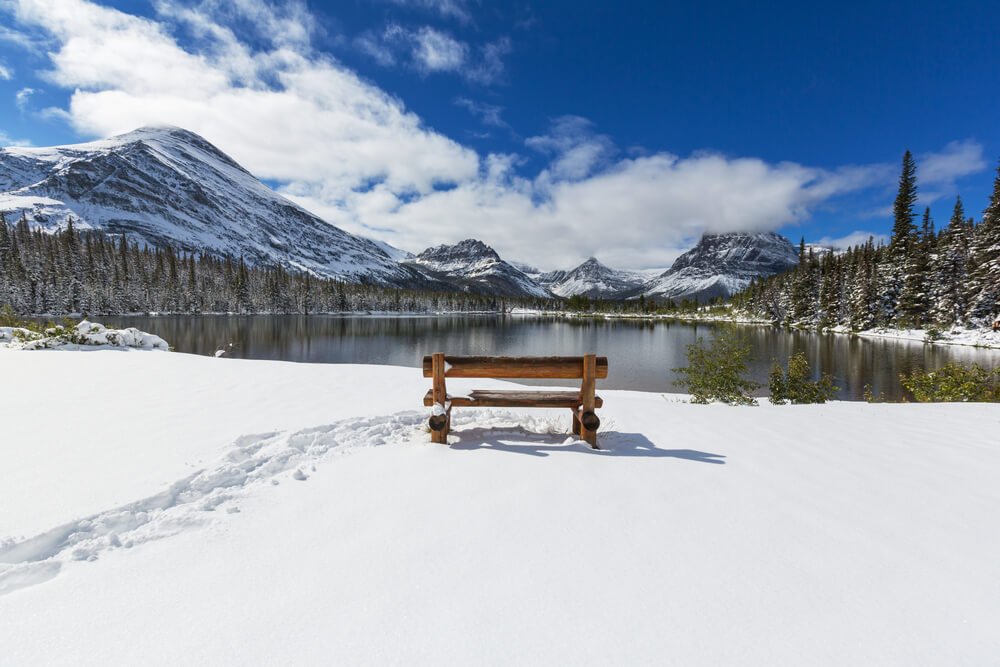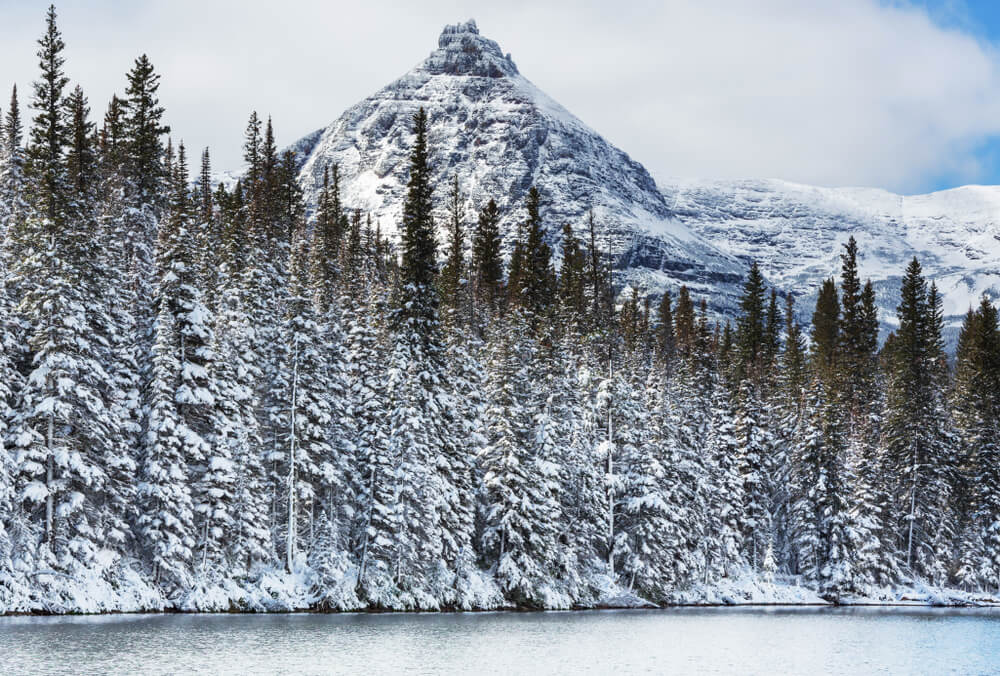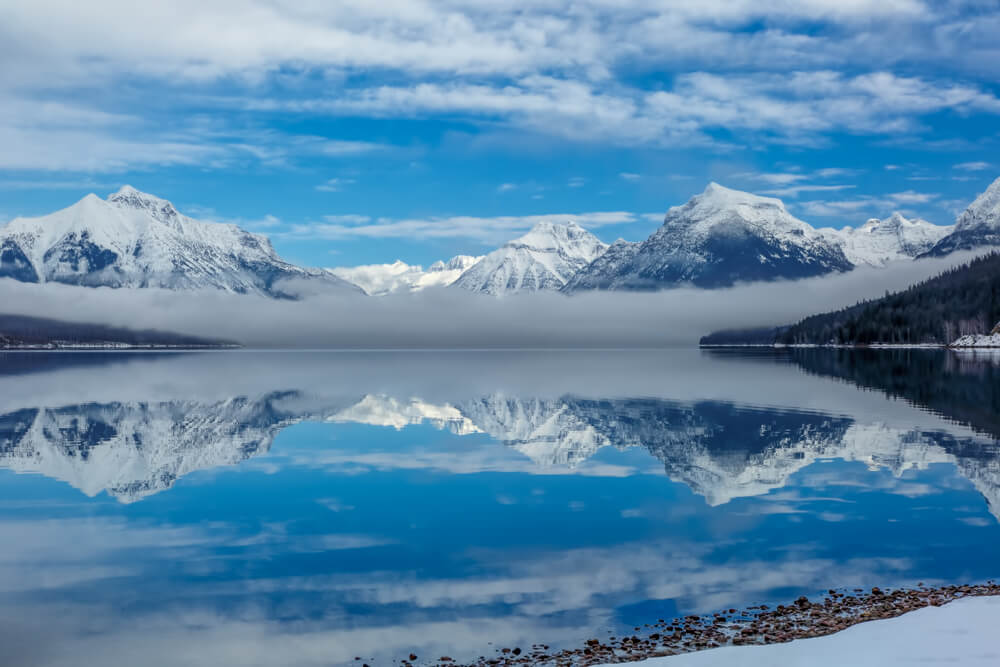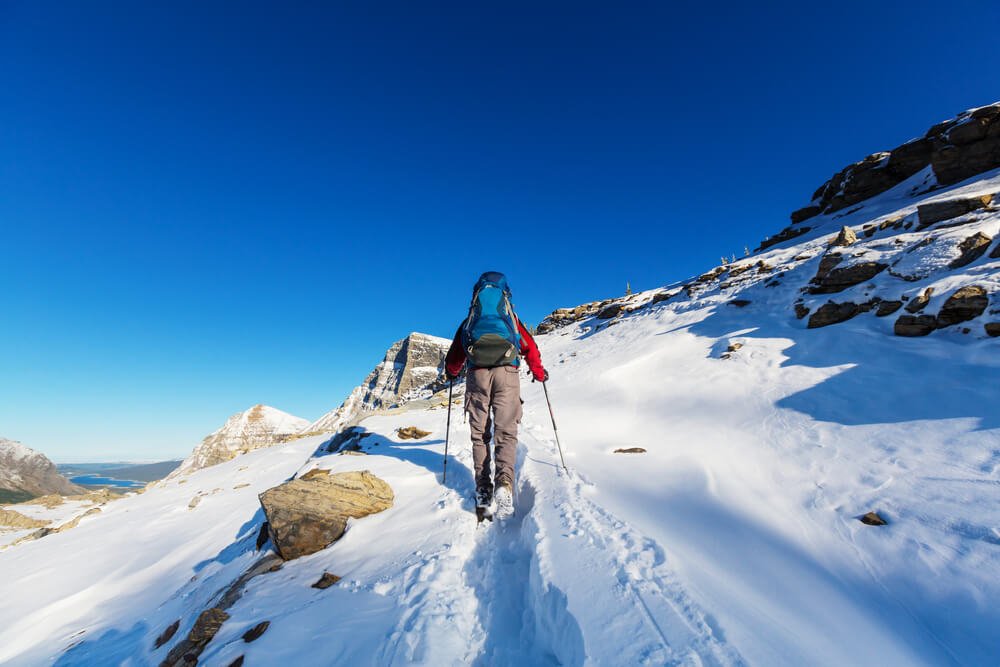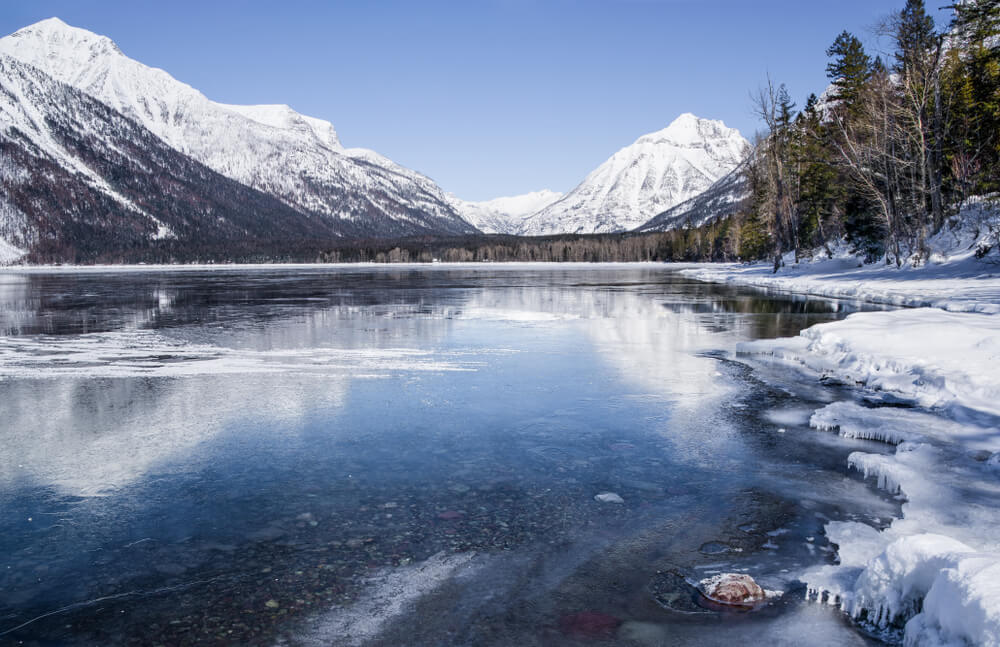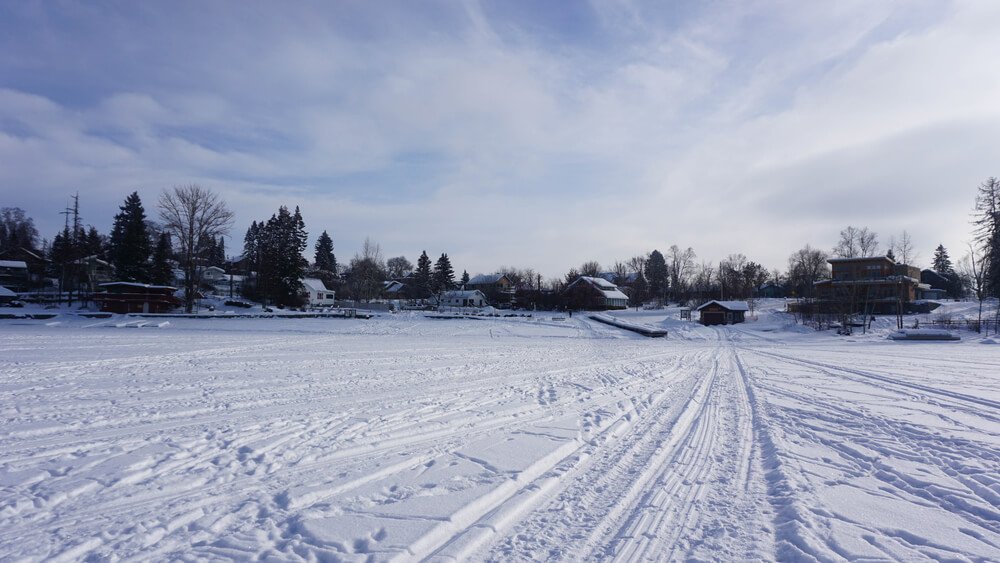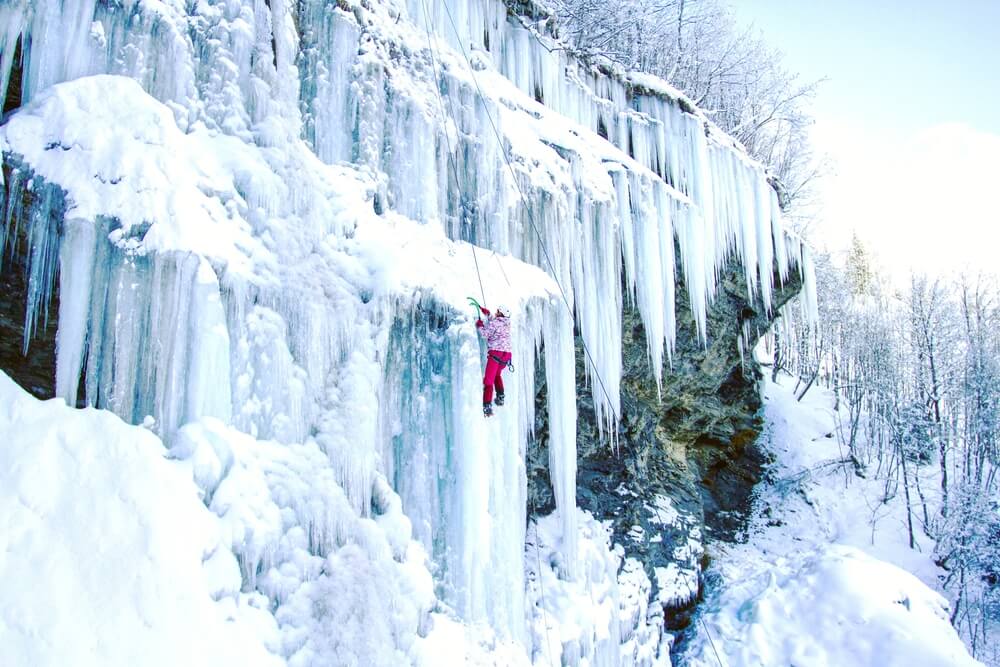The Grand Canyon is rightfully one of the most renowned landmarks in all of America, and there’s no wonder that it figures high on nearly everyone’s national parks bucket list.
The Grand Canyon was formed by the rushing waters of the Colorado River after many million years of erosion and assisted by plate tectonics which uplifted the Colorado Plateau, creating an even more…. well, grand, of a canyon!
The Grand Canyon National Park site encompasses a massive 1,902 square miles. At its longest point, the Grand Canyon measures 277 miles across, and is up to 18 miles wide… which means that the North and the South Rims are quite far apart!
In fact, to drive from the visitor center at the North Rim to the visitor center at the South Rim takes about 4 hours!
As a result, you’ll likely want to pick one or the other.

If you are doing a huge, long Southwest road trip and have 2+ more weeks in the region, you can easily see both sides, but frankly, seeing one side of the Grand Canyon is plenty for one trip.
I spaced out my visits to the South Rim and the North Rim, visiting the South Rim in May of 2017 and just completing my visit to the North Rim in July of 2021.
In this post, I’ll quickly cover a few frequently asked questions about visiting the Grand Canyon, explain the difference and pros and cons of the North Rim vs. the South Rim of the Grand Canyon, and give some tips to help you pick which side of the Grand Canyon is better for your trip.
I’ll also include things to do on each side of the Grand Canyon, specific to the North Rim or the South Rim.
Finally, I’ll also have some tips on where to stay, including some feedback about the campsite I stayed at as well as suggestions for accommodations.
Grand Canyon FAQs
Which is better to see: the North Rim or the South Rim of the Grand Canyon?
Honestly: either!
If we are strictly talking views, both sides of the Grand Canyon offer exquisite ones. There is no real reason to privilege one side over the other in terms of what you can see.
When I go into whether you should pick the North Rim vs. the South Rim, views aren’t a factor, but itinerary, how far in advance you are planning, and time of year you are visiting the Grand Canyon all are!
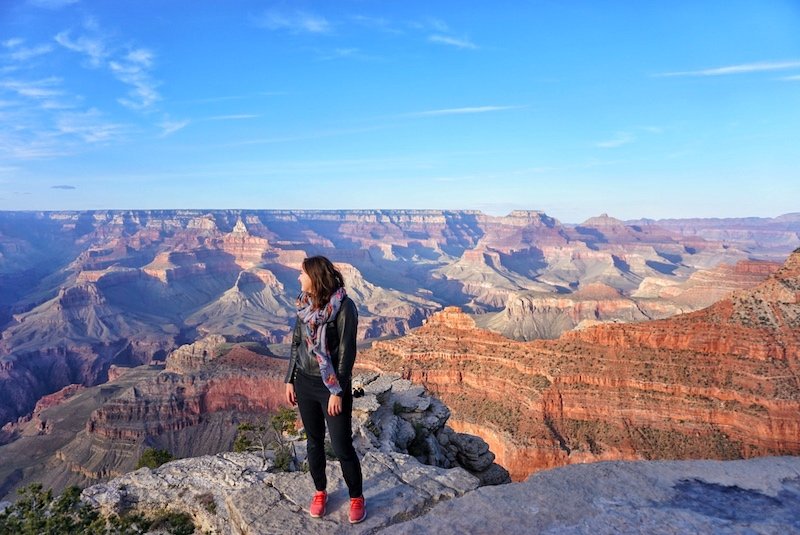
Is visiting the North Rim of the Grand Canyon worth it?
Absolutely! The North Rim of the Grand Canyon is every bit as beautiful as its more popular southern rim.
However, if you’re already visiting the South Rim for sure, I don’t know that the North Rim warrants a separate journey on the same trip.
I’d suggest picking one side of the Grand Canyon per trip. If you visit the area again on another road trip, then pick the side you haven’t visited before!

Where is the best view of the Grand Canyon?
Every view of the Grand Canyon is pretty stunning. I’ll list a few of the best viewpoints of the Grand Canyon broken down between the two rims.
North Rim Viewpoints: Bright Angel Point, Cape Royal, Point Imperial, Walhalla Overlook.
South Rim Viewpoints: Mather Point, Yavapai Point, Yaki Point, Moran Point, Lipan Point.

Can you drive from the South Rim to the North Rim of the Grand Canyon?
Totally… but it takes time! 4 hours, in fact.
From the South Rim to the North Rim, you’ll leave the Tusayan / Grand Canyon Village area, drive along Highway 64 until you reach Highway 89 at Cameron.
From there, you’d drive until Marble Canyon, then take Highway 89A to Jacob Lake. Once reaching Jacob Lake, you’d take Highway 67 the rest of the way.
This driving route would also work in reverse if you were visiting the North Rim first and then going to the South Rim.
However, I wouldn’t really advise this unless you have a ton of time that you only want to dedicate to Grand Canyon National Park.
If you are visiting the Grand Canyon as part of a larger Southwest itinerary, I’d suggest allocating more time for other destinations and places.

What is the difference between North Rim and South Rim Grand Canyon?
That’s what this post is all about! We’ll go into more detail below, but here’s the TL;DR.
North Rim: Far less crowded (only 10% of the visitors), more remote, fewer amenities, better for a Utah parks road trip, not able to be visited in winter months, better in summer months.
South Rim: Much more crowded (90% of the visitors go here), better for Arizona road trips, better for day trips, more amenities and lodging options, open year-round.
One other thing to keep in mind is the appreciable elevation difference between North and South.
The elevation at the South Rim is 6,804 feet; the elevation at the North Rim is 8,297 feet (and up to 8,803 feet at Point Imperial, the highest point of the Canyon rim).
The South Rim tends to be several degrees hotter in summer as a result. However, hikers should note that the altitude is a little easier to adjust to at the South Rim, whereas hikers at the North Rim will have a little more struggle with the altitude.

Are there entrance fees to the Grand Canyon?
Yes. Park entrance fees are $35 per vehicle to the Grand Canyon. That grants 7 days of access to both the North and the South Rims, as they are both operated as one National Park Service site.
Both the North and the South Rim are also included in your America the Beautiful Pass, which can be purchased online at REI before your trip.
Which is the best time of the year to go to the Grand Canyon?
It depends!
If you’re visiting the North Rim, know that it’s only open between May 15 and October 15… and any of those times is a good time to go! The North Rim is not very crowded, so any time will be fine within that period.
If you’re visiting the South Rim, the Grand Canyon is able to be visited year-round! However, the South Rim is very crowded in the summer and even in the shoulder seasons.
I visited the South Rim in early May and it was packed… I can’t even imagine peak summer!
The South Rim is a popular option if you are visiting the Grand Canyon in winter, as it’s open year-round and is really beautiful under a layer of snow!
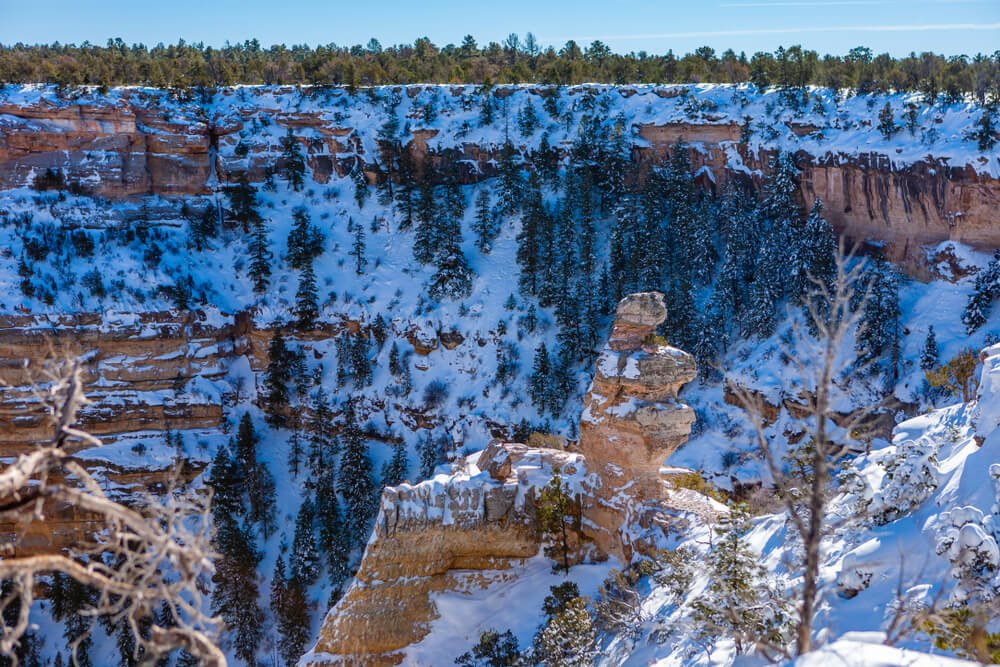
What is the best place to stay at Grand Canyon National Park?
There are so many options when it comes to where to stay!
North Rim: The Grand Canyon Lodge is the main traditional accommodation option. I went here to check out the sunset and it looked like a fantastic place to stay.
There is also the North Rim Campground, where I stayed — and I loved it! For $20 a night, I literally could see Grand Canyon views squeezed between some pine trees. It was incredible.
South Rim: There are so many options! The main lodges are Bright Angel Lodge, Yavapai Lodge, and the Thunderbird Lodge, but these need to be booked well in advance…. like 6+ months, typically.
There are also lots of great vacation rentals near the Grand Canyon if all the traditional accommodations and lodges within the National Park Service site are full!
Additionally, you can also stay at the Mather Campground outside of the South Rim.
Note that Bright Angel Campground is located at the bottom of the Grand Canyon and has limited campsites that can only be accessed via a hike, for which you need a (highly coveted, hard-to-get) backcountry permit.
There’s also the Phantom Ranch located at the bottom of the Grand Canyon as well if you are hiking in!
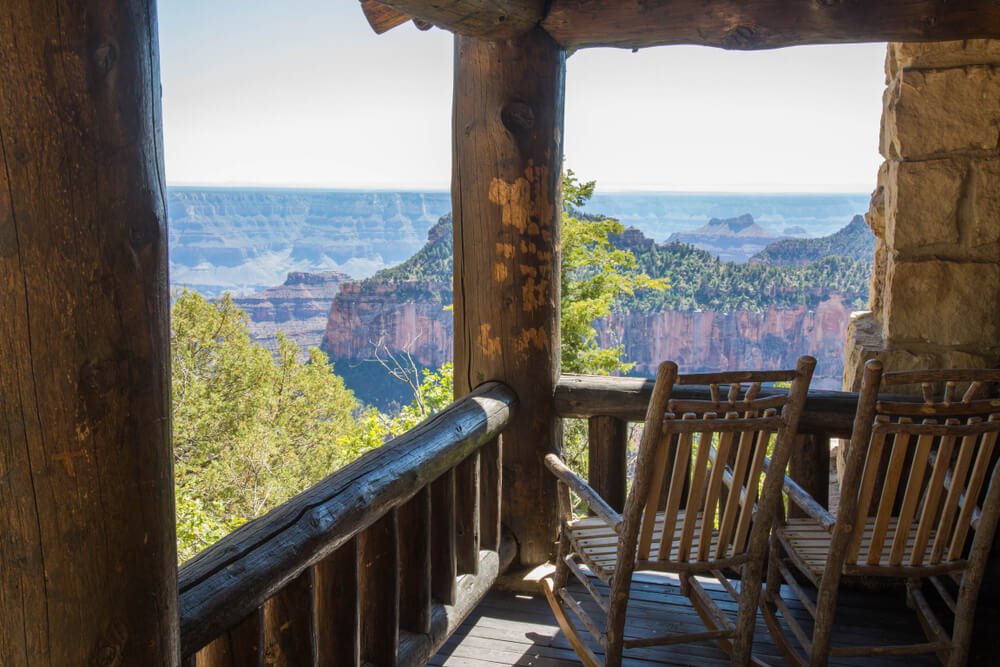
Pick the North Rim if…
… You want to avoid the crowds.
Grand Canyon National Park sees nearly 6 million visitors each year… but 90% of those visitors will only see the South Rim.
Only 10% of people who visit the Grand Canyon make it to the North Rim of the park…. meaning that only some 600,000 people a year visit the North Rim, period.
This means that the North Rim is far less crowded than the South Rim all year round.
I went to the North Rim right after the Fourth of July weekend, and it was really quiet and peaceful.
Meanwhile, I visited the South Rim a few years back in early May, during the shoulder season before school holidays and summer vacations, and it was extremely busy and crowded.
For me, the serenity of the North Rim makes up for the fact that there are fewer amenities and activities around it. But more on that in a bit!
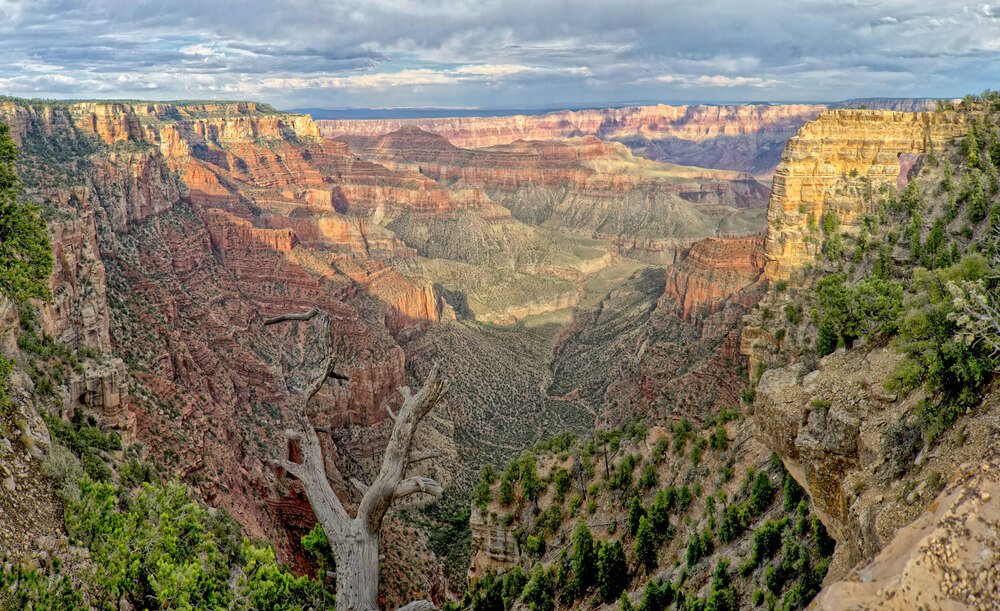
… You are also visiting Utah national parks.
The North Rim of the Grand Canyon gets a bad rap for being “harder to reach” but I’m not really sure why that is.
The North Rim of the Grand Canyon is only open from May 15 to October 15 each year, but within that time frame, it’s very accessible, especially if you are doing a Southwest road trip that involves some of Southern Utah’s Mighty 5.
From Zion National Park to the North Rim, it’s 122 miles and 2 hours and 45 minutes.
From Bryce Canyon National Park to the North Rim, it’s 157 miles and 3 hours.
Additionally, the North Rim of the Grand Canyon is pretty easily accessible from Page, AZ (where you’ll find Antelope Canyon & Horseshoe Bend).
From Page, it’s just 124 miles driving, which takes about 2 hours, 20 minutes.
However, from other places in Arizona, such as Flagstaff, Sedona, or points along Route 66, the South Rim is more convenient.

… You want to see wild bison.
One of the coolest things about visiting the North Rim of the Grand Canyon is that the park encompasses a massive bison herd!
Normally people think they need to head all the way to Yellowstone National Park if they want to see bison… but that’s not the case!
There is a huge herd of bison living on the Kaibab Plateau, which you’ll find after you enter the NPS park boundary and the entrance station, but before you reach the North Rim.
The bison stay very close to the roadside and it’s very easy to spot them. In fact, on my trip into the North Rim, the bison literally were crossing the road and traffic was stopped until they passed!
On my trip out of the North Rim, coming out the same way we came in, there were still plenty of bison quite close to the roadside.
Keep in mind that bison are wild animals and you should never approach them or make them feel uncomfortable. Staying in the car is the safest way to observe them, unless they are quite far away.
Stay at least 25 yards away as per the NPS guidelines, and watch for signs of them being uncomfortable (eye contact, raised tails). Bison can and do attack humans, so be careful.
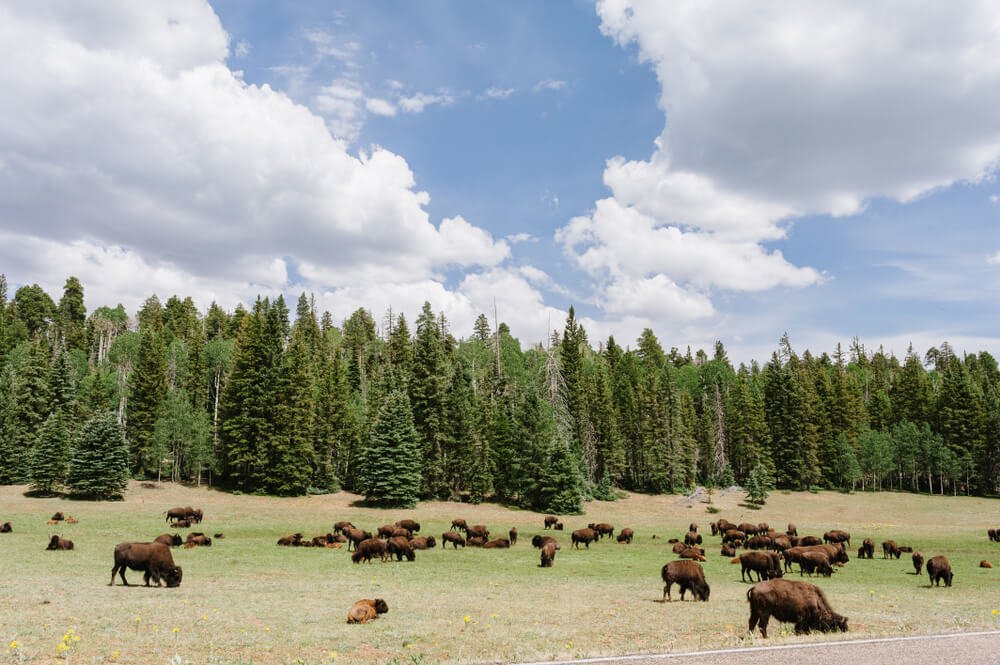
Things to Do at the North Rim
Catch the sunrise at Bright Angel Point.
One of the best places to catch the sunrise at the North Rim is at Bright Angel Point, which connects with both the Transept Trail (the trailhead is right in the campground!) and the Grand Canyon Lodge Area.
From the Grand Canyon Lodge, it’s about a 0.3-mile hike one-way, which takes about 10 minutes. The views at sunset are spectacular!
If you’re staying at the North Rim campsite, you can also do a sunrise hike to Bright Angel Point via the Transept Trail.
Please note that there are no dogs allowed on the trail to Bright Angel Point or anywhere on the Transept Trail.

Watch the sunset from the Grand Canyon Lodge.
One of the best places to watch the sunset at the North Rim is from the Grand Canyon Lodge area, near the main parking lot for the North Rim.
You can either check out the viewpoints near it, from the dining area in the lodge, from the outdoor patio area of the lodge, or down the stairs there is access to the viewpoint via the Transept Trail.
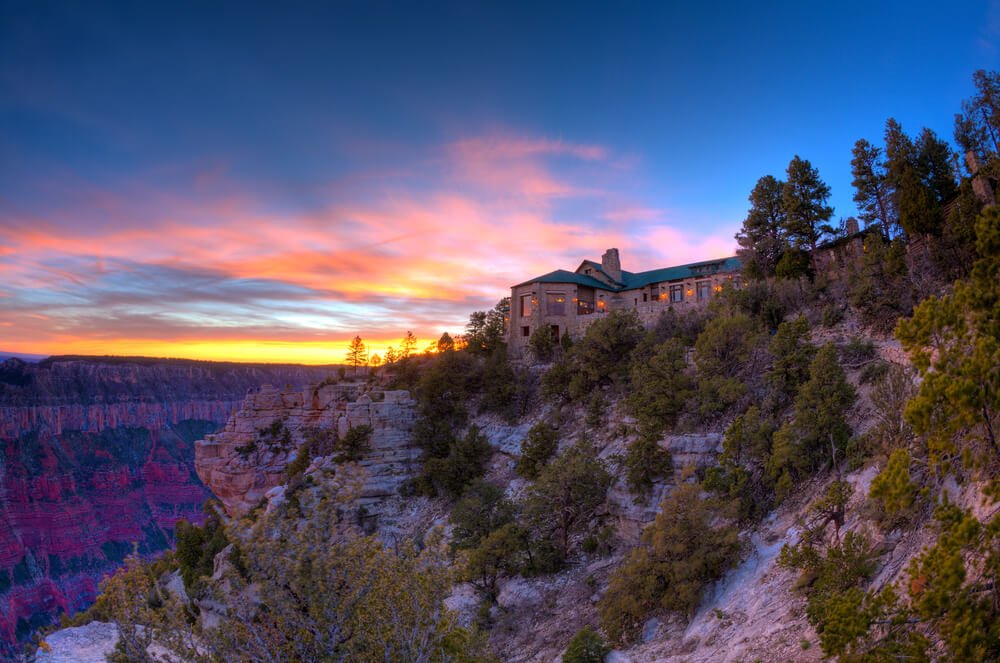
Walk the Transept Trail.
The beautiful Transept Trail connects North Rim Campground with both the Grand Canyon Lodge and Bright Angel Point.
It’s a serene, easy, and peaceful trail. To the Grand Canyon Lodge from the campgrounds, it’s 1.2 miles one-way (2.4 miles round-trip). To Bright Angel Point, it’s 1.5 miles one-way (3 miles round-trip).
It’s a great and easy day hike option that has you on the rim of the canyon vs. going into it!
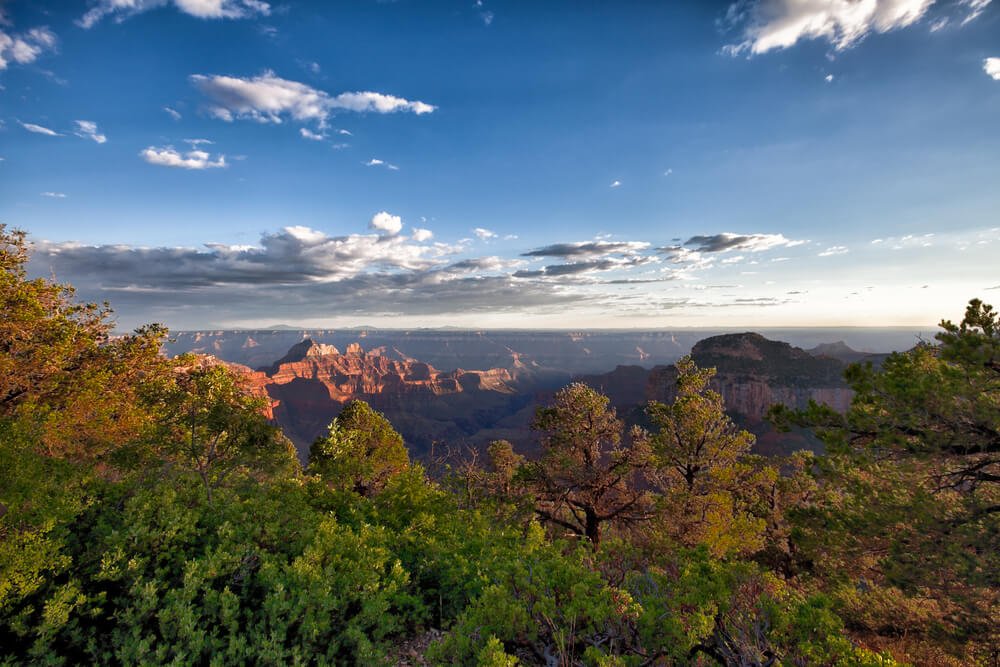
Drive the Cape Royal Road.
This beautiful scenic drive is the southernmost point of the North Rim, with the widest panorama of all — 270 degrees of horizon is filled with the beautiful canyon!
The drive is 15 miles from the North Rim Visitor Center along a narrow and winding road, and it’s a bit hair-raising at times — but it’s extremely beautiful, especially as you reach the Walhalla Plateau.
Once arriving at the Cape Royal parking area, there is a small paved 0.3-mile trail you can take to the overlook, which offers unparalleled views.
You’ll see a number of sights along the trail, including Freya Castle, Wotans Throne, and Angels Window.

How to Get to the North Rim of the Grand Canyon
Turn onto Highway 67 once you reach Jacob’s Lake. From Jacob’s Lake, it’s a little under 1 hour drive.
To get to Jacob’s Lake, you’ll be coming on Highway 89A, either from Utah (Kanab area) or from Arizona (Page + Marble Springs).
From Page: 2 hours 20 minutes
From Zion: 2 hours 45 minutes
From Bryce: 3 hours
From the South Rim: 4 hours
From Las Vegas: 4 hours 30 minutes
From Phoenix: 6 hours

Pick the South Rim if…
… Accessibility is a concern for you and your group.
The South Rim of the Grand Canyon is the far more built-up of the two, which means that there are a lot more accommodations in place for people with disabilities.
However, that’s not to say that the North Rim is inaccessible or not suitable for people with disabilities.
The Grand Canyon Lodge is wheelchair accessible and the North Rim Campground has 6 accessible campsites, as well as accessible restrooms. Point Imperial and Cape Royal are accessible as well.
Both the Transept Trail and access to Bright Angel Point are not accessible, and the overlook by the Grand Canyon Lodge is definitely not accessible and would be hard for those with mobility limitations (stairs and deep steps).
The South Rim has a lot more accessibility options. Both the Bright Angel Trail and North Kaibab Trail are accessible up to a certain point.
The shuttle buses that service the South Rim are all wheelchair accessible, with ramps and space to carry wheelchairs (up to 30″ wide by 48″ long). The bus can also ‘kneel’ for those who would like a reduced step up to the bus.
Most overlooks at the South Rim are wheelchair accessible and there are also many scenic drive options with accessible viewpoints and plenty of accessible restrooms
An excellent and far more complete guide to accessibility for people with disabilities is available on Frommer’s here; I’ve merely summarized a bit of the information here, but they cover it all!

… You are primarily visiting Arizona destinations.
One of the main reasons why you might want to choose the South Rim of the Grand Canyon over the North Rim is that it is far better if you are following an Arizona road trip itinerary (like mine!).
The South Rim is easily accessible by day trip from Williams, AZ (part of Route 66!) or Flagstaff, AZ. I personally visited the South Rim on a day trip from Flagstaff and I found it perfect, as it was only 90 minutes away by car. Just enough time for sightseeing and a day hike!
The South Rim is also a popular day trip from Sedona, Arizona, which is about a 2-hour drive each way. It’s a little bit of a long day, but it works!
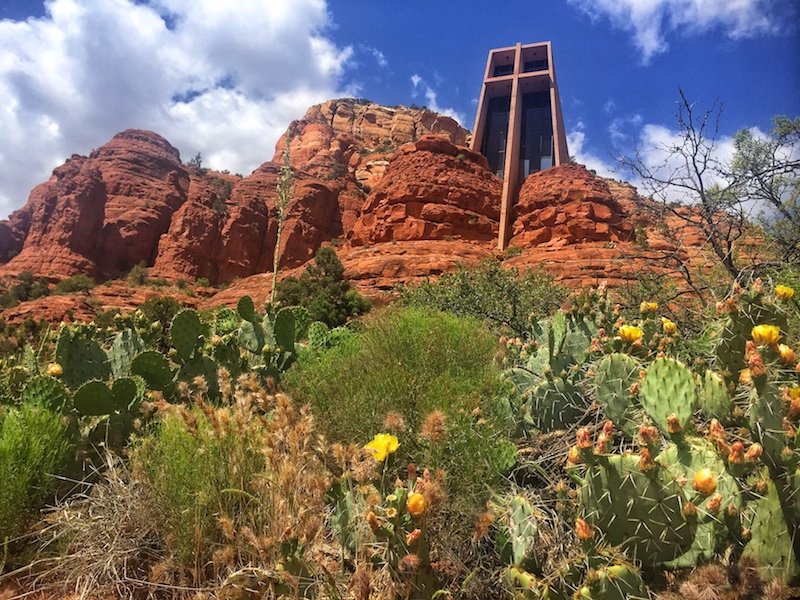
The only place in Arizona that the North Rim is easily accessible to is Page, AZ, which is right at the Utah border.
In fact, the North Rim of the Grand Canyon pairs way better with a Utah National Parks itinerary than an Arizona road trip itinerary!
If you were to do that, I would sandwich it between Bryce Canyon National Park and Zion National Park to minimize your backtracking.

… You want lots of activity options.
There are so many things you can do at the South Rim of the Grand Canyon, including a ton of tour options and fun additional activities you can add to your trip.
Helicopter ride? Those leave right from Grand Canyon Village and there are more helicopter tour companies than you can shake a stick at.
(And if you can afford it, do it — I did a helicopter tour over the Grand Canyon from Las Vegas, and it’s one of my top 5 travel experiences of my entire lifetime).
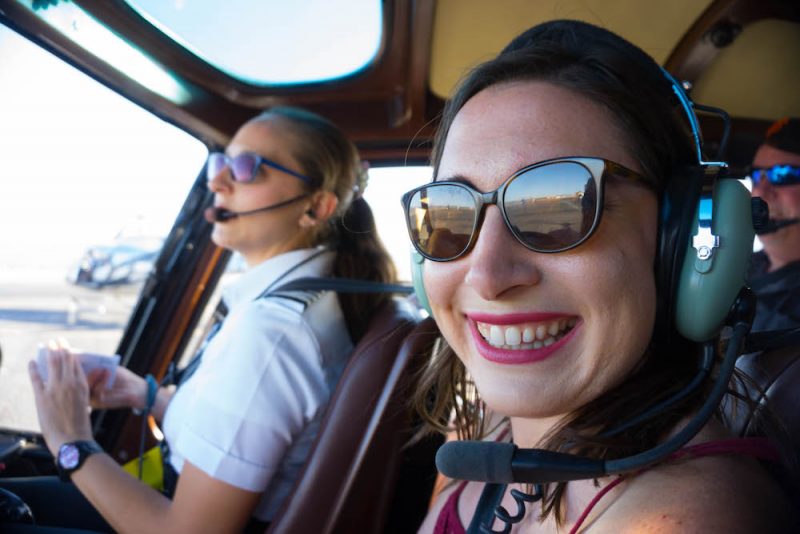
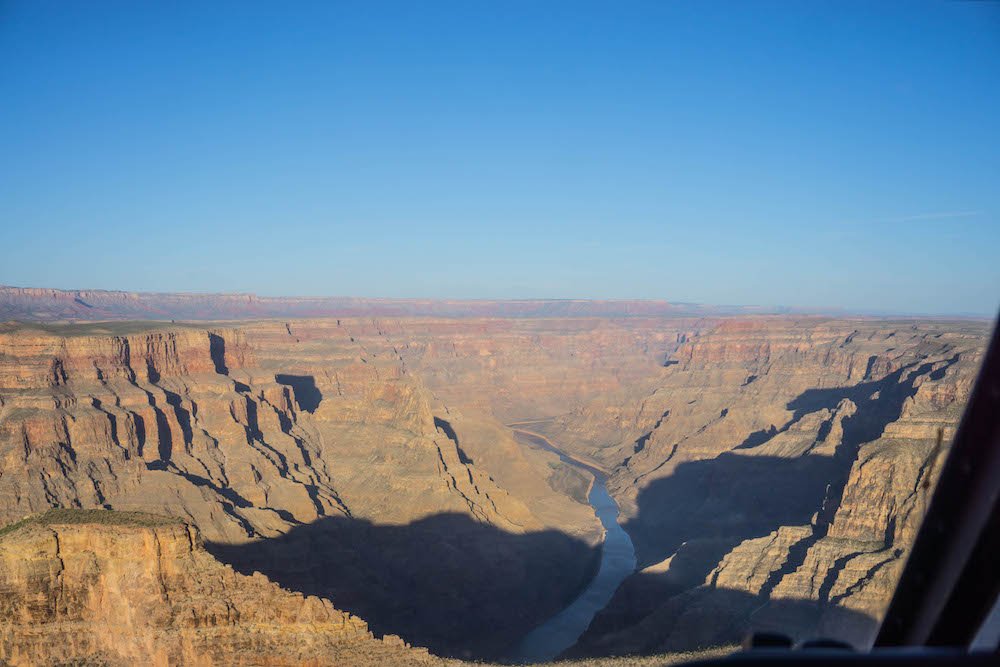
Small scenic plane tour? Yup, they have those too!
They cover the Zuni Corridor, Point Imperial, the confluence of the Colorado and Little Colorado Rivers, and even points on the North Rim such as Point Imperial, the Kaibab Plateau, and Kaibab National Forest.
Pink Jeep Tour? Absolutely! Pink Jeep Tours is one of my favorite tour companies (I’ve used them in both Las Vegas’s Valley of Fire and in Sedona) and they offer incredible sightseeing tours right from the South Rim.
I didn’t get a chance to do a Pink Jeep Tour on my trip to the Grand Canyon’s South Rim, but I wish I had. Judging from past experience, it’s a great way to see the Grand Canyon through rose-colored glasses!
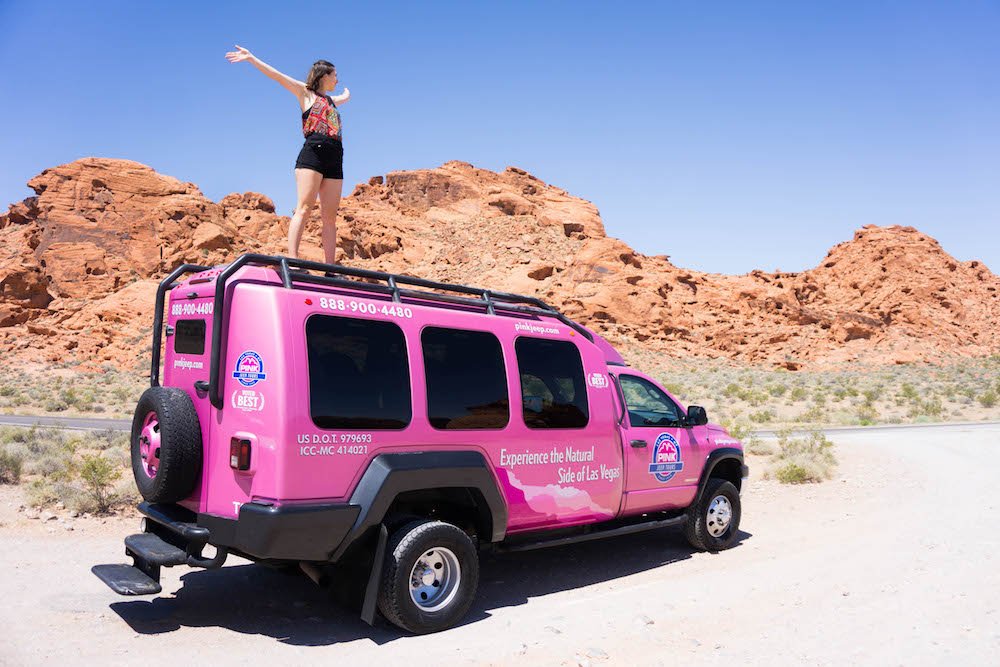
And these are but three of the many great Grand Canyon activities leaving from the South Rim.
Below are a few other select activities! The below tours leave from Tusayan and Williams, two spots near Grand Canyon Village.
… You are planning at the last minute.
Because the South Rim is so much more accessible and built-up than the North Rim, it’s not a problem at all to plan at the last minute.
If you want accommodations at the North Rim, you have one option inside the park, one option just outside it, one campground, and then a whole lot of nothing until you reach Jacob Lake one hour away (and there’s not much there, either).
If you are visiting the South Rim at the last minute, you don’t really have to worry because there are dozens of great vacation rentals near the Grand Canyon, plus abundant options in Williams and even Flagstaff.
The main lodges will likely be booked up well in advance at the South Rim, but I was even able to find campsites at Mather Campground (the big South Rim campground) open with just one-week advance booking in the middle of July, peak season!
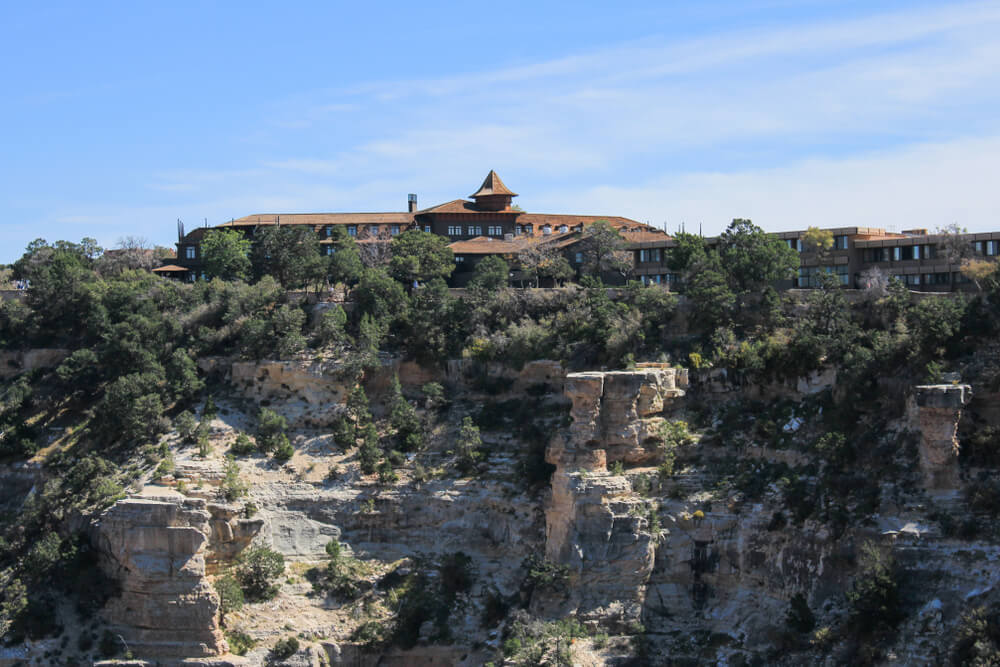
Things to Do at the South Rim of the Grand Canyon
Walk some (or all of!) the Rim Trail.
The Rim Trail is a mostly-paved, easy trail that stretches between the South Kaibab Trail (which you can take into the canyon) all the way west to Hermits Rest.
The Rim Trail offers 13 miles of paved trail, but you can do any fraction of it and return via shuttle bus at any of the designated stops, so it’s easy to tailor to your own preferences and abilities.
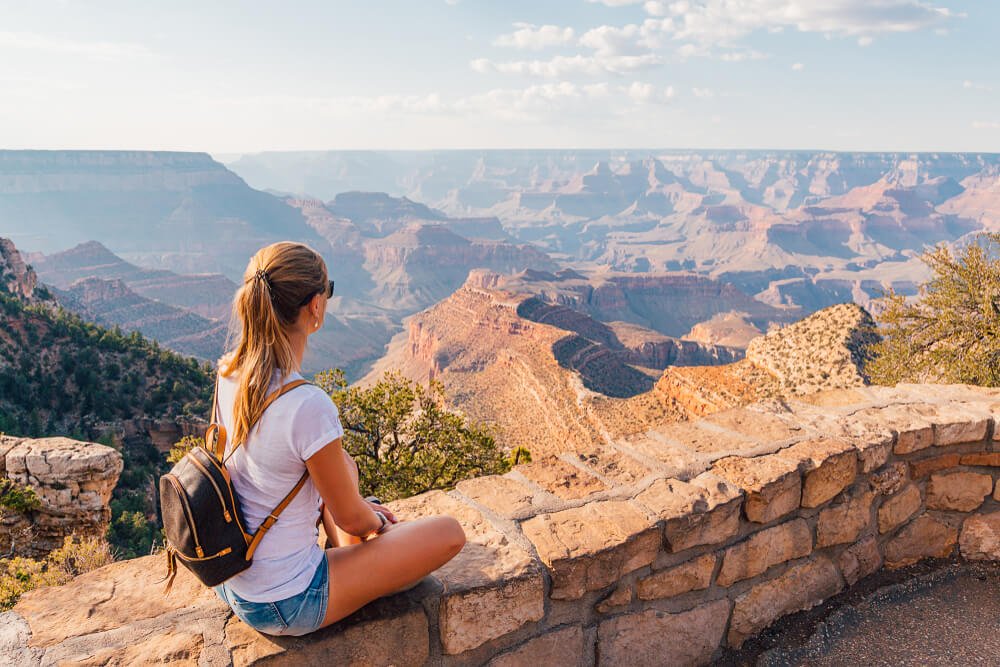
Take one of the many day hikes available.
The South Rim of the Grand Canyon has a ton of fantastic day hikes you can do — including short hikes into the canyon.
No need to sweat the Rim to Rim hike — there are plenty of in-between options!
Here are 5 of my favorite South Rim hikes including very short options that take about 1-2 hours to complete and can be done by total beginners.
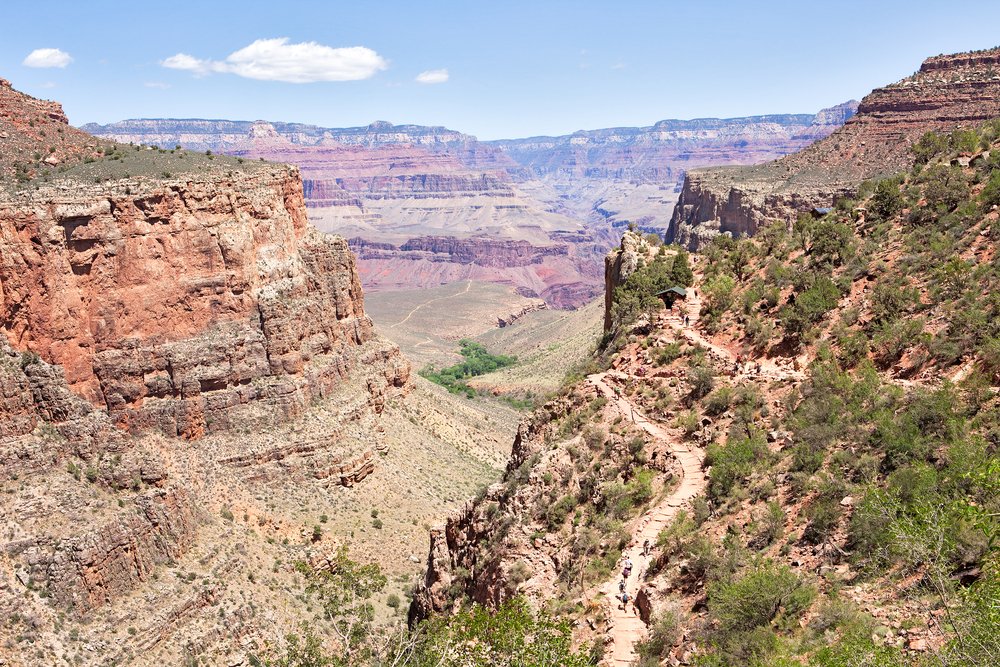
Take a tough descent to Skeleton Point and back.
The South Kaibab Trail will take you all the way into the belly of the beast, but there are plenty of stop and turn-around points that make your hike in the Grand Canyon a lot less cumbersome.
The hike on the South Kaibab Trail to Skeleton Point and back is a great 6-mile hike that’s hard but not insane. Keep in mind the 2,000+ feet of elevation gain (and loss) when considering this hike!
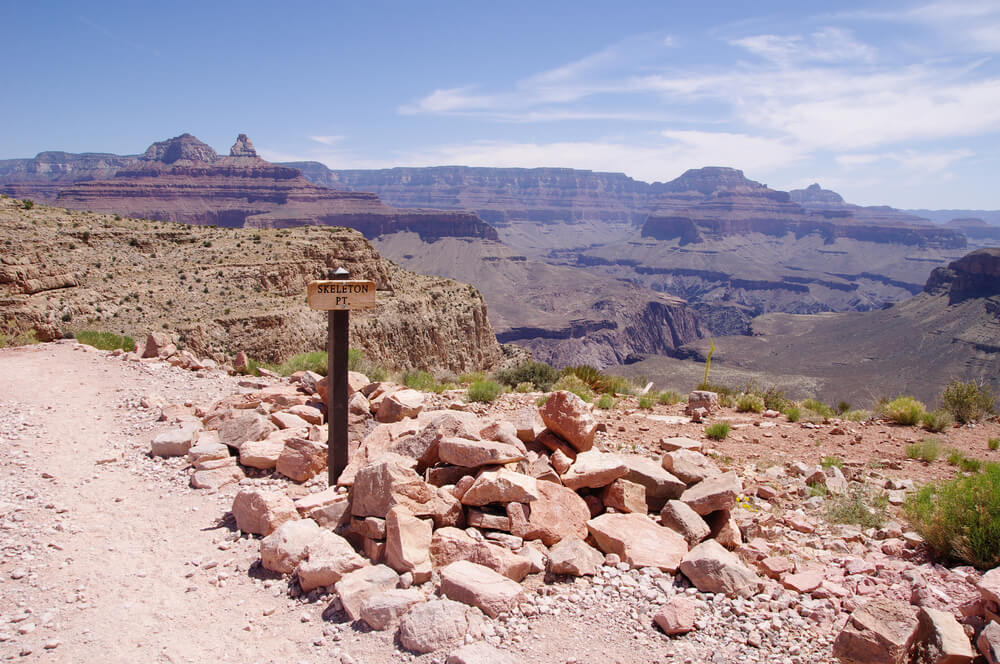
Check out the Desert View Watchtower.
Take the Desert View Drive 23 miles between Grand Canyon Village and the small settlement of Desert View for a beautiful drive.
It’s also home to a really cool viewpoint on the South Rim of the Grand Canyon!
Note that the Desert View Watchtower itself is currently closed due to the pandemic; however, it’s still well worth visiting for its beauty and the gorgeous drive to get there!
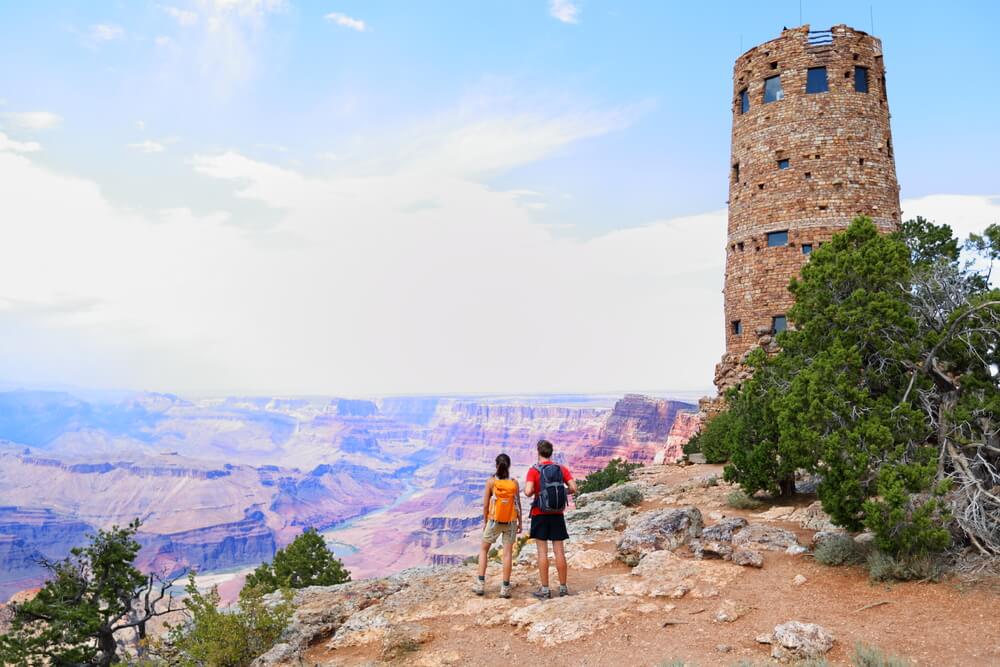
How to Get to the South Rim of the Grand Canyon
Williams, Arizona is a great gateway to the Grand Canyon!
Here is where you’ll find the historic and scenic Grand Canyon railway, which is one hell of a way to make an entrance to the South Rim!
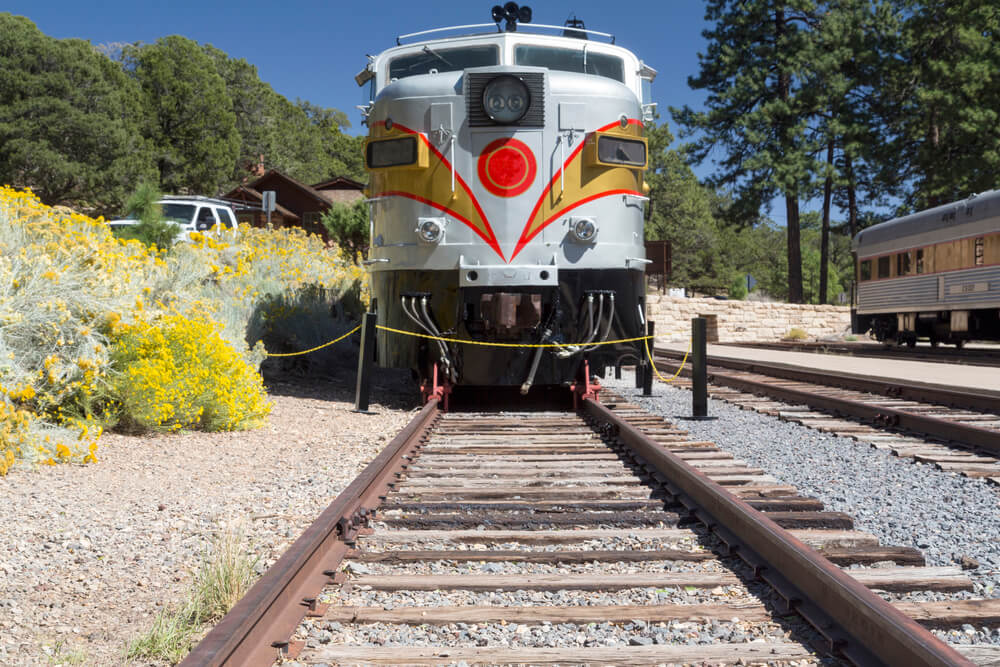
Driving into the South Rim is also totally possible. You can come in via Las Vegas or via Flagstaff, depending on your trip itinerary.
From Vegas, you’ll take I-11 to the Hoover Dam, where you can check out one of the coolest marvels of engineering in the United States.
Did you know that the concrete in the middle of the Hoover Dam is still not dry nearly 100 years later?
You can also walk — on foot! — between Nevada and Arizona.
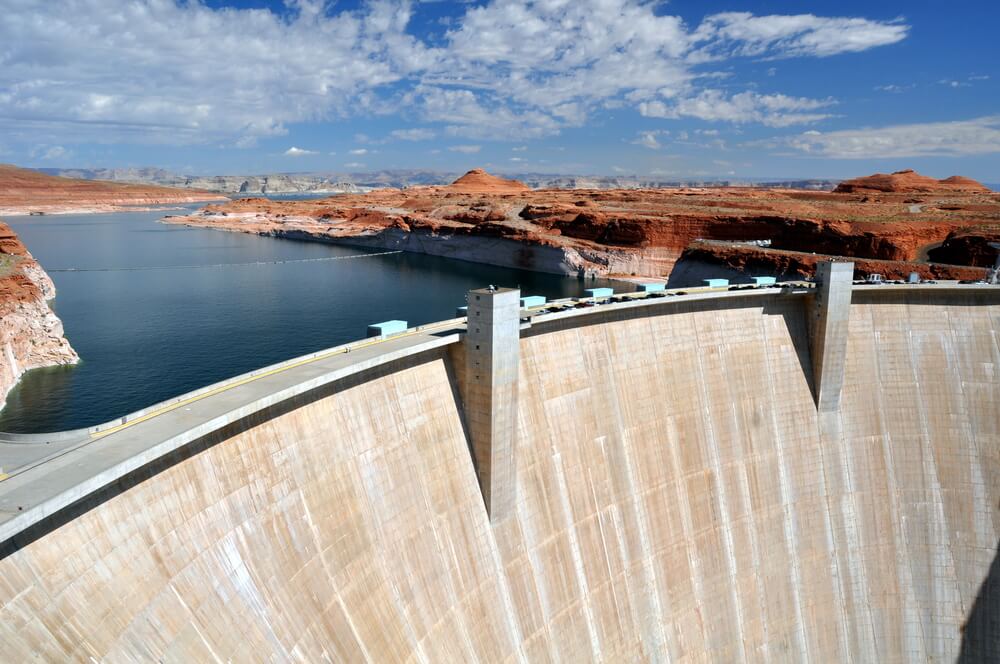
Then you can continue along Highway 93 into Arizona, then turn onto I-40 / Route 66 in Kingman, Arizona.
Take that to Williams, AZ, where you’ll turn onto Highway 64, which brings you right to the Grand Canyon.
If coming from Tucson, Phoenix, Sedona, or any point south in Arizona, first make your way to Flagstaff (likely via I-17)
Then, take either I-40 / Route 66 to Williams then up to Highway 64, or alternately take Highway 180 up to Grand Canyon Junction and then onto Highway 64 to Grand Canyon Village and the South Rim Visitor Center.
What about the Grand Canyon West Rim?
I would advise against it, personally, in favor of the North or the South Rim.
Yes, there is the Grand Canyon Skywalk attraction, which is $23 per person plus park admission.
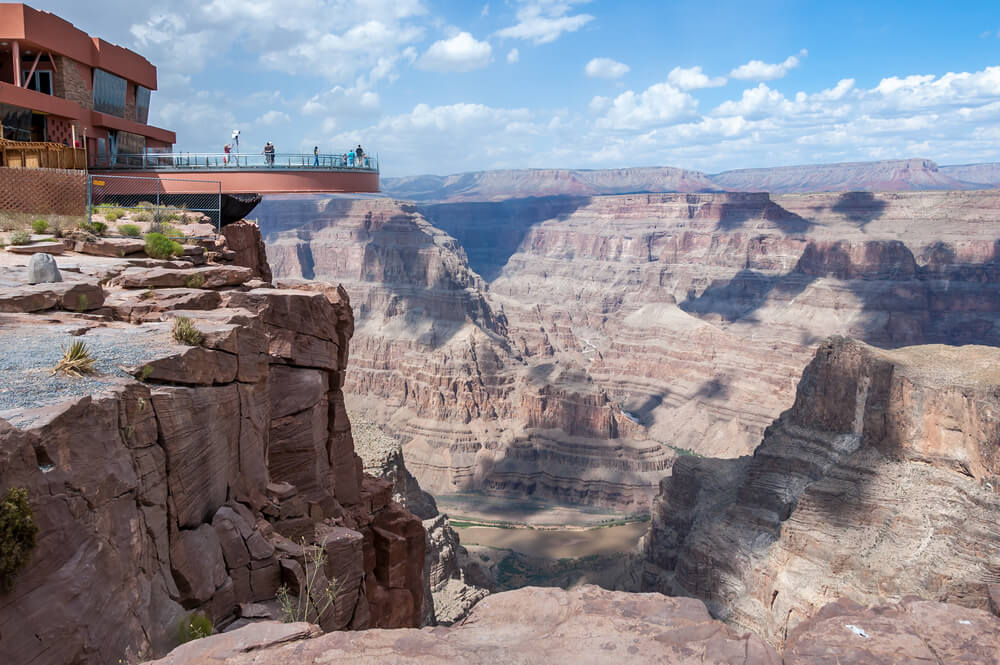
Other than that there is not too much to see compared to North and South Rims (though there are a few other viewpoints, which you can check out more information on here.)
Plus, it has a separate $45 per person admission fee, as the site is not on national park land, but rather it is owned and operated by the Hualapai Native American tribe. That means your America the Beautiful pass will not apply, either.
In favor of it, I will say that it is beautiful, and it’s convenient if you are coming from Las Vegas, as it’s only a 2-hour, 15-minute drive (and hence it is a popular Vegas day trip!).
It’s also a popular option for small group rafting trips which can be organized to depart from here.
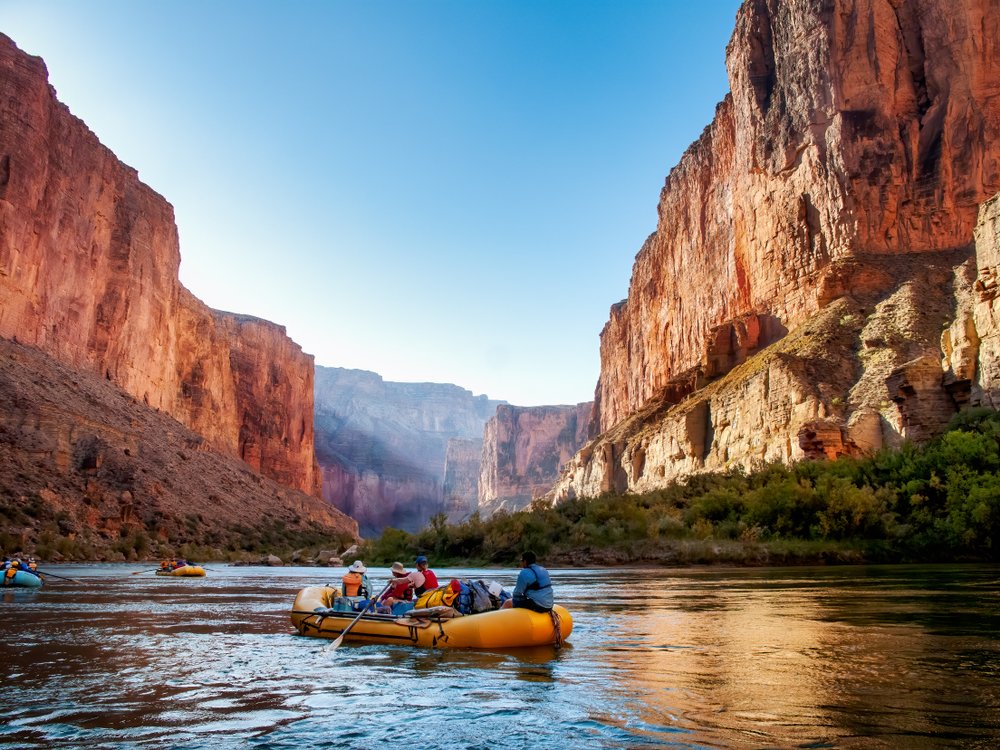
It’s a great option if you are coming from Vegas on a day trip and that’s all the time you have for the Grand Canyon. If you want an organized day tour, this is an affordable and easy one that has to option to add the Skywalk.
But if you have more time, I’d offer that you should pick either the South Rim or the North Rim, especially if it’s your first time at the Grand Canyon!
Pick Both if…
… You are visiting both Arizona and Utah and have plenty of time.
There is no reason not to visit both the North and the South Rim!
I am writing this guide targeting people who want to choose between the North Rim or the South Rim, but there’s no law saying you have to visit just one.
If your road trip encompasses both Arizona destinations and Utah destinations, it’s pretty easy to visit both sides without a lot of backtracking!
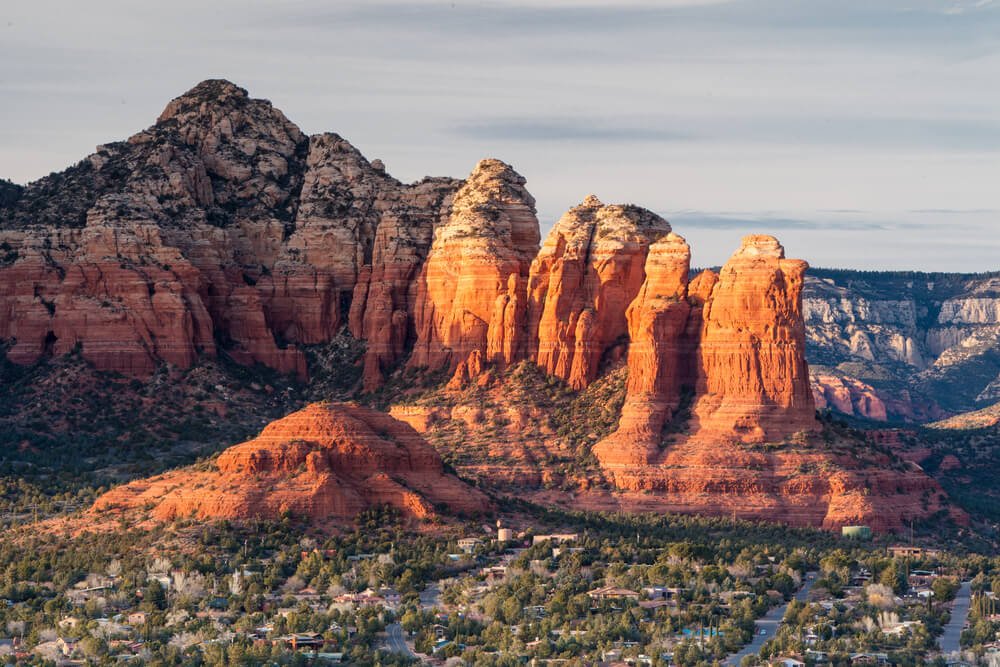
If you want to visit both, this is how I would route it: Nevada / Southern Arizona sights (Las Vegas, Tucson, Phoenix) –> Sedona –> Flagstaff –> South Rim –> Page –> North Rim –> Zion –> Bryce Canyon –> Other Utah National Parks (Capitol Reef, Arches/Canyonlands in Moab).
Obviously the same also works in reverse!
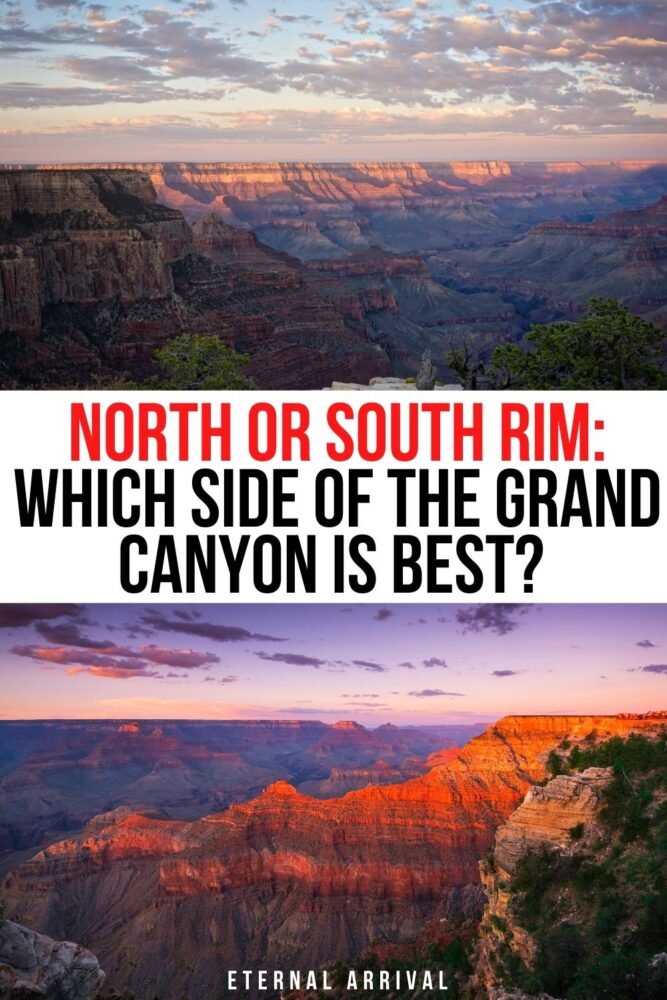
Allison Green is a former teacher who has been travel blogging since 2016. She has a Masters in Teaching and a B.A. in English and Creative Writing. Her blog posts merge her background as an educator with her experience traveling to 70+ countries to encourage ethical, meaningful travel. She has been a speaker at the World Travel Writers Conference and her writing, photography, and podcasting work has appeared in National Geographic, CNN Arabic, CBC Canada, and Forbes, amongst others. Now a full-time traveler, she has lived in Prague, Sofia, New York City, and the San Francisco Bay Area.

